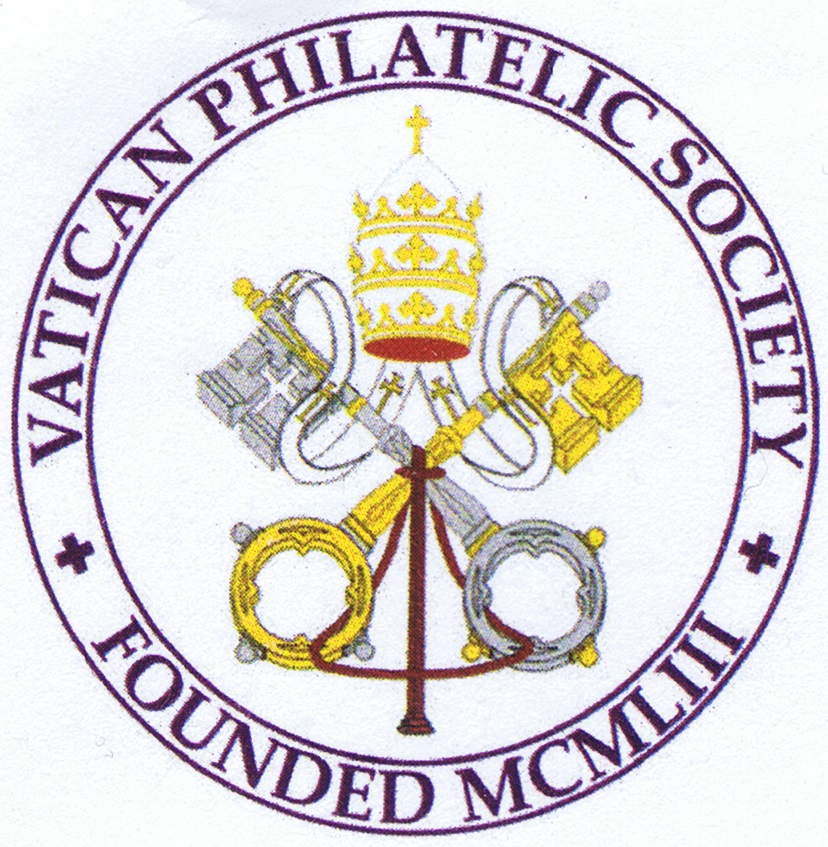
Member



The Lateran Pact
It was raining quite hard on the morning of February 11, 1929. Several automobiles containing Cardinal Gasparri and his party drove up to the Lateran Palace. The Pope's representatives entered the Hall of Constantine. At noon the representative of the King of Italy, Premier Mussolini and his party entered the hall and were greeted by the Papal representatives. After the exchange of cordialities, Cardinal Gasparri and Benito Mussolini signed the three documents that comprised the pact, with a gold pen sent by Pope Pius XI for the signing. In less than a half hour's time the treaty was signed with only a handful of high dignitaries of the Church and State being present. The bells of St. John Lateran pealed joyously as the signatures were affixed and a group of theological students chanted the "Te Deum" in the square below. The two dignitaries shook hands, congratulating one another and departed. The Roman Question had been answered! The Lateran Treaty (so named because it was signed at the Lateran Palace) created the tiniest nation in the world, the State of Vatican City, and re-established the Pope's sovereignty and independence. The treaty further states that the Italian government would have Catholicism as its only state religion, recognize the Vatican territory as neutral and inviolable, change Civil Laws that conflicted with Canon Law, and make Catholicism compulsory in the schools.
Other provisions of the documents provided that the Italian government would build a railroad station in the Vatican and establish direct communications with other states, including a postal service. The right to send and receive diplomatic representatives to foreign countries also was agreed to according to international law.
Immunities were granted to church dignitaries, and officials for the territory outside the Vatican proper, as well as the parcels of land themselves. A working agreement was also reached to protect the Vatican and provide for the apprehension and extradition of criminals and fugitives.
The Lateran Pact also stipulated that an indemnity of 750,000,000 lire in cash and 1,000,000,000 lire in Italian interest-bearing bonds was to be paid the Vatican for the loss of temporal power in 1870. Though the treaty was signed on February 11th, it did not go into effect until noon of June 7th. At that time the government of the new state began to function, Swiss Guards took their posts at the new boundaries of the Vatican state and rolled back the bronze doors of the Vatican Palace that had been closed since the fall of Rome in September, 1870. The Pontiff was a Prisoner of the Vatican no longer.
To commemorate this important treaty, the Vatican Postal Administration released a set of two stamps depicting Pope Pius XI and a view of Vatican City. The stamps were placed on sale on February 12, 1954, to mark the silver anniversary of the signing. The stamps could not be released on the actual anniversary date as it was a Holiday and the post office was closed. Italy also marked the signing of the Lateran Pact with a set of two stamps depicting the Lateran Palace where the treaty was signed.
Technical Details:
Scott Catalogue - 174 - 175
Date Issued - 12 February 1954
Face Value - 25 l, 60 l
Perforations - 13
Printer - The Italian State Printing Works
(Author - Unknown, )

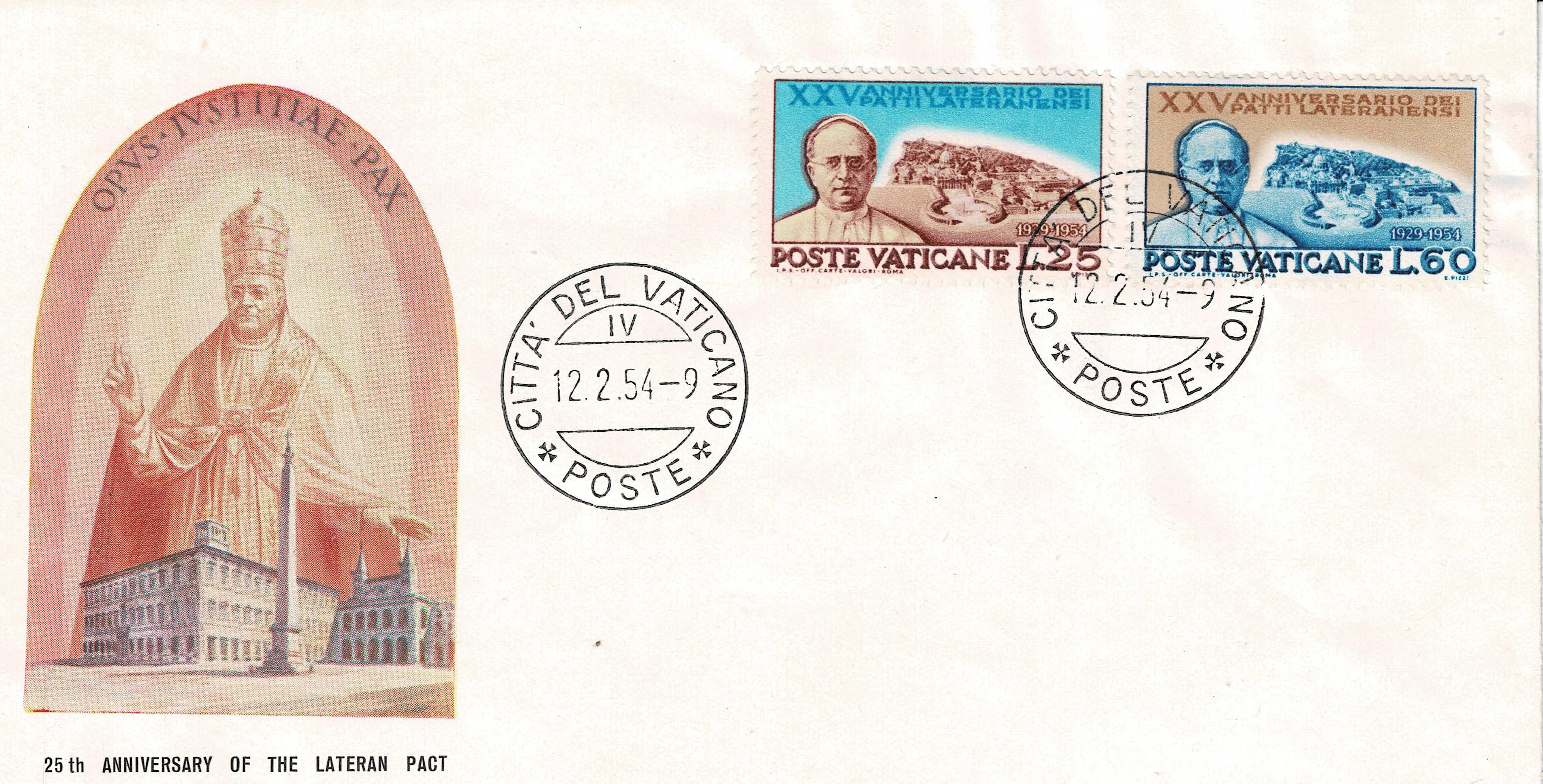






The Marian Year
Pope Pius IX (3, 6, and 20 lire stamps) was born on May 13, 1792 of noble parents in Senigallia and baptized Giovanni Maria Mastai-Ferretti. As a young lad he knelt before the highly venerated picture of Our Lady in the Cathedral of Senigallia and consecrated his life to the glory of God and to dedicate his virginity to her.
At the age of ten years, young Giovanni made his first Holy Communion on Feb. 2, 1803, the feast of the Purification, in the Cathedral where he was baptized. A year later he entered the College of the Scolopi, at Volterra, to begin his studies. While attending this school the first sign of epilepsy appeared and threatened to render his ordination as a priest of God impossible. In 1809, he entered the Roman College to study theology, philosophy, and the classics. In 1815, on the feast of the Annunciation, he enrolled in the Senior Marian Sodality of the Roman College. On April 10, 1819, young Giovanni was ordained a priest, thus beginning a new life that was to end in the Chair of Peter.
His life as a priest saw the future Pope Pius IX spend his first four years with youth. He was then sent by the Holy Father to South America to serve as Auditor to the Apostolic Delegate, Monsignor Muzzi. In 1825, he was appointed by Pope Leo XII as Arch-bishop of Spoleto. Seven years later the successor to Leo XII, Pope Gregory XVI transferred him to the larger dioceses of Imola. In 1839, Archbishop Mastai-Ferretti was bestowed with the red hat of Cardinal.
Pope Gregory XVI died on June 1, 1846, and Cardinal Mastai departed from his See to attend the Conclave in Rome. At Fossombrone a white dove alighted on the carriage and stayed there until it arrived at the gates of Rome, as if a sign to the people that the Cardinal was to be the next Vicar of Christ. Fifteen days later he became Pope Pius IX. Upon assuming the Throne of Peter, Pius IX set up a commission of Cardinals and theologians to study the belief generally accepted of the Immaculate Conception. On Feb. 2, 1849, he took a step further and invited the bishops of the entire Catholic Church to freely express their views on proclaiming the Immaculate Conception an infallible Dogma through his Encyclical, Ubi Prium. Of the 593 expressions given, only four were against the proclamation. As a result of this poll, Pope Pius IX convened a secret consistory on December 1, 1854. He then asked the assembled Cardinals, "Is it then your pleasure that we utter the dogmatic decree on the Immaculate Conception of the Blessed Virgin Mary?" The Cardinals unanimously agreed and the reigning Pontiff set Dec. 8, 1854 as the day of the promulgation of the Dogma of the Immaculate Conception.
On the morning of Dec. 8, 1854, the Solemn Pontifical Mass in St. Peter's Basilica began. After the singing of the Gospel the Holy Father stood on the steps of his throne surrounded by a vast retinue of Cardinals and bishops and solemnly sanctioned, "that the doctrine, which holds that the Most Blessed Virgin Mary at the first moment of her conception was, by singular grace and privilege of the Omnipotent God, in virtue of the merits of Jesus Christ, Savior of the Human race, preserved from all stains of original sin, is revealed by God, and therefore, to be firmly and resolutely by all the faithful." After the solemn definition of the Immaculate Conception had been decreed the crowds cheered wildly and shouted "Viva Mary Immaculate." The cannon of Castel St. Angelo saluted as the bells of the churches of Rome tolled to announce the Dogma of the Immaculate Conception.
When the Mass was over Pope Pius IX blessed a golden crown studded with jewels. He then was borne on his portable throne to the Chapel of Sixtus IV where he placed the crown on a statue of Mary.
Like his predecessor, Pope Pius XII (4, 12, and 35 lire stamps) is also. dedicated to the Mother of God. At baptism he received the name of Mary as his first middle name. When he was ordained a priest he said his first Mass in one of the chapels of St. Mary Major, the most prominent basilica in Rome dedicated to the Blessed Virgin.
On Oct. 30, 1950, the Holy Father was taking his afternoon walk in the Vatican Gardens. At 4 o'clock, as he turned his gaze from the gardens to the sun, he saw a vision of the Mother of God in the rays of the sun. The following afternoon Mary again appeared to the Pope at the same time. The next day, Nov. 1, 1950, Pope Pills XII gave to the Catholic Church the second important Dogma of Mary, the Dogma of the Assumption. As if to show her approval for the solemn definition of the assumption of Her body and soul into heaven, Mary appeared again to the Pontiff that afternoon at the same time as the previous days as he strolled in the gardens.
On Sept. 8, 1953, the feast of the Nativity of the Blessed Virgin, Pope Pius XII called upon the faithful to join in the observance of the Marian Year which he decreed through his Encyclical, Fulgens Corona Gloriae. The Marian Year, the first year dedicated to the Mother of God in the Annals of the Catholic Church, was decreed to extend from Dec. 8, 1953 to Dec. 8, 1954, to mark the centenary of the Dogma of the Immaculate Conception.
On Dec. 8, 1953, Pope Pius XII left the Vatican and drove through downtown Rome for the first time since the end of World War II. In the Piazza di Spagna, at the foot of the Spanish Steps, the czar came to a halt. The Pontiff placed a bouquet of flowers at the column commemorating the Immaculate Conception. Then he was driven to the Basilica of St. Mary Major to preside at the ceremonies inaugurating the Marian Year.
The Holy Father entered the church under a canopy of velvet and damask as the choir sang the triumphant "T u es Petrus." With members of the Catholic Action group he recited the special Marian Year prayer he had written. This marked the beginning of the Marian Year.
On May 26, 1954, a set of six stamps was issued to mark the Marian Year Two major designs were used for the motifs of the stamps. The first was an effigy of Pope Pius IX, who proclaimed the Dogma of the Immaculate Conception. The second design features the reigning Pontiff, Pope Pius XII who promulgated the Marian Year to mark the centenary of this important Dogma of the Mother of God.
Technical Details:
Scott Catalogue - 176 - 181
Date Issued - 26 May 1954
Face Value - 3 l, 4 l, 6 l, €1.25, 12 l, 20 l, 35 l
Perforations - 13
Printer - The Italian State Printing Works
(Author - Unknown, )





Canonization of Pope Pius X
"This hour of splendid triumph—as God, Who lifts up the lowly has arranged and as it were hastened in order to set His seal on the marvelous elevation of His faithful servant Pius X, to the supreme glory of the altars . . ." With these words Pope Pius XII solemnly proclaimed Blessed Pius X as the 4,374th saint of the Catholic Church, on May 29, 1954.
The following morning the pontifical canonization Mass was said by Eugene Cardinal Tisserant, dean of the Sacred College of Cardinals and presided over by Pope Pius XII. Before the main altar a special platform held the remains of the newly pronounced saint in a glass and gold casket throughout the ceremonies. In a prominent place the relatives of the first Pope to be canonized in 242 years heard the Mass marking the elevation of Pius X to sainthood. An important place also was given to the two people whose miraculous cures through the intercession of Blessed Pius X made the canonization possible, Sister Maria Luisa Scorcia of the Daughters of Charity of St. Vincent de Paul, and the Neapolitan lawyer, Francesco Belsani. When the Mass was concluded, Pius XII was carried out of the basilica among the crowd of over half a million who were assembled in the Square. He constantly gave them his blessing and then appeared on the balcony where the crowds were better able to see him.
That afternoon the remains of St. Pius X were placed on an elegant old Berlin carriage drawn by six white horses. The long procession in honor of the newly proclaimed saint escorted the carriage across the city of Rome to the basilica of St. Mary Major, where the casket was exposed to the faithful.
We already have noted the reasons for the Beatification of Pius X, but what is canonization? Canonization Is the next and supreme step in pronouncing a person to be in Heaven. All that is necessary to make the step from Beatification where the person is bestowed with the title of "Blessed" and Canonization where he is conferred with the title of "Saint" are two miracles. These miracles must occur after the beatification. They then are submitted to a vote of the Sacred College of Cardinals and certain other prelates in a semi-public consistory.
Canonization places the final seal of approval of the Church on the asserted sanctity of a person. While beatification only permitted veneration of Pius X on a very limited scale, his canonization declared he actually is in heaven and the faithful are ordered to venerate him throughout the entire Catholic Church.
Technical Details:
Scott Catalogue - 182 - 184
Date Issued - 29 May 1954
Face Value - 10 l, 25 l, 35 l
Perforations - 13
Printer - The Italian State Printing Works
(Author - William Wonneberger, Jr., )




Basilica of St. Francis of Assisi
Giovanni Francesco Bernardone, more commonly known as St. Francis of Assisi, was born in 1182. Even though his father was a wealthy merchant he seems to have had little formal education. In his youth he enjoyed a life of pleasure and frivolity until he was captured in a battle between Perugia and Assisi in 1201. The imprisonment lasted a year in which time he fell ill with a dangerous fever. During this sickness Francis resolved to alter his way of living. When he returned to Assisi in 1202, Francis undertook works of charity among the lepers and worked diligently for the restoration of dilapidated churches. These pious undertakings did not please his father and as a result he legally disinherited him. Francis did not revert to his former habits but discarded his rich garments and went to the bishop who gave him a cloak. Upon receiving the garment, Francis went to the wooded Mount Subasio where he spent three years caring for outcasts and lepers. To provide for their spiritual needs he restored the chapel of Santa Maria degli Angeli.
During Mass one day he heard a call telling him to go out into the world and possess nothing but do good everywhere. Answering this call, Francis returned to Assisi where he began preaching to the people. While preaching the word of God he gathered a group of 12 men who, in 1209, became the original brothers in his order of friars and they elected him as their superior.
Three years later he invested St. Clare ( Scott #169-70 ), and through her founded the second order of Franciscans that was to be known as the Poor Clares.
Many difficulties prevented him from accomplishing much missionary work during the next seven years. While in Egypt, in 1219, he was taken prisoner at Damietta. When he was brought before the Sultan he told him of God. So moving were his sermons that he was returned to the Christian lines. Francis then journeyed to the Holy Land where he stayed for about a year.
In 1220 he returned home and spent the next few years organizing the third order of Franciscans that were to be known as the Tertiaries. While praying, Francis was often favored with visions of Christ and the Blessed Virgin. The most remarkable of these occurred in September 1224. After fasting for forty days, he was praying on Mount Alverno when he suddenly felt pain mingled with joy; Christ has impressed the marks of His Crucifixion on his body. So severe was the accompanying pain that Francis had to be carried back to Assisi. His hard work and privations so ruined his health that he suffered severe pain and almost total blindness for the remainder of his life. On October 3, 1226, as Francis was preparing to join His Maker, he requested that he be buried on the 'Hill of Hell', the most despised place in Assisi that served as an execution and burial ground for condemned criminals.
Shortly after his death, the Vicar of the Order of Friars Minor, Brother Elias, deemed it a fitting tribute to erect a church over his grave. On July 17, 1228, the day after St. Francis was canonized, Pope Gregory IX laid the corner stone of the church and ordered that in the future the site be known as, " The Hill of Paradise ". The people were so moved by St. Francis' devotion to God that they freely donated their money and time thereby completing the lower church in the short space of twenty-two months.
The design of the lower church was entrusted to Jacopo Tedesco who was succeeded by Filippo da Campello in 1232 as the architect in charge. Originally the church consisted of a nave and four bays with groined vaulted walls supported by wide circular arches: a transept on the west; and a semi-circular apse. About the year 1300, the eastern transept was added as well as the Gothic chapels. During the fifteenth century a vestibule was added and the church was richly decorated by men of great renown in the history of art, including Giotto, Giottene, Simone Martini and Pietro Lorenzetti.
The upper church was begun about ten years after the completion of the lower church. The church, in the shape of a Latin cross, was the work of non-Italian architects at a time when its Gothic style was foreign to Italy. Among its many frescos are twenty-eight scenes from the life of St. Francis attributed to Giotto and his contemporaries. The upper church was completed in 1253 and on June 11th of the same year it was solemnly consecrated by Pope Innocent IV.
Upon the death of St. Francis, Brother Elias, fearing that the body would be stolen, hid the tomb of the saint in the lower church. The exact location of the tomb remained unknown until an intense search lead to its discovery in 1818. The remains of St. Francis were exhumed and placed in the crypt, a relatively small area, with two altars back to back, one higher than the other, so that both were over the tomb.
On March 23, 1764, Pope Benedict XIV issued the Papal Bull, ' Fidelis Dominus ', thereby elevating the church to the rank and honor of " Basilica Patriarchalis et Capella Papalis ". By attaining the rank of Patriarchal Basilica, The altar facing the papal throne became a papal altar; that is, an altar at which no one but the pope, or one delegated by the pope, may celebrate Mass.
To commemorate the second centenary of the elevation of the Basilica of St. Francis to the rank of Patriarchal Basilica the Vatican Postal Administration released a set of two commemoratives on Oct. 1, 1954. The stamps were the work of P. G. Lerario, of the Order of Friars Minor. They were released in post Office sheets of 40 stamps and were printed at the State Printing Office, Rome, by the photogravure method.
The design depicts a view of the Basilica of St. Francis. To the right of the church is a symbol of Basilican dignity, a bi-colored semi-opened umbrella. This was originally the emblem of the Imperial rank of Constantinople. It was adopted by the Church and today is restricted to Patriarchal Basilicas. In processions it is carried in front of the Canons of that particular Basilica.
Technical Details:
Scott Catalogue - 185 - 186
Date Issued - 01 October 1954
Face Value - 20 l, 35 l
Perforations - 14
Printer - The Italian State Printing Works
(Author - Unknown, From Vatican Notes Volume VIII, Number 2, Pages 7-9, 1959)



St. Augustine Of Hippo
"Take and read, take and read", the voice of a child cried out. From where, Augustine did not know as he sat under the fig tree in despair. Again the voice cried out, "Take and read", and as if his hands were guided by an invisible power he opened the Epistle of St. Paul to the passage: " Not in rioting and drunkenness, not in chambering and impurities, not in contention and envy, but put ye on the Lord Jesus Christ and make no provision for the Flesh in its concupiscenes". Augustine had no need to read further, in this one quotation he had seen the error of his ways. With this scene was born one of the greatest saints of the Roman Catholic Church, St. Augustine of Hippo.
But what of the early life of Augustine? He was born of a Christian mother, Monica, and a pagan father, Patricius, in Tagaste, Numidia, now Tunisia, on November 13, 354. His early life was one of violent passions and brilliant talents. He had received a Christian education, though he wasn't baptized. At the age of 17 he went to Carthage to complete his studies. While attending school at this center of learning he embraced Manichaeism and became an ardent disciple for nine years. Upon completing his education, Augustine went to Rome where he planned to begin a school of his own. A year later he was appointed professor of rhetoric to the court of Milan by the prefect of Rome. During his stay in Milan, he met the Bishop of the city, St. Ambrose. It was through his sermons that Augustine began to see the errors of Manichaeism and the good of Christianity. While recalling his reckless early life he went to his garden and tormented his mind as to which was the true religion. While sitting under the fig tree he heard the child's voice, "Take and read". On Easter Saturday in 387, Augustine went, with his mother who had journeyed to Milan to visit him, to the basilica of Milan where he was baptized by St. Ambrose. The following year Augustine and his small band journeyed to Ostia to depart for his home in Africa. The long journey, of over 350 miles, was too much for his elderly mother. She.had prayed all her life for the conversion of her son, and prayers had been answered as she joined her Maker. In 391, Augustine was ordained to the priesthood. Four years later he was consecrated bishop and in 396, appointed Bishop of Hippo.
Augustine was a powerful preacher and prolific writer. His nine years as a disciple of Manichaeism stood him well in refuting the doctrines of this heretical belief. He also engaged in long and bitter controversies defending the doctrines of the Church against the Donatists and Pelagianism. In the course of these debates, he wrote of sin, divine grace, divine sovereignty, and predestination which have since held an important place in the Roman Catholic Church. Probably his most famous and often-read work was the "Confessions". This was the story of his life written in 397. One of his greatest works was the "City of God", which was contained in twenty-two volumes. Ten of these books were devoted to refuting paganism and all it stands for, and the other twelve volumes trace the origin, progress, and destiny of two cities, one of God and the other of man, with the final triumph of the City of God which is the Church. These were not the only writings of Augustine. His works fill a surprising number of library shelves. Editors have accepted 363 sermons as genuine from a much greater number that bear his name. The studies of the remarkable life of this personality and his doctrines is practically endless.
So remarkable and thorough were his works that one thousand four hundred years later the future Cardinal Newman was brought into the Catholic Church through the writings of Augustine. He was not only the center of ecclesiastical life but his teachings dominated the entire Middle Ages and even today, theology.
The inexhaustible talents of this famous saint were not limited to preaching and writing. He introduced community life in his Episcopal See that is followed even today by many religious orders, the most prominent being the Augustines and the Dominicans. On August 28, 430, Augustine departed from this world to a new life in heaven. In 1295, Pope Boniface VIII declared him a doctor of the Church. The date of his death was proclaimed his feast day and is so celebrated throughout the universal Church. Vatican City has maintained a practice of honoring great saints on the anniversary of their death. This precedent was broken however when a set of two commemoratives, 35 Lire, and 50 Lire, was placed on sale on November 13, 1954, to mark the 16th Centenary of the Birth of St. Augustine of Hippo. The design of the stamps were executed by the noted Vatican designer, Edmondo Pizzi. Mr. Pizzi obtained his inspiration for the design from a painting by Botticelli, "St. Augustine in Meditation", in the Church of San Salvadore d'Ognissanti (All Saints) in Florence, Italy. Mr. Pizzi added an open book to the original with the wording, "Tolle Lege", (Take and Read) as well as the necessary wording and country identification.
This article first appeared in Vatican Notes Volume VIII, Number 2, Pages 11-12, in 1959. The original article can be accessed by clicking on the link below:
REFERENCE:




Madonna of Ostra Brama
To mark the termination of the Marian Year, the Vatican Postal Administration, at the suggestion of Polish Archbishop Joseph Gawlina, released a set of three stamps depicting the Madonna of Ostra Brame. This set not only paid tribute to the Mother of God, but to the Church in Silence behind the Iron Curtain where this famed painting is found.
The design of the stamps was executed by the eminent miniaturist, Casimira Dabrowska, who painted her beautiful miniature while residing in the land of her birth. When you realize how many beautiful paintings of the Blessed Virgin Mary are found in the Vatican Museums alone, you can readily understand why Miss Dabrowska stated, "...You can then realize how happy and proud I am of the great honor done to me and to my unfortunate country. "
The Madonna of Ostra Brama is located in the most eastern sanctuary in Europe, Vilna. 'In the early years of the 16th %. century, this town was protected by high walls pierced only by five heavily fortified gates. Above each of these gates, the townspeople placed a picture of their protectors. The southeast gate, the most exposed gate of all, was entrusted to the protection of Mary, the Mother of God. The painting placed over this gate is a little over nine feet high and 71/2 feet wide. Though the artist who painted the picture is unknown it is usually attributed to Fra Luca. It is claimed that he executed this masterpiece in Cracow at the end of the 15th century. The title of Madonna of Ostra Brame has its origin in the fact that it was erected over a spiked gate ( Ostra Brama ) studded with razor-sharp swords. Another story claims the translation of Ostra Brama to be sharp gate and claims this to be due to the fact that the street narrows to a point here.
The fame and miraculous powers of this painting soon spread throughout the area. The first documents of miracles obtained through the intercession of this image go back to the 17th century when Pope Clement XIV granted numerous indulgences to the pilgrims who gathered there to pray.
For protection, the painting was later moved to the inner side of the wall where a small chapel, approximately forty feet square, was erected by the Carmelites after they had assumed direction of the Church of St. Theresa nearby. They soon spread devotion to the Madonna of Ostra Brame throughout Poland and Lithuania where it was known as " Gate of the Dawn ". So renowned did this shrine become that many generous donations were received for its embellishment. A gold woven veil and a jewel bedecked gown were placed on the image. Over the head was placed two ornate gem-covered crowns to which was added a halo of rays and enshrined in the Church of St. Theresa. The following year the Apostolic Nuncio to Poland crowned the miraculous image amid a gathering of ranking Polish authorities.
The painting survived many battles of World War II. In 1942 a Communist soldier came to the shrine to place two large candles as votive lights to the memory of his departed parents. Later, it was discovered that the candles served as a disguise for two sticks of high explosives which were to be set off by the lighting of the candles. As Communist domination continued, they realized that the devotion to Our Lady was a threat to their hold on the people. In November of 1954 they ordered the famous Madonna moved to another church. The Shrine of the Madonna of Ostra Brama was then closed and the surrounding streets heavily patrolled to prevent any form of devotion.
Over the niche in the gate where this painting was enshrined, and at the bottom of the stamps is the inscription, " Master Misericordiae " ( Mother of Mercy ). This beginning of a short prayer must have the ending, " et pro nobis ", ( pray for us ) added many times by the oppressed people of Poland that they may again pray before the Shrine of the Madonna of Ostra Brama.
Technical Details:
Scott Catalogue - 189 - 191
Date Issued - 07 December 1954
Face Value - 20 l, 35 l, 60 l
Perforations - 13.25x12.75
Printer - The Italian State Printing Works
(Author - Unknown, From Vatican Notes Volume VIII, Number 6, Pages 11-12)








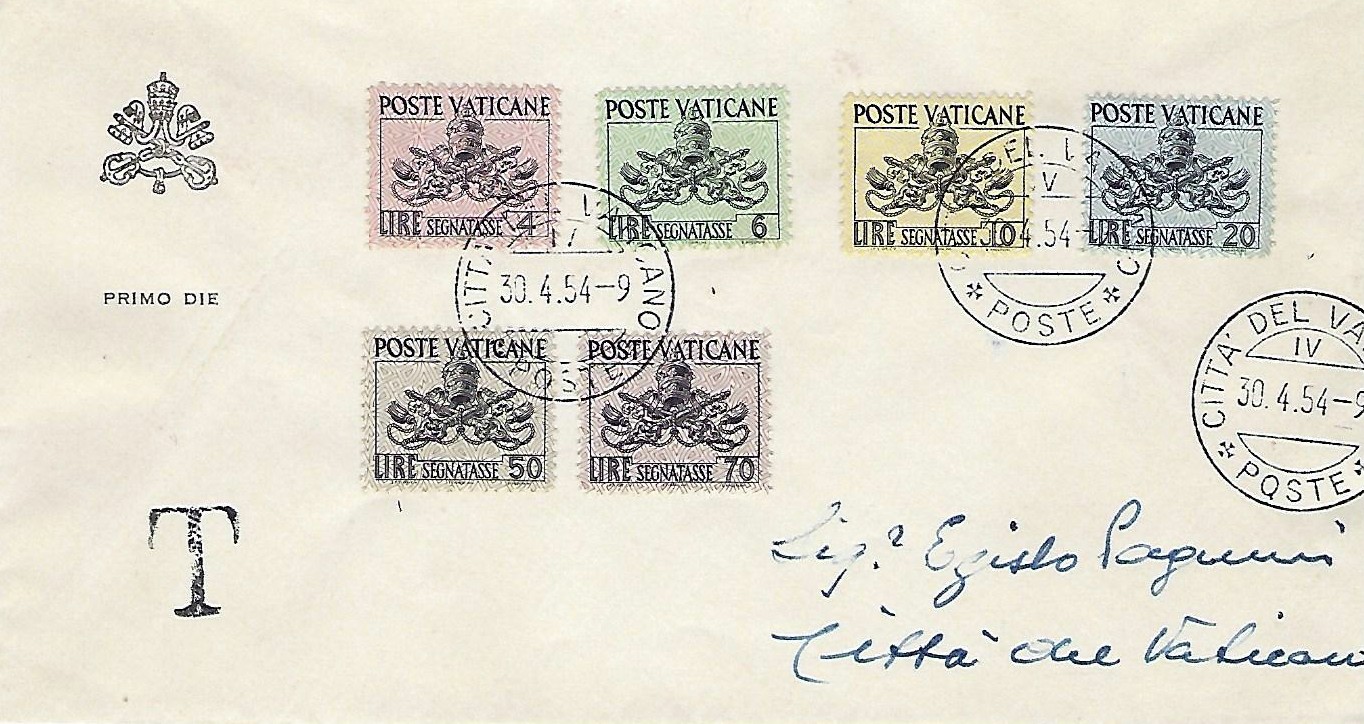
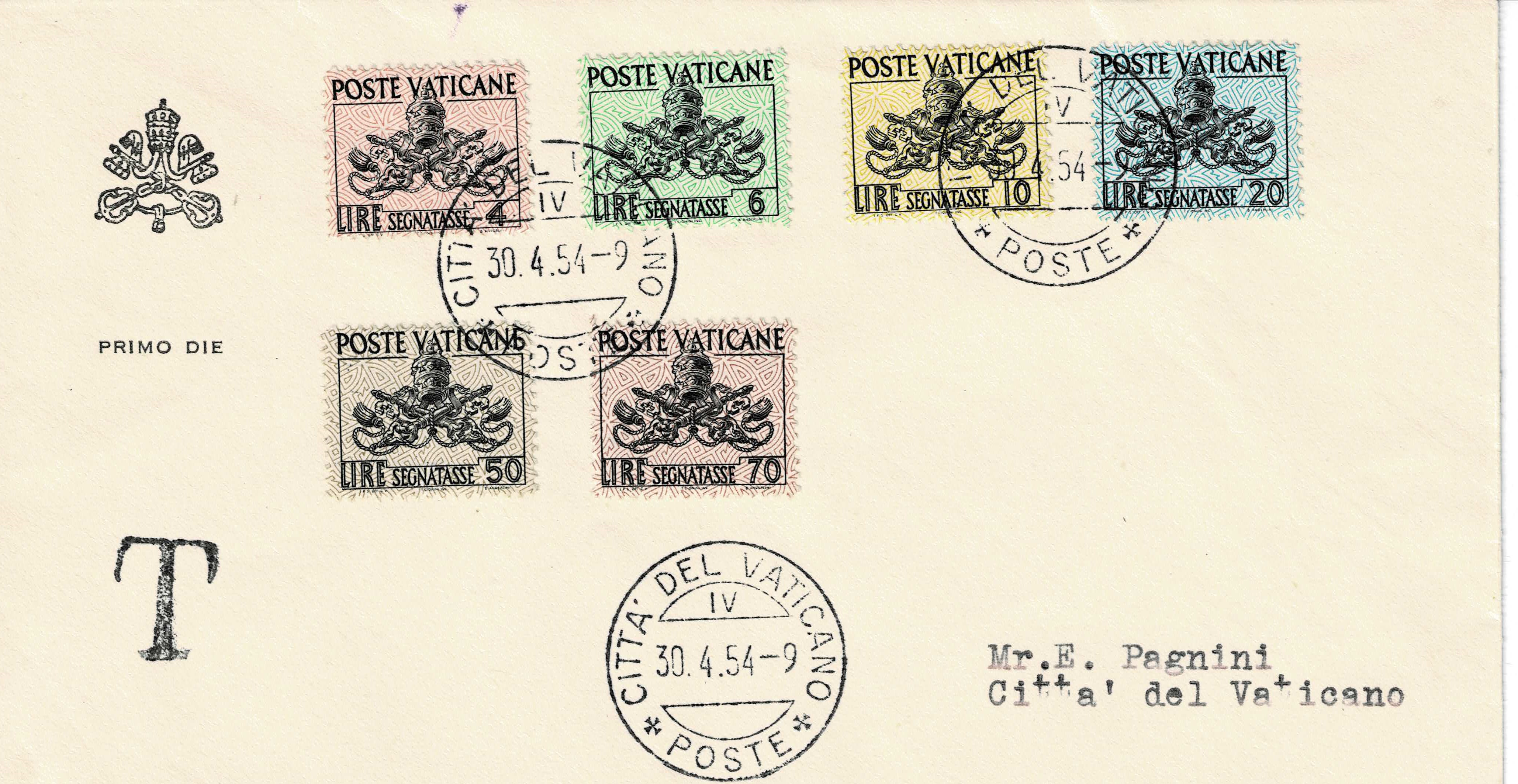


Fra Angelico
On June 27, 1955, the Vatican Postal Administration released a set of two commemoratives to mark the fifth centenary of the death of one of the world's greatest religious painters, Fra Angelico. Though the stamps have not been attributed to any particular designer, it might be said that they were designed by Fra Angelico himself as the design was taken from one of his most celebrated works in the Vatican.
The future Fra Angelico was born in 1387, in Vicchio, Province of Mugello, Tuscany. At baptism, he received the name of Guido, and as his father's name was Pietro, he was known as Guido ( or Guidolino ) di Pietro. Along with his younger brother, Guido entered the Dominican convent at Fiesole in 1407. Upon entering the convent, he adopted the name of Giovanni and has henceforth been known as Fra Giovanni da Fiesole. His younger brother became known as Fra Benedetto da Fiesole, ( or da Mugello ). Both brothers began their art careers about this time as illustrators and illuminators of missals and manuscripts. In 1409, Fra Giovanni and his brother journeyed to Foligino, Umbria, where the Dominicans had established a convent. Five years later a devestating pestilence forced them to move to Corona. While here, Fra Giovanni executed his first extant paintings which are regarded by some as his best pictures.
In 1418, he and his brother returned to Fiesole where he spent sixteen years. It was during this period that Fra Giovanni painted four small panels, the most important of which is known as the " Madonna of The Star ". He also executed a celebrated predalla, or altarpiece, called, " Christ in Glory surrounded by Saints and Angels " which contained over 250 distinct figures. Among the many fine pieces he painted during this Fiesolan period are the " Coronation of the Virgin " and two of the " Last Judgement ".
In 1431, Fra Angelico began the " Madonna of the Linen Weavers " which contained famous representations of twelve angels making music. This painting might be considered a turning point in his career. Prior to this, his work had been typically medieval in character, but now his paintings began to reflect the influence of the new techniques and themes introduced by the Renaissance.
In 1436, the Dominicans acquired the Convent of San Marco in Florence for their order. The convent was under the extremely generous patronage of Cosmo de' Medici, and Fra Angelico was invited to decorate the convent. Some claim that his brother, Fra Benedetto, assisted him in executing these famous frescos before he became superior of San Domenico, an office he held until his death in 1448. During his stay in Florence, Fra Angelico came under the influence of such famous Italian artists as the Michelozzo who designed the buildings of San Marco, and the painter Masaccio. The Florentine period of Era Angelico was responsible for such noted frescos as " Christ as a Pilgrim ", the " Crucifixion ", and the " Transfiguration ". Pope Eugenius IV summoned him to Rome in 1445, to paint frescos in the Chapel of the Sacrament, which has since been destroyed by fire. In 1447, at the request of Eugenius IV, Fra Angelico and his pupil the Florentine painter Benozzo Gozzoli, journeyed to Orvieto to work in the Chapel of the Madonna de San Brizio in the Cathedral of Orvieto. He did not finish this work however but returned to Rome in the fall of the same year. The chapel was finished by Luca Signorelli sometime later.
In 1448, at the request of Pope Nicholas V, successor of Eugenius IV, Fra Angelico was commissioned to paint a series of frescos depicting scenes in the lives of Saints Stephen and Lawrence. It was from this series, the last executed by Fra Angelico, that the design of the stamps was taken. The scene, depicted on the stamp, is St. Lawrence being ordained Deacon by Pope Sixtus II. So faithfully has the center of this fresco been reproduced on the stamps that we can say that Fra Angelico was the designer of the stamps marking the anniversary of his death.
In 1449, Fra Angelico was appointed superior of his old convent in Fiesole where he labored until his death six years later. His earthly remains were transported to Rome where he was buried in the Church of Santa Maria sopra Minerva. Fra Giovanni da Fiesole earned the title of " Fret Angelico " not only for his dedication to painting religious subjects, but for his personal characteristics of sincerity, goodness and piety. He always began his works with a prayer. With the aid of the Almighty, it is no wonder that his works are held in such high esteem. As a painter, Fra Angelico attained his most notable effects in his representation of devout facial expressions. He was a greatly skilled colorist and master of the technical problems such as the transfering of movements and perspective to canvas. He was also the first to paint the Christ Child in a realistic manner and the first Renaissance artist, of which he was the greatest, to paint landscapes which can still be identified as actual places today. This is the man we remember as, " Blessed Fra Angelico Giovanni daFiesole".
Technical Details:
Scott Catalogue - 195 - 196
Date Issued - 28 April 1955
Face Value - 50 l, 100 l
Perforations - 14
Printer - The Italian State Printing Works
(Author - Unknown, From Vatican Notes Volume VIII, Number 5, Pages 11-12)

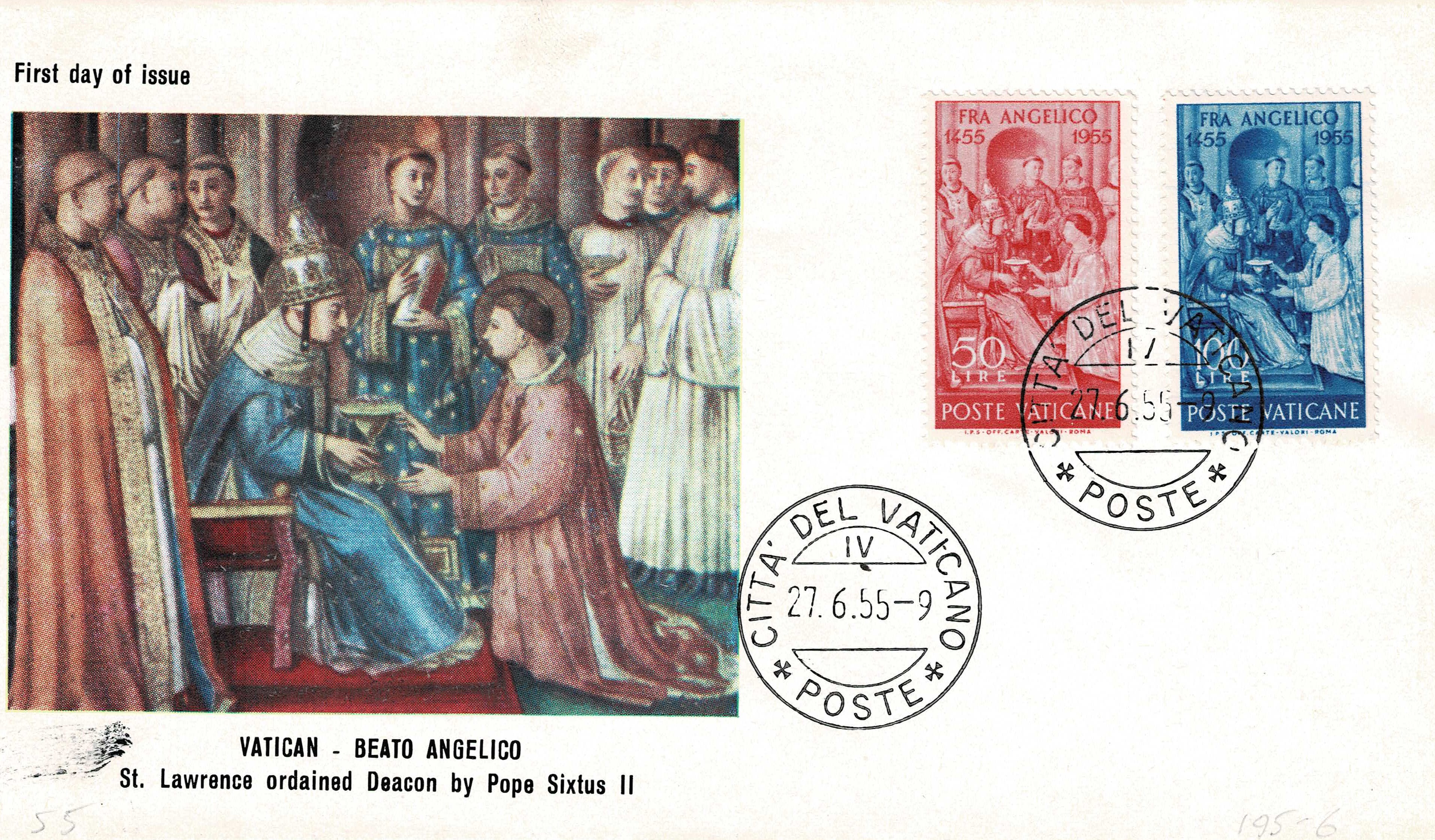



Pope Nicholas V
Oh. November 28, 1955, the Vatican Postal Administration released a set of three commemoratives (illustrated above) to mark the 5th centenary of the of death of Pope Nicholas V.
The stamps were designed by Edmondo Pizzi and printed by photogravure in sheets of fifty stamps (10x5) at the State Printing Office at Rome. The sheets are watermarked with the Crossed Keys and in the left margin is the inscription, (translated from Italian) "ONE SHEET OF FIFTY STAMPS VALUE L.___" The effigy of Nicholas V and the inscriptions on the stamps are in sepia. The background color of 20 lire stamp is light blue, the 35 lire stamp is pale rose, and the 60 lire stamp is emerald green.
Edmondo Pizzi use a detail of the fresco, "The Farewell of St. Lawrence", for the design of the stamps. This painting was executed by Fra Angelico and, like the fresco used for the Fra Angelico commemoratives, is found in the Chapel of Pope Nicholas V in the Vatican Museums.
When Fra Angelico painted the scenes of the lives of Saints Stephen and Lawrence in this chapel he incorporated the effigy of Pope Sixtus II in a number of his works. As there are no likenesses of Sixtus II in existence, Fra Angelico used the features of the then-reigning pontiff, Pope Nicholas V, in his frescos. That is why the original painting identifies the depicted pontiff as Sixtus II.
Pope Sixtus II, portrayed in the "Farewell of Saint Lawrence", was canonized a saint. In the frescoes, Fra Angelico included a halo to denote this. When Edmondo Pizzi copied the detail, he failed to realize that Pope Nicholas V was NOT canonized and included the halo in the design of the stamps. This is a designer's error. Collectors are reminded that he should NOT be referred to as Pope St. Nicholas V, but simply Pope Nicholas V.
Technical Details:
Scott Catalogue - 197 - 199
Date Issued - 28 November 1955
Face Value - 20 l, 35 l, 60 l
Perforations - 14
Printer - The Italian State Printing Works
(Author - Unknown, Vatican Notes Volume IV, Number VIII, December 1955 - January 1956, Pages 1-2)





Saint Bartholomew of Rossano
On December 29, 1955 the Vatican issued a set of three stamps to mark the ninth centenary of the death of St. Bartholomew of Rossano.
The design shows Saint Bartholomew to the right on all three stamps, and a general view of the facade of the Monastery Church dedicated to the Blessed Virgin Grottaferrata, a Basilian Foundation 11 miles from Rome and 2 miles from Frascati. Grottaferrata takes its name no doubt from the iron grating which surrounds or protects the image of the Blessed Virgin in a local church. The figure of St. Bartholomew is taken from an ancient mosaic representing St. Nilus and St. Bartholomew of Rossano still visible in the sanctuary of the abbey church.
The actual founder of the Greek (Basilian) monastery or abbey of Grottaferrata on the Tuscan plain, St. Nilus, died in the year 1005, and was succeeded as abbot in quick succession by Paul, Cyril, and Bartholomew. They were all personal disciples of Nilus, the last being like him a native of Rossano in Calabria. He is venerated as the lesser founder of the abbey, for St. Nilus and his first two successors were able only to clear the land and begin building, while St. Bartholomew carried the work to its conclusion and firmly established his monks, the Basilian (Eastern Rite), who had been driven from Southern Italy by the Saracen invasions. He made his monastery a center for learned studies and the copying of manuscripts, he himself being very skilled in the art of calligraphy, and he also composed a number of liturgical hymns. But his outstanding work was the Life of his master, St. Nilus, from which he gathered much information about the Italo-Greek monasteries, which were still numerous at that time.
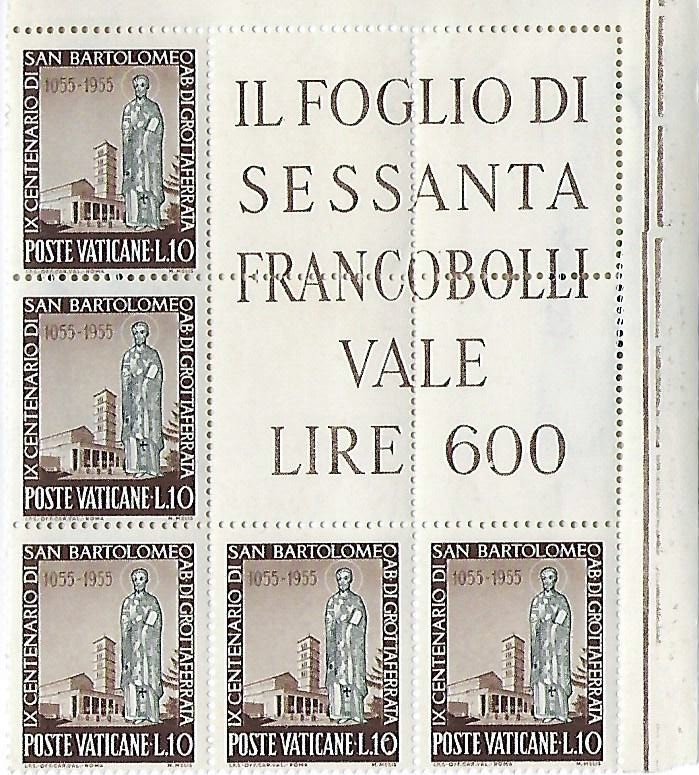
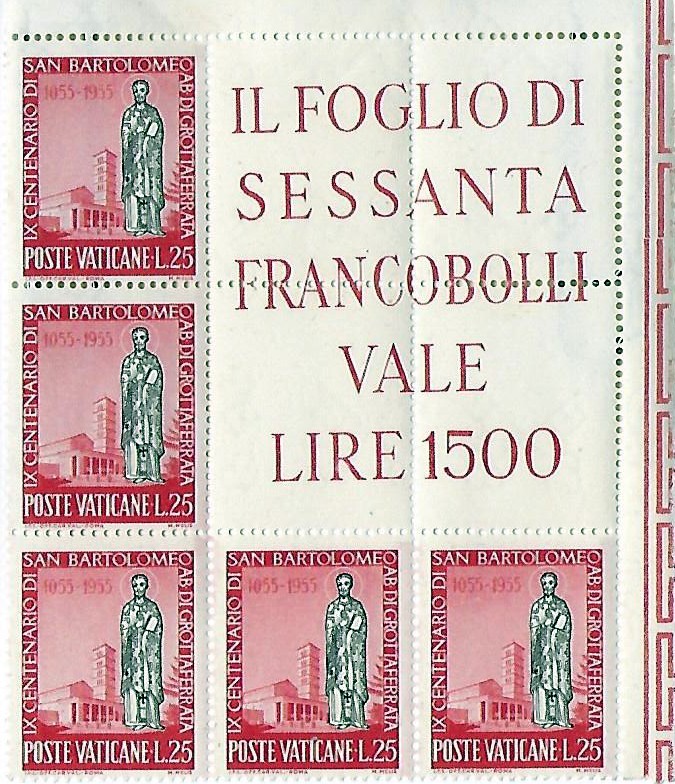
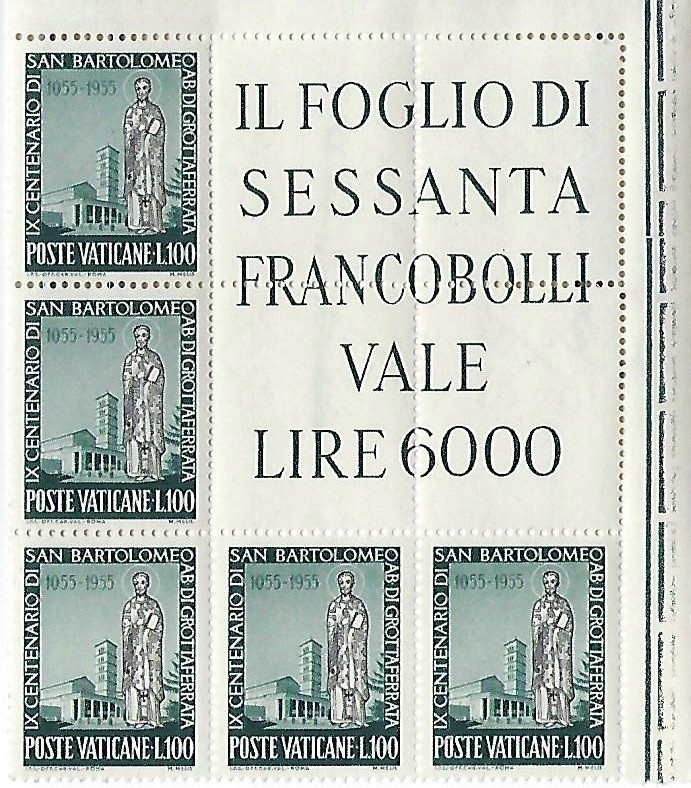








The Pope's Army
Since the Middle Ages, the Papacy has possessed certain temporal powers as well as supreme spiritual authority. From the eighth to the nineteenth centuries, it maintained a civil administration to govern the important central Italian region known as the Papal States. During much of this period, the Papal States were vulnerable to possible invasion by neighboring European powers. Therefore, the Papacy also maintained its own armed forces to preserve its political independence. This temporal role of the Popes was all but ended by the occupation of Rome in 1870. However, certain Papal military units survived to perform ceremonial and security functions within the only remnant of the Papal States, Vatican City. These include the Swiss Guard/ the Palatine Guard, the Noble Guard, and the Gendarmery.
In 1956, the Vatican issued a set of six stamps to honor the most famous of its armed forces, the Swiss Guard (see Scott's #203-208). From the fifteenth to the eighteenth centuries it was a common practice among European rulers to include Swiss regiments in their armies. These regiments were famous for their discipline and their devotion to duty. In 1505, the Swiss Cardinal Schinner persuaded Pope Julius II to form a personal bodyguard of Swiss troops. That same year, the Pope made a treaty with the Swiss cantons of Zurich and Lucerne, in which the two cantons agreed to supply a Guard of 250 men. In 1506, the first Swiss troops arrived in Rome.
Soon after its establishment, the Swiss Guard dramatically proved its loyalty to the Pope. On May 6, 1527, Rome was stormed by the army of the Holy Roman Emperor Charles V. The imperial Army was composed mainly of German mercenaries who had not been paid in months, so they proceeded to pillage and loot the city. Pope Clement VII was forced to flee for his life. While he made his escape, the Swiss Guard fought a valiant delaying action in front of St. Peter's Basilica. Here, 147 Swiss led by Captain Gaspare Roust (see Scott 203-206 above) stood their ground against a horde of hostile Imperial troops pour. ing into St. Peter's Square. Roust and his men all lost their lives, but not until they had slain over 800 of their attackers. Meanwhile, 42 other Swiss escorted the Pope to safety in the nearby Castel Sant'Angelo. This heroic stand firmly established the proud reputation of the Papal Swiss Guard. Later in this article, we shall examine the Swiss Guard as it exists today.
On December 14, 1850, Pope Pius IX combined two already existing militia units to form the Palatine Guard. While the Swiss Guard has always been a force of full-time paid professional soldiers, the Palatine Guard consisted of ordinary Roman citizens who freely volunteered their services to the Pope. They received only a small stipend for their distinctive uniforms, which included a shako Witt a crimson plume, blue trousers, and a tunic trimmed in crimson and gold. They also wore white leather sword and cartridge belts, and were armed with rifles and nickel daggers. Their main function was to stand guard during ceremonies at the Vatican. During World War II they were summoned to full-time duty, and helped to protect Vatican property from sabotage and other acts of irreverence. On November 5, 1943, a small plane dropped four bombs on the Vatican. One of the bombs demolished the mosaic studio near the railway station. Although two Palatine Guardsmen were stationed' near the damaged area, they did not abandon their posts. After the war, the Guard returned to its part-time ceremonial duties. In 1950, the Vatican issued a set of three stamps to commemorate the centennial of the Palatine Guard (Scott's 140-142). These stamps show the Guard marching in front of St. Peter's Basilica.
Two other important Papal units were the Noble Guard and the Gendarmerie. In 1801, Pope Pius VII established the Noble Guard as a special mounted bodyguard. All Guardsmen held titles of nobility as well as officers' rank. After World War II they ceased to be a mounted unit. From then on the main function of the Noble Guard was to provide music for Papal processions. The Gendarmery was the police force of Vatican City. All gendarmes served previously in the Italian Army, and many of them were former Carabinieri (Italian National Police) as well. They wore colorful Napoleonic-style uniforms. In addition to maintaining general law and order, they turned away improperly dressed persons. trying to enter St. Peter's Basilica. In September of 2970, Pope Paul VI disbanded the Palatine Guard, the Noble Guard, and the Gendarmery. In explaining his action, the Pope said that these units "... though deserving of all praise, no longer correspond to the needs for which they were founded." The Vatican has since established a modern security force, the Servizio di Vioilanza. It consists of plain-clothed personnel who carefully observe all visitors to the Vatican.
However, the most important Vatican security force is still the Swiss Guard. Today the Guard numbers about 100 men commanded by a colonel. All Guardsmen have previous military experience as members of the Swiss Army. Near the end of his tour of duty, a Swiss soldier becomes eligible to join the Guard if he meets certain requirements. He must be a Catholic, of good character, single, and at least five feet, 81/2 inches tall. New recruits sign on for a minimum enlistment of three years, and begin with a colorful swearing-in ceremony. This usually takes place on May 6th in the Courtyard of St. Damasus. Each new recruit grasps the Guard banner with his left hand, and raises two fingers and the thumb of his right hand (symbolizing the Trinity). Like all his predecessors, he then swears to lay down his life for the Pope, if necessary.
Guardsmen are usually armed with medieval halberds and broadswords. However, they are also trained in the use of Swiss Army rifles and submachine guns. They keep these modern weapons close by when on sentry duty. Since gunfire is forbidden on Vatican grounds, they must go outside Rome for rifle practice. All Guards, are also trained in hand-to-hand combat. They have two basic uniforms, which normally include simple black berets rather than helmets. Their red, yellow, and blue formal uniform is said to have been designed by Michelangelo.
This uniform is worn regularly by Swiss Guards on sentry duty at the Arch of the Bells (to the left of St. Peter's Basilica) and at the Bronze Gate (entrance to the Apostolic Palace Place). They also have a less formal steel blue uniform. Their armor is cleaned and polished daily, but is worn only on special occasions. Swiss Guards are found on sentry duty at all entrances to the Vatican. They are also stationed at all doors leading to the Pope's private chambers. The two Guardsmen at the entrance to the Papal Study refuse admittance to all but a select few. During Papal Audiences, they check all those entering St. Peter's Square to make sure they have the required tickets. The Swiss Guard and the Servizio work together to maintain order UUFFKg audiences. The Swiss Guards are among the few actual residents of Vatican City.
Their barracks are found just inside St. Anne's Gate, not far from the Central Post Office. Here they have their own chapel, canteen, tailor, and barber. Officers, who are allowed to marry, live in private apartments with their families. It is a good life, and many Guards re-enlist. The Papacy was served by four special military units from 1929 to 1970. Two of these, the Palatine Guard and the Noble Guard, were mainly ceremonial units, while the Gendarmery was the Vatican police force. As the ceremonial features of the Papacy were reduced, these three units became obsolete. However, the Swiss Guard has survived to continue its long proud tradition of protecting the Pope.
This article originally appeared in Vatican Notes in November, 1982, and can be accessed by clicking on the reference below. Very minor edits have been made to the original presentation.
REFERENCE:

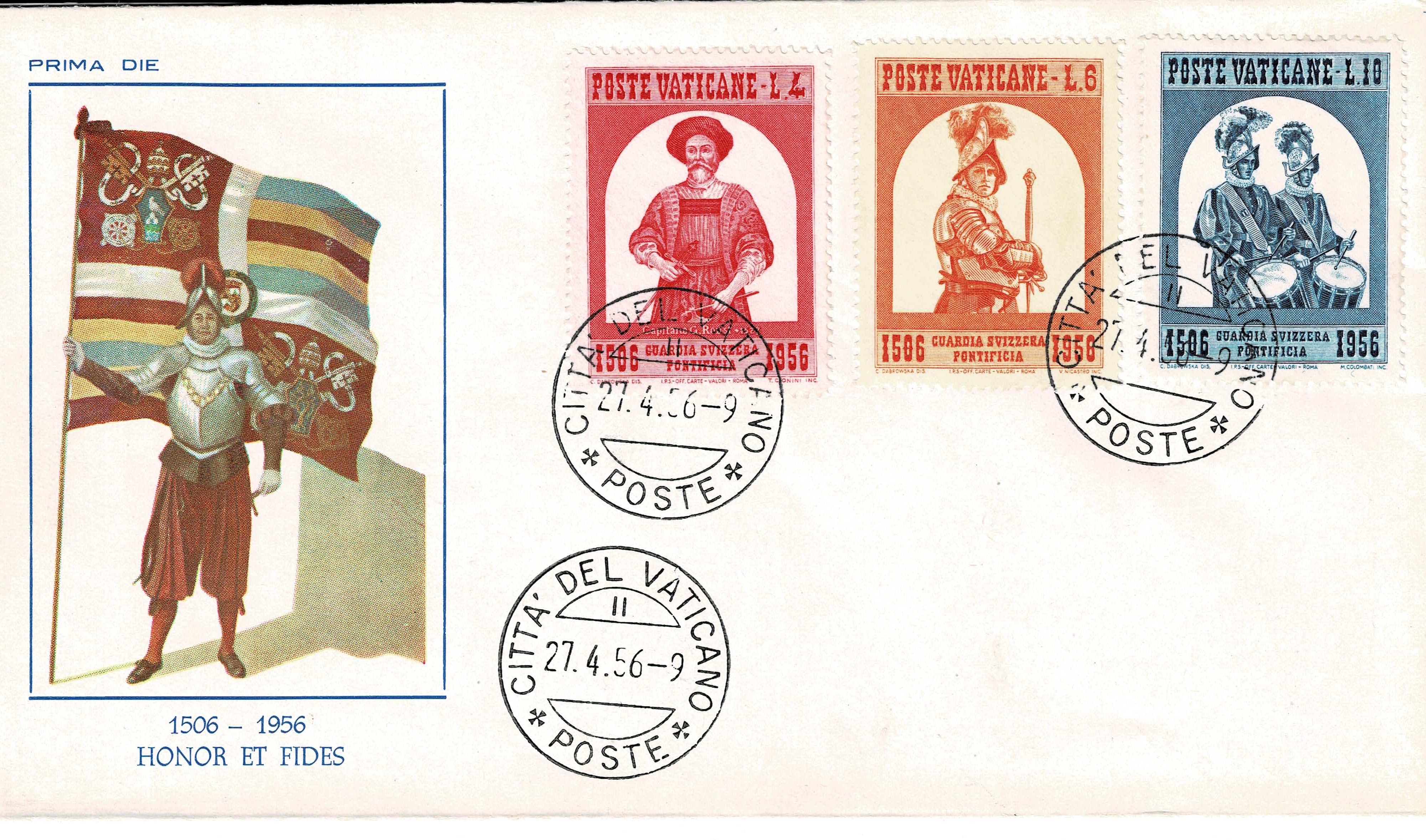


Saint Ignatius of Loyola
On July thirty-first (1956) the Vatican Postal Administration released a set of two commemoratives to honor the fourth centenary of the death of St. Ignatius of Loyola. The date chosen for their release is the feast day of St. Ignatius and is the date on which he joined his Maker four hundred years ago.
The design was executed by Elsa Casimira Dabrowska who used a detail of an oil painting showing a scene of September 27, 1540, "Ignatius presents the Society's rules to Pope Paul III". The stamps were printed from plates engraved by Canfarini, Inc. in panes of 45 stamps at the State Printing Office, Rome. The paper on which they were printed was watermarked with the Crossed Keys. The selvage is without inscriptions as to number of stamps or value of the sheet. There are NO corner inscription blocks available in this issue.
Technical Details:
Scott Catalogue - 212 - 213
Date Issued - 31 July 1956
Face Value - 35 l, 60 l
Perforations - 13
Printer - The Italian State Printing Works
(Author - Unknown, From Vatican Notes Volume V, Number II, August-September 1956, Page 1)



St. John of Capistrano
John was born at Capistrano in Abruzzi and progressed in both sacred and profane learning. Because of his great knowledge of law, he was made governor of several cities by King Ladislaus of Naples. He was attempting to restore peace to that troubled area when he was seized and jailed. He was delivered from captivity and joined the Friar Minor. As a Franciscan, he studied under St. Bernadine of Siena and imitated him in spreading devotion to the Holy Name of Jesus and to the Mother of God. He refused appointment as Bishop of Aquila and lead a mortified life.
Giving himself, without ceasing to preach, he traveled through almost all of Italy and brought many souls back to the way of salvation by his preaching and miracles. At the Council of Florence, he brought back the Armenians to the Catholic Church.
Nicholas V sent him to Germany, as Apostolic Nuncio, at the request of Emperor Frederick III, to bring back to the Catholic faith those who had fallen into heresy. In six years of missionary work, he brought back to the church countless numbers of Hussites, Adamites, Taborites, and others by his preaching and further miracles.
At the instigation of John, Pope Callistus III proclaimed a Crusade against the Turks. John hastened into Panonia, and other provinces, and raised 70,000 soldiers. It was mainly through his advice and courage that victory was gained at Belgrade where 120,000 Turks were either slain or fled.
Seized by a fatal illness, he was taken to Illak and died on October 23, 1456. He was canonized by Alexander VIII in 1690. Leo XIII extended his feast to the Universal Church on the date of March 28.
EDITOR’S NOTE: this article first appeared in Vatican Notes in 1956 (Volume IX, Number I, pages 7 and 8). It has been gently edited to add color images of the stamps of the issue as well as other minor edits.
REFERENCE:






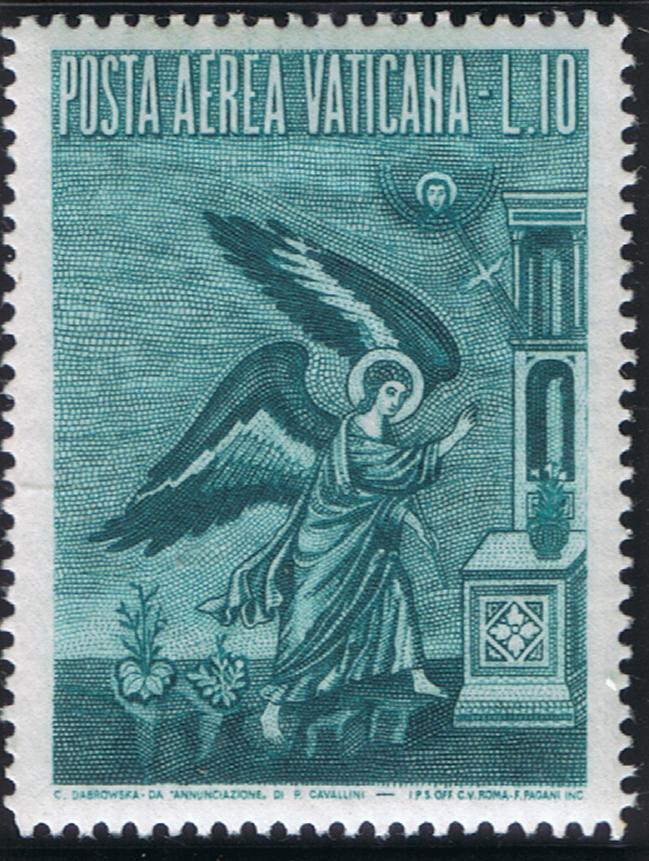
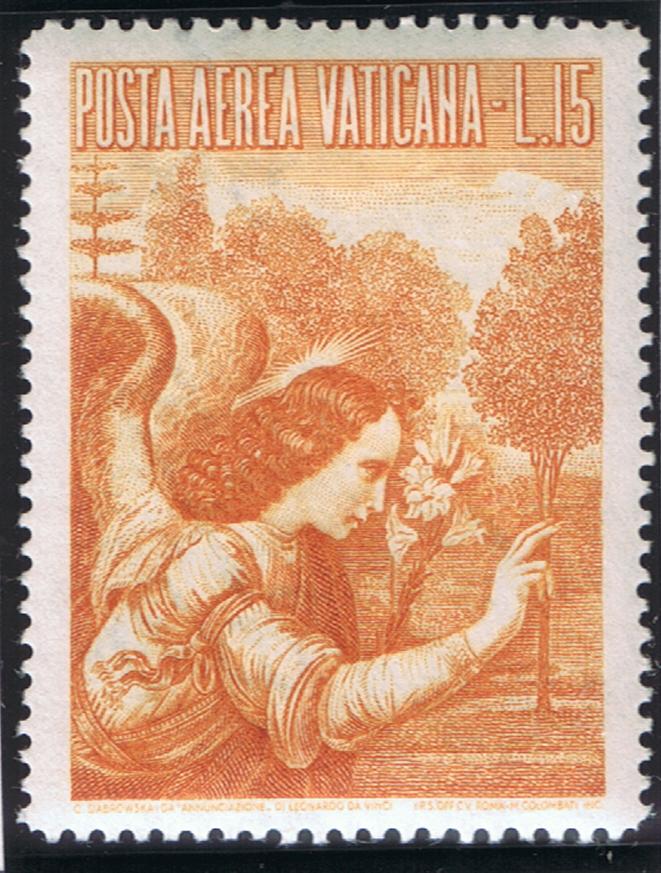
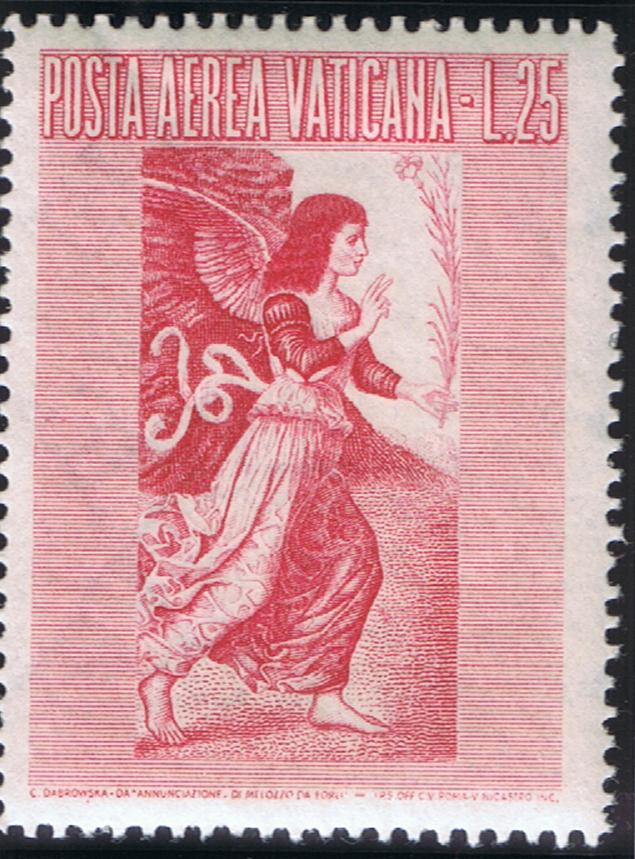
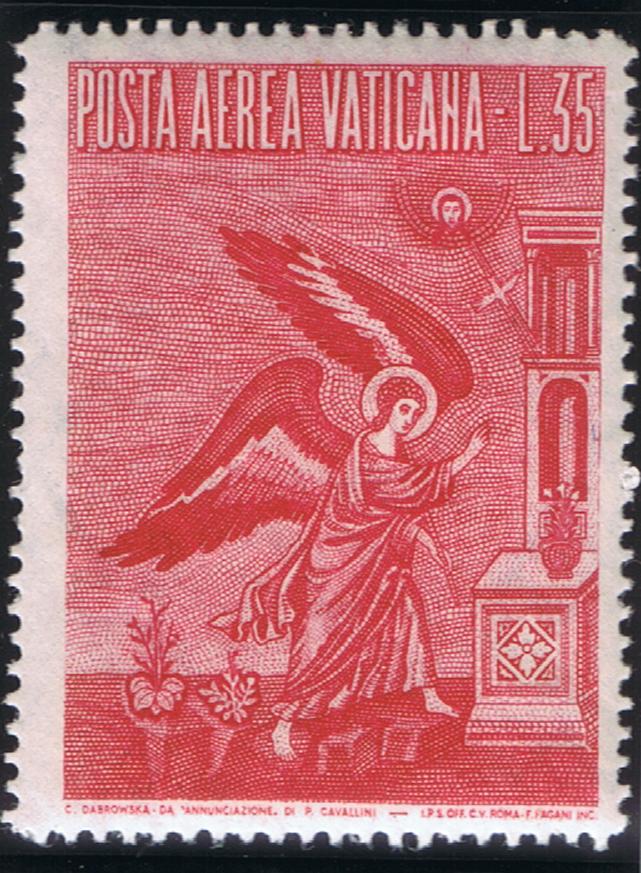
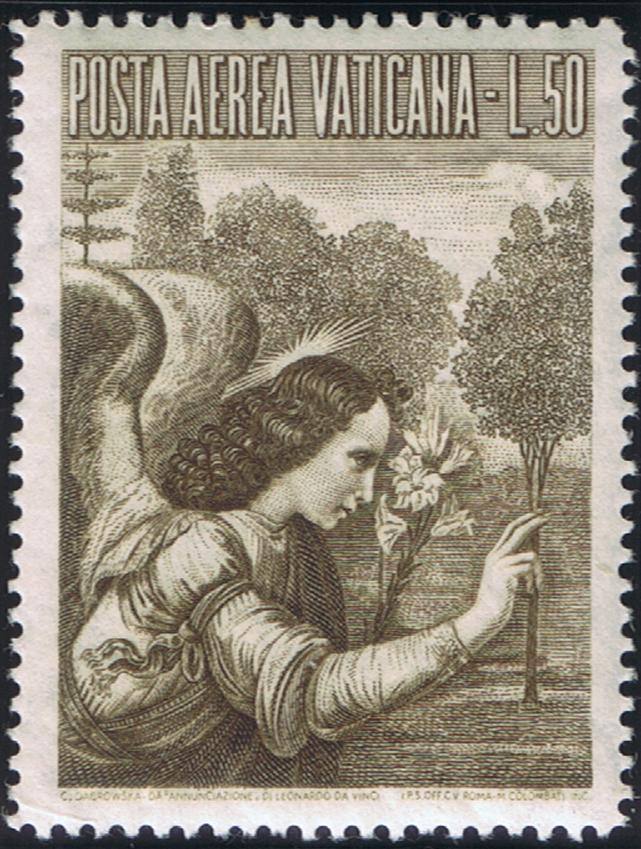
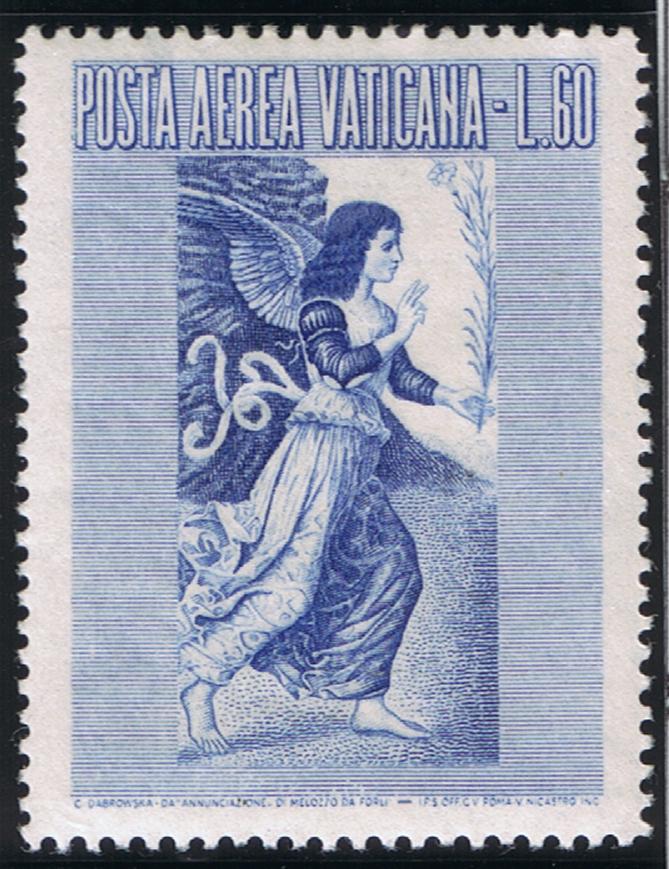
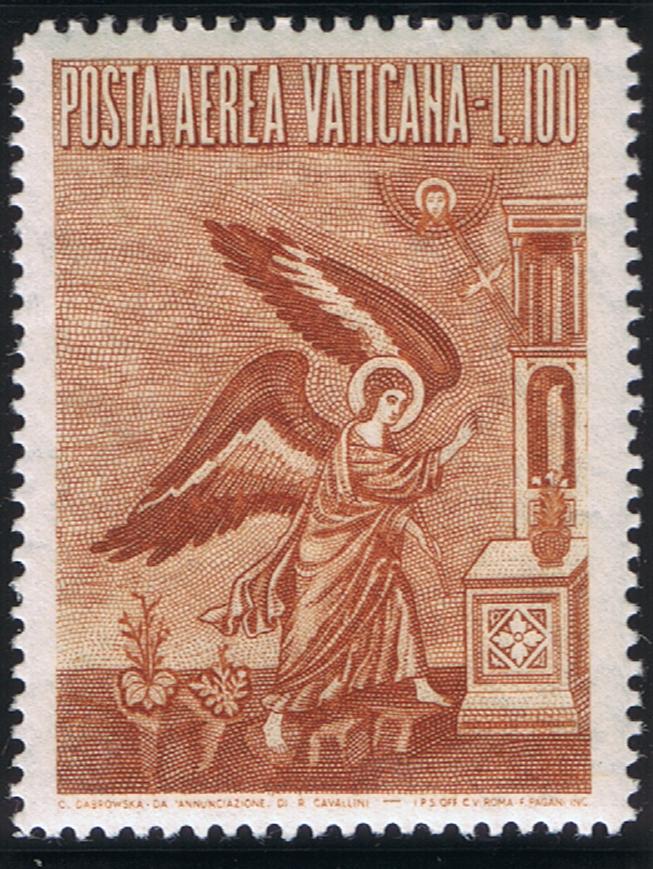
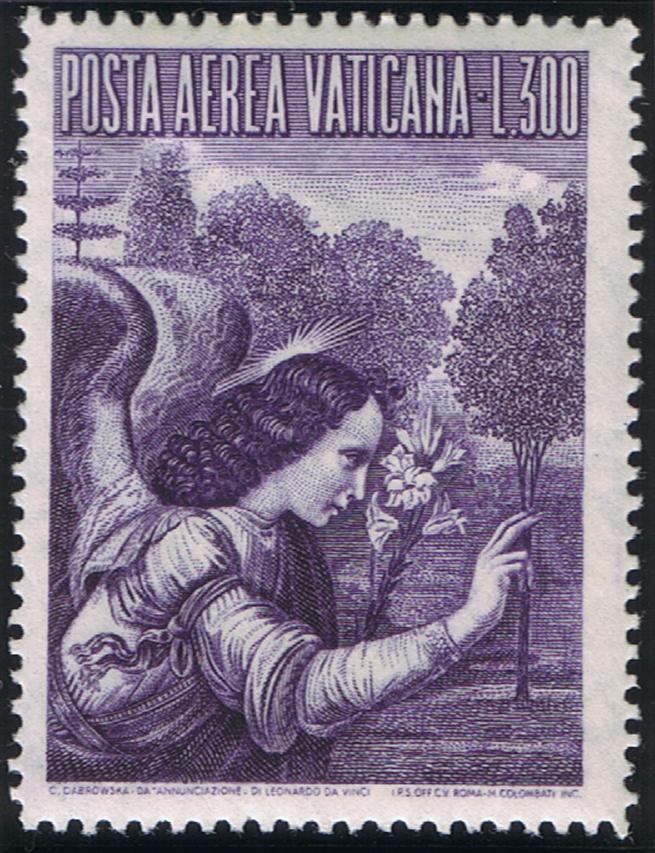
SAINT GABRIEL, ARCHANGEL
"Hail, full of grace the Lord is with thee." The archangel Gabriel in the form and figure of a man spoke these words to Mary, she did not speak. Who was this person? Why the greeting? What was the meaning of it? The messenger of God continued, "Fear not Mary, for thou hast found grace with God. Behold thou shalt conceive in thy womb, and thou shalt bring forth a son; and thou shalt call him Jesus. He shall be great and called the Son of the Most High; and the Lord God shall give him the throne of David his father; and he shall reign in the house of Jacob forever. And of his kingdom there shall be no end." The young virgin was bewildered, why should she be chosen the Mother of the Messiah, she had vowed her virginity to God. Not to doubt the Word of God, Mary said, "How shall this be done, I know not man?" To quiet her anxiety and to assure her that her virginity would be spared, Gabriel answered, "The Holy Ghost shall come upon thee and the power of the Most High shall overshadow thee. And therefore also the Holy which shall be born of thee shall be called the Son of God." To indicate the truth of his word, the archangel told Mary of the conception of St. John with the words, "And behold, thy cousin Elizabeth; she also has conceived a son in her old age, and this is the sixth month with her that is called barren: Because no word shall be impossible with God." To this Mary replied, "Behold the handmaid of the Lord, be it done to me according to thy word."
This, the Annunciation of the Blessed Virgin Mary, was the last and most important of the four errands recorded in the Scriptures that God had sent his messenger, Saint Gabriel, to perform. It is this errand for which the archangel is most remembered and it was the motif for the designs of the airmail definitive issue released by the Vatican Postal Administration on February 22, 1956. The designs of the stamps were taken from paintings by the Annunciation by Melozzo da Forli, Leonardo di Vinci, and Pietro Cavallini. The detail of each depicting the archangel was used for the design of three of the stamps of the airmail issue. But what of the other three errands St. Gabriel performed for God?
In 554 B.C., while the Israelites were held captive by the Babylons, Gabriel made his first recorded visit to Daniel, the prophet. Daniel had had a dream of a ram with two horns pushing them against the west, the north, and the south. No beast could withstand the ram nor be delivered from it. The ram did as it pleased and became great. Then out of the west came a he-goat with a horn between its eyes. The he-goat destroyed both of the Ram's horns and overcame him. God sent the archangel to explain the dream. Gabriel related that the ram symbolized the empire of the Medes and Persians. The he-goat from the west was the king of the Greeks, Alexander the Great, who would destroy the empire as the he-goat had destroyed the ram. This prophecy was fulfilled nearly 200 years later.
At a later date, Gabriel again appeared to Daniel as he was praying for the people of Israel. He explained to Daniel the mysterious prophecy of the "seventy weeks" of years that were to pass before the coming of Christ. Gabriel went on and foretold the destruction of Jerusalem and its sanctuary.
The third visit of St. Gabriel recorded in the Scriptures was to St. Zachary, a member of the priestly class. It was customary for priests whose week it was to serve in the temple to caste lots to determine which of the various rituals they would perform. Zachary was chosen to offer incense upon the altar in the holy place. While he was alone before the altar executing this rite the angel Gabriel appeared to him, standing at the right side of the altar. At the appearance of the angel, Zachary was troubled and afraid. Gabriel spoke to him and told him that the prayers of the priest and his wife, St. Elizabeth, would be answered. A son would be born to them and he would be called John. Zachary found this hard to believe as he and Elizabeth were advanced in years. Gathering his wits and overcoming his fear, he asked Gabriel for some sort of a sign. Because Zachary had indicated that he doubted this message Gabriel had brought from God, the angel announced that he would be stricken dumb and would not regain his speech until the prophecy had been fulfilled.
Six months after John the Baptist had been conceived Gabriel appeared to Mary and announced that she was to be the Mother of God.
Though Gabriel is mentioned only four times in the Scriptures, Christian tradition holds him to be the unnamed angel who appeared to St. Joseph in a dream to reveal to him the Mystery of the Incarnation and later to flee with is family to Egypt to escape the wrath of the jealous Herod. Gabriel is also thought to be the angel who appeared to the shepherds to announce the Birth of Christ as well as the angel who "strengthened" Christ in the Garden of Gethsemani.
The angel Gabriel is not reserved to those of the Christian faith alone. His name is derived from a Hebrew word meaning, "Hero of God". In Jewish as well as Christian tradition, Gabriel is one of the seven archangels who stand before the Lord.
Those of the Jewish faith venerate him as the angel of Judgment. To Gabriel they attribute the destruction of Sodom and of the host of Sennacherib, as the angel who buried Moses, and is the one appointed to mark the figure of Tau on the foreheads of the elect. In later Jewish literature the names of angels were regarded as having a peculiar curing power. The British Museum possesses some magic bowls: inscribed with Aramaic, Hebrew, and Syriac incantations, in which the names of Gabriel, Michael, and Raphael occur. These bowls were found at Hillah, the site of Babylon, and constitute interesting relics of the Jewish captivity.
Gabriel is also known to the religion of Islam. Mohammedans believe him to be the angel who served as the mouthpiece of God in dictating the Koran to their prophet, Mohammed.
Saint Gabriel, the archangel, whose feast is celebrated by the Catholic Church on March 24th, has a special meaning to philatelists. As a messenger of God, he was chosen as the patron of postal and telecommunications workers, the messengers of the people.
In 1954, the Reverend Aloysius S. Horn of Fremont, Ohio, with the assistance of Francis Cardinal Spellman, Archbishop of New York founded the St. Gabriel Philatelic Academy, an honor society of outstanding philatelists the world over who are engaged in the study and research of religious stamps. Each year, on March 24th, the feast of St. Gabriel, diplomas are awarded to new members who have attained the honor of membership in this philatelic organization.
Technical Details:
Scott Catalogue - C24 - C32
Date Issued - 22 February 1956
Face Value - 5 l, 10 l, 15 l, 25 l, €1.25, 35 l, 50 l, 60 l, 100 l, 300 l
Perforations - 13
Printer - The Italian State Printing Works
(Author - William Wonneberger, Jr., From Vatican Notes Volume IV, Number IX, February - March 1956, Pages 7-9)






Saint Domenico Savio
Domenic Savio was born at Riva di Chieri, near Turin, Italy, on April 2, 1842 and died there on March 9, 1857. He was the second of 11 children born to Domenico Savio and his wife, Bridget Gaiato. The father worked on a rented farm and the mother was a part-time dressmaker while the father was also a spare-time blacksmith. The young saint showed an early love for prayer. At the age of 5 he became an altar boy at Murialdo, where his family had moved, and on winter mornings was often found kneeling in the snow or rain waiting for the priest to open the church. Custom, at that time, was for First Holy Communion to be received at the age of 11 or 12, but Dominic was allowed to receive his at the age of 7. On this occasion he made four resolutions: " I will sanctify Sundays and Holy Days; my friends will be Jesus and Mary; I will go to confession as often as my confessor allows; death, but never sin. "
He was averse to quarreling, but only after overcoming a temper. Desiring to be a priest, he walked several miles to school each day to prepare himself. On October 2, 1854, he was introduced to St. John Bosco, then a priest working for poor boys, and in Dominic Don Bosco recognized the makings of a saint, and at Dominic's request agreed to guide him along the road to sanctity. Dominic went to Turin to live at the Oratory established by Don Bosco where he not only sheltered homeless boys but taught them to be true christians. When the cholera plague struck Turin, Dominic was one of 40 boys recruited by Don Bosco to do infirmary work in the city, even though Dominic was not very strong. On two occasions, through inspiration, he lead Don Bosco to people who were dying and were in need of a priest.
Dominic attended private schools near the Oratory where the boys of Don Bosco were given free instruction. In 1854 he made the Novena of the Immaculate Conception with great fervor and told Don Bosco that he was consumed by an overpowering urge to become a saint, and from this time onward his progress in holiness so amazed Don Bosco that he began taking note of the boy's conduct for a future biography. Dominic organized the Sodality of the Immaculate Conception in the Oratory and from its original 18 members, 17 were to form the nucleus of the Salesion Society, destined to become the third largest male religious order in the church. During this period many visions were granted to Dominic.
Never too healthy, he was sent home in the summer of 1856 to regain his health and returned to the Oratory only to have his health fail again. By February he was so poorly that Don Bosco deemed it prudent to send him home for a second time. He told his unbelieving parents that he had come home to die, and over their protests received the last sacraments. On March 9th, while sitting up in bed and reciting psalms with his father, he said: " Oh, what a beautiful sight I see ", and died peacefully.
A month after his death he appeared to his father and told him that he was already in heaven. In December 1876 he appeared to Don Bosco, leading a host of youths. He foretold the deaths of some of the boys; the future of the Salesion Society, which Don Bosco had just founded; the death of Pius IX; and other events. Pius IX had Don Bosco commit this apparition to writing. Almost immediately after Dominic's death, his grave became the center of pilgrimages, and extraordinary graces were obtained through his intercession. On October 27, 1914, his body was laid beside St. John Bosco's in the Salesian basilica of Our Lady Help of Christians. He was beatified May 5, 1949 and canonized June 12, 1954. He was a model and patron for teenagers, called by Pope Pius XII: " A timely model for the youth of Catholic Action throughout the world. "









Capranica College
This is the oldest of the Roman Colleges and was founded by Domenico Cardinal Capranica in 1457 in his own palace for 31 young clerics, who received an education designed for the formation of good priests. Capranica was one of the most earnest reformers of the Roman church, The Cardinal himself drew up the rules of the college and presented it with his library, the most valuable part of which was later transferred to the Vatican. His brother, Angelo, erected a suitable home for the students opposite his own palace. During the siege of Rome, in 1527, all the students and their rector were killed in the defense of the Ports di Santo Spirito. The rector, for a time, was elected by the students from among themselves, but Alexander VII decided that the rector should be appointed by the protectors of the college. The college was re-established in 1807, and the number of free students was reduced to 13. Those entering must have completed their 17th year and they attend lectures at the Gregorian University. Many cardinals, bishops, and diplomats have come from its graduates.
The stamp shows a bust of Cardinal Capranica and his coat of arms at the left. In the center is the college, and at the right is the church of Santa Maria in Aquiro.
Cardinal Domenico Capranica was born in Capranica near Palestrina, Italy in 1400 and died at Rome July 14, 1458. Studying at Padua and under such teachers as the future cardinals Giuliano. Caesarini and Nicholas of Cusa he received his Doctorate of Both Laws at the age of 21. As secretary to Martin V he was promoted rapidly, administering at Imola and Forli, and became Bishop of Fermo. He was made cardinal in peto, but did not attend the installation ceremony. At the conclave, after the death of Martin V, the cardinals would not recognize his cardinalate (1431), a view sustained by the newly elected Eugene IV. Having suffered severe losses at the hands of the Orsini at Rome, he took refuge with the Visconti at Milan. He appealed in 1432 to the Council of Basle for recognition of his cardinalate and received recognition. Eugene IV deprived him of all honors and possessions for this act. Capranica bore himself moderately and in 1434 was reconciled with Eugene and, as cardinal, receive Santa Croce in Gerusalemme as his titular church. He executed many responsible missions for the Holy See, and was used as peacemaker throughout Europe. He is best known for his establishment of the Capranica College.
Santa Maria in Aquiro, or degli Orfanelli, in the Piazza Capranica, was built on the site of a 4th-century church. The name Aquiro is supposed to be derived from the Equeriae, or stadium of a circus that once stood there. At a later date, the church was annexed to an orphanage founded by Pius III. The church is decorated by frescoes by Mariani. The church and the piazza Capranica are said to occupy the location of a portico and temple erected by Hadrian to Matilda, his wife's sister.
The second design records a visit by Pius XII to the rooms he once occupied at Capranica College in 1894-95, made on January 21, 1957.
Technical Details:
Scott Catalogue - 223 - 226
Date Issued - 27 June 1957
Face Value - 5 l, 10 l, 35 l, 100 l
Perforations - 13
Printer - The Italian State Printing Office
(Author - Unknown, From Vatican Notes Volume IX, Number 3, November - December 1960, Pages 9 - 10)




20th Anniversary Of The Re-establishment Of The Pontifical Academy of Science
The Pontifical Academy of Science, in its present form, is of recent origin, but it traces its tradition back to 1603 when there was established in Rome by Federico Cesi, together with three other twenty-year-old men, the first scientific academy in the modern world. With interests in mineralogy, astronomy, zoology, and botany, it aimed at both the discovery and dissemination of knowledge. They called themselves the "Lincei", those having the penetrating eye of the lynx. Galileo Galilei was a member. But with the death of Cesi, the academy went downhill and activity ceased in 1651. An attempt at revival was made by Francesco Caetani in 1801, called the " Nuovi Lincei ". The papacy had always supported the society and in 1847 Pius IX established it as " The Pontifical Academy of the Nuovi Lincei " in the Campidoglio. Under papal auspices, it flourished until the new Italian government seized its library and archives, after which times its operations were slight for many years.
Benedict XV decided to revive the academy and appointed Fr. Giuseppi Gianfranceschi as its new president, with the intent of a complete reform and modernization of the academy, but death overtook the Pope. Pius XI confirmed the work and on the death of Fr. Gianfranceschi, called the founder and rector of the Catholic University of Milan, Fr. Agostino Gemelli, to be its head. In early 1936 Pius XI stated the purpose of the Academy as " not to honor Catholics, but dedicated to science as a font of truth and therefore a means of liberation from evil. " Its new title was " The Pontifical Academy of Sciences ".
" Study Week " brings together scientists to discuss difficulties and to iron out problems on a specific subject, in order to expedite progress in that field. World War II interrupted the work of the Academy but it was resumed with peace. Study week of 1949 brought together experts on cancer. Study week of 1951 saw geophysicists studying the localization of the position of oceanic cyclones. In 1955 the influence of microelements on vegetable and animal life, which can result in increased food crops and curing of functional and organic diseases. Cardinal Pacelli, as Cardinal Legate, officially participated at the inauguration of the Academy in June of 1937 and later as Pope Pius XII supported and encouraged it.
The Casino of Pius IV, or Villa Pia, is the meeting place of the Pontifical Academy of Sciences. This is a country house constructed in the Vatican Gardens in a small grove facing the Cortile di Belvedere by Pirro Ligorio (probably born in Naples before 1510, and who died in 1583 ), a man of great learning in architecture, engineering, painting, writing, archeology and antiquity, but who had a bad name among archeologists because of his frequent falsification of inscriptions. His vast knowledge of antiquity is shown in the Villa Pia. Many ancient country villas are indicated as his model, but actually he drew from all of the best of antiquity to design this original conception.
Pope Paul IV had begun its construction in May, 1558, but his death halted the work in the same year, and Pius IV resumed it in May 1360. The general work was completed in 1561, and the interior by 1562, but antique materials were added constantly. The purpose of the Casino was to provide the Pope with an easily accessible place of quiet and recreation whether alone or with friends. The Villa Pia is the only secular building in complete preservation from the period of transition from the Renaissance to the Baroque style. It combines architecture, decoration and painting in perfect harmony.
The Villa originally consisted of two small buildings, the Casino and the Loggia. These were separated by an oval-shaped court enclosed by a parapet, with seats, and a fountain in the middle. The fountain and its oval basin show two marble figures of putti riding a dolphin, the work of Casignola. The courtyard is paved with white travertino and dark peperino with no regular pattern, and the enclosing wall with but two entrances insures privacy.
The decorative art balances the architectural. The facades of both the Casino and Loggia are covered with stucco ornamentation, and columns of gray Numidian granite adorn the entrances of both buildings. The Casino has a mosaic-decorated portico leading to three rooms while on the floor above one finds corresponding rooms. The interior of the Casino is more magnificently decorated than the exterior. The Loggia was used for open-air meals, and had a view of a fish pond and garden. It was decorated interiorly by the same artists as did the Casino. The Villa Pia was a clever combination of house and garden with the appearance of happy informality. Pius IV spent much time there. Pius V dined there frequently, while Pius VIII and Gregory XVI frequently held audiences there.
Pope Pius XI enlarged the Villa in 1932, having Giuseppi Momo keep the new construction in harmony with the original buildings. The entrance to the new addition faces the picture gallery, while on the Vatican side there is a private entrance for the pope. The new addition is connected with the rooms on the first floor of the Villa by an arcade. Its setting, amid the quiet of the Vatican Gardens, ideal for meetings of the Academy of Science.
Technical Details:
Scott Catalogue - 227 - 228
Date Issued - 09 October 1957
Face Value - 35 l, 60 l
Perforations - 14
Printer - The Italian State Printing Office
(Author - Unknown, From Vatican Notes Volume IX, Number 4, January-February 1961, Pages 11-12)






Mariazell Shrine
In either 1066 or 1103, the Benedictines established the Abbey of St. Lambrecht in a picturesque setting about 60 miles southwest of Vienna on the northern border of the Province of Styria, Austria. An old legend recounts that a monk named Magnus came to the monastery in the year 1157, bringing with him a statue of the Blessed Virgin Mary and the Christ Child, carved from lime-wood. A small hut was built to house the statue but soon the number of local inhabitants, who came there to pray at the shrine of the Blessed Virgin, became so great that is was necessary to build a larger wooden edifice.
The fame of graces, granted at the shrine, drew Count Henry Ladislaus of Moravia who built the first stone church on the spot in 1200. About 100 years later Louis the Great of Hungary made a pilgrimage to Mariazell and in 1300 built a large gothic basilica to commemorate his victory over the Bulgars. The original chapel was preserved in the church and it became the principal shrine of Central Europe.
About 1600 King Ferdinand III had the style changed to baroque by the Lombard architect, Domenico Selassie, who built the dome on the church and to the original gothic tower added two smaller towers. About this time the interior of the church (207 feet long by 69 feet wide) was decorated by several Italian artists. Numerous votive pictures are found in the ambulatory, but the more ancient, representing remarkable occurrences connected with Mariazell, are found above the arches. Above the altar was placed a grouping of marble statues of Sts. Anna & Joachim by Lorenzo Matielli.
Queen Maria Theresa and Francis I, in 1757, had the high altar covered with silver as a more fitting throne for the statue of the Madonna and Child. Two life size figures of marble and an ebony crucifix donated by Emperor Charles VI decorate the main altar.
From Bohemia, Moravia and other slavic countries, and from Austria and Hungary, more than 100,000 pilgrims made their way to the shrine even in the 19th century. With modern transportation, more than 300,000 pilgrims arrive each year. Under Joseph II of Austria it was the most important shrine in Austria, and by his orders time of pilgrimage was assigned to certain areas of his country, to ensure a constant flow to the shrine. Vienna started its pilgrimage on July 1, and Gratz on August 14. Under Nazi domination pilgrimages were forbidden. But even greater numbers came during the Marian Year of 1954 and in the 800th anniversary year of 1957.
The Blessed Virgin Mary has been given several titles at this shrine: The Mother of the Slavonic Peoples; The Great Lady of Hungary; The Great Mother of Austria. The church is still under the Benedictines who founded the Abbey of St. Lambrecht. To celebrate the Marian Year Pope Pius XII made the Abbey an independent priory. In the 800th anniversary year the same Pius granted a plenary indulgence to all pilgrims who came during the time of the celebration which lasted from March to October 15, 1957.
Technical Details:
Scott Catalogue - 229 - 232
Date Issued - 14 November 1957
Face Value - 5 l, 15 l, €1.25, 60 l, 100 l
Perforations - 13
Printer - The Italian State Printing Office
(Author - Unknown, From Vatican Notes Volume IX, Number 3, November - December 1960, Pages 11 - 12)







Apparition of the Holy Virgin at Lourdes
The appearance of the Blessed Virgin Mary to a young peasant girl in Lourdes, France, is one of the great stories of the Catholic faith.
On February 11, 1858, fourteen-year-old Bernadette Soubirous experienced the first of her 18 visions of the Blessed Mother, the figure of a woman in dazzling light and a clothed in white. She encountered the vision while searching for firewood at the Massabielle Grotto at Lourdes. She was instructed to return to the spot of the visions for two weeks. The lady in white instructed Bernadette that a chapel be constructed on the site. She was also instructed to dig a hole, from which water flowed continually thereafter. During the sixteenth vision, the lady in white stated, I am the Immaculate Conception.
After initial skepticism, the visions were confirmed as legitimate in 1862. Many ill persons were cured by visits to the site, and the water of the ever-flowing stream was considered a means to a cure from illness, although Bernadette stated it was faith and prayer and not water than provided the cures.
Bernadette was to join the Sisters of Charity at Nevers (France) where she worked as a sacristan and also in the infirmary. She died at the age of 21 of tuberculosis on April 16, 1879, and was canonized in 1933 by Pope Pius XI.
To this day, Lourdes, a small village in the foothills of the Pyrenees, remains one of the most-visited Christian pilgrimage sites, accommodating upwards of 7 million pilgrims annually.
REFERENCES::
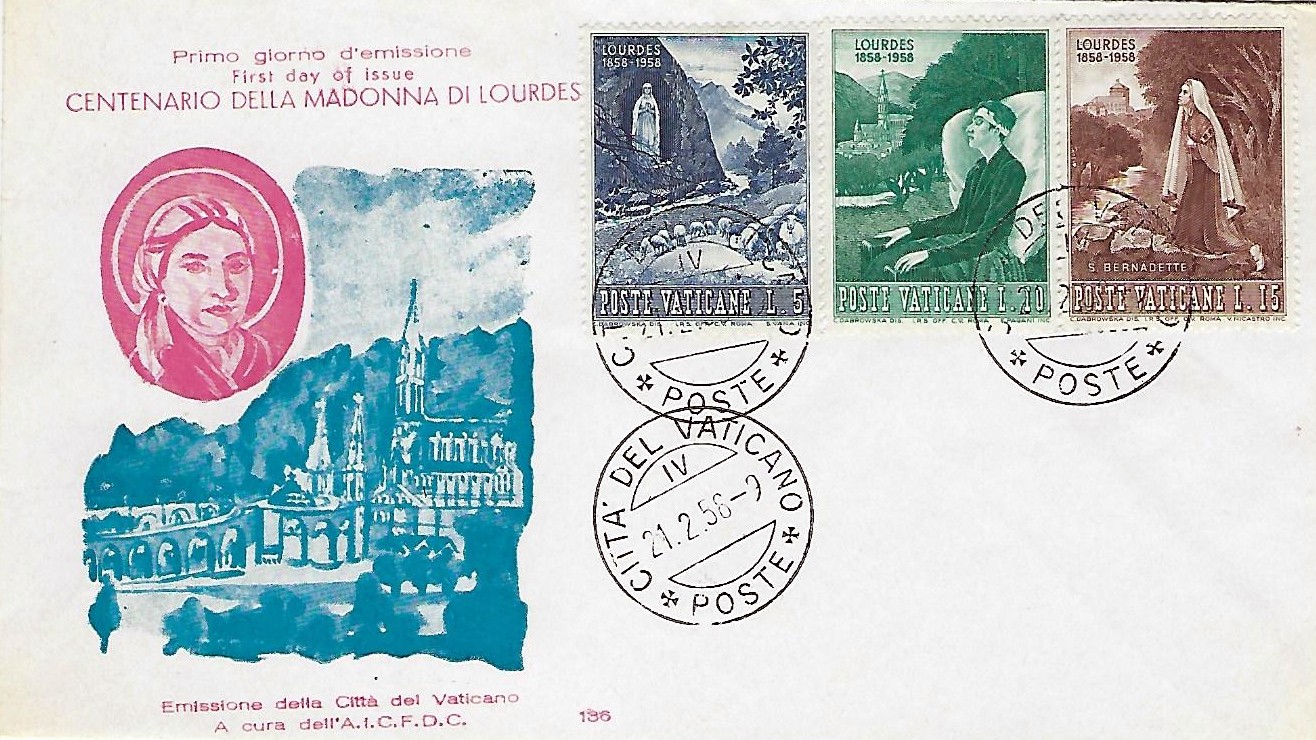
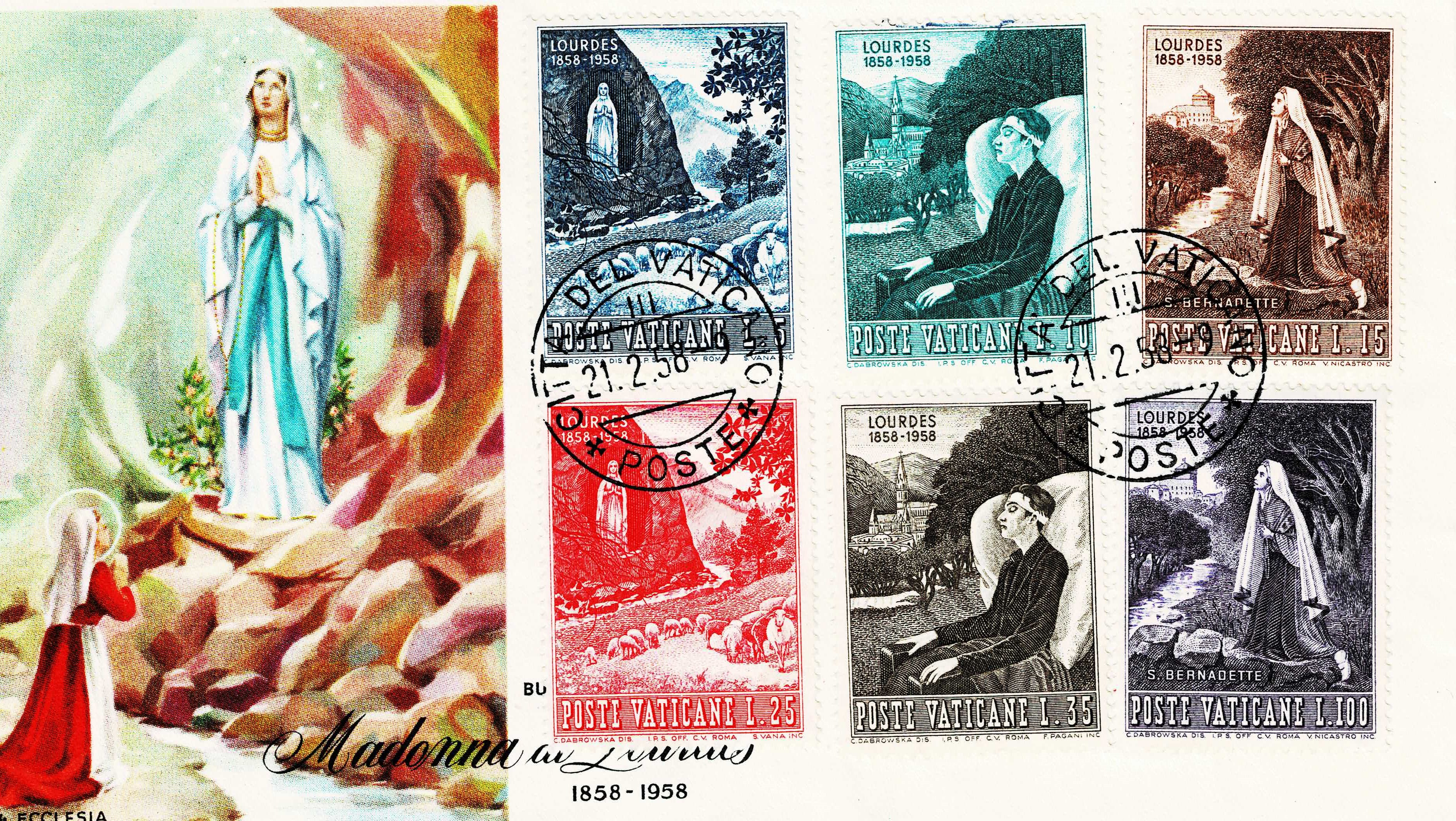




The Brussels World's Fair
On June 19, 1958, the Vatican finally released the Brussels Exhibition commemorative issue, consisting of four stamps and a souvenir sheet, the same values appearing on the four stamps of the souvenir sheet as on the individual stamps: L.35; L.60; L.100 and L.300. The35 lire value was engraved and perforated 13 1/4, while the other three stamps were printed by rotogravure and perforated 13 1/4 x14. All were printed on paper with watermarked crossed keys. The souvenir sheet was printed by engraving on paper watermarked crossed keys and perforated 12 3/4 x 13. The colors of the individual stamps are listed as: (35) wine red; (60) orange vermilion; (100) violet; (300) ultramarine. The colors of the stamps on the souvenir sheet are: (35) wine red; (60) vermilion; (100) violet; (300) blue.
The stamps were printed in sheets of 30 (6 x 5). Designed by Casimira Dabrowska, and engraved by A.Quieti Inc. for those depicting Pope Pius XII. and those of the pavilion by F.Tulli,Inc.
It was originally intended to ration the souvenir sheets, one sheet for every ten sets of stamps bought. This was abandoned due to philatelic protests, but even when released, the printing was done in such limited quantities that they were rationed one sheet with each two sets of stamps.
The souvenir sheets were printed in a sheet of four, each sheet having individual characteristics as described by Fr. Phinney ( Vol. XI, #4, p.8 & Vol. XII, #5, p.9). They are printed on paper watermarked crossed keys with the marginal watermark "STATO DELLA CITTA DEL VATICANO" perceptible on most sheets.
The Latin inscription indicates it was issued to commemorate the Universal Exposition at Brussels in which the Apostolic See participated, A.D. 1958.







Antonio Canova
The second centenary of the birth of this famous sculptor was commemorated by the issuance, on July 2, 1958, of a set of four stamps, each depicting one of Canova's masterpieces of sculpture. Inasmuch as the background of Canova has already been outlined in VATICAN NOTES in connection with the Pantheon issue, the biographical detail which follows will be that of the four popes whose images appear on the stamps.





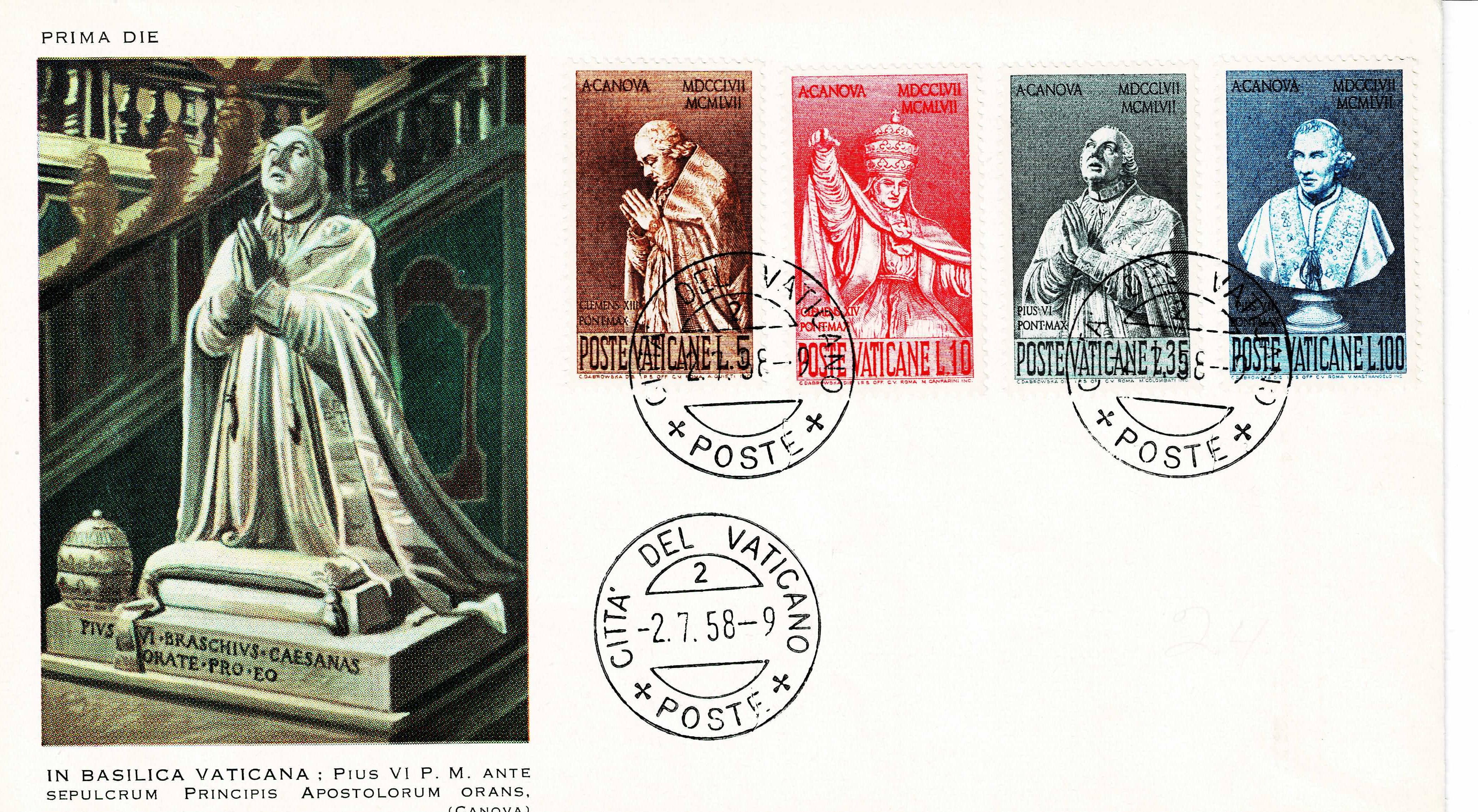








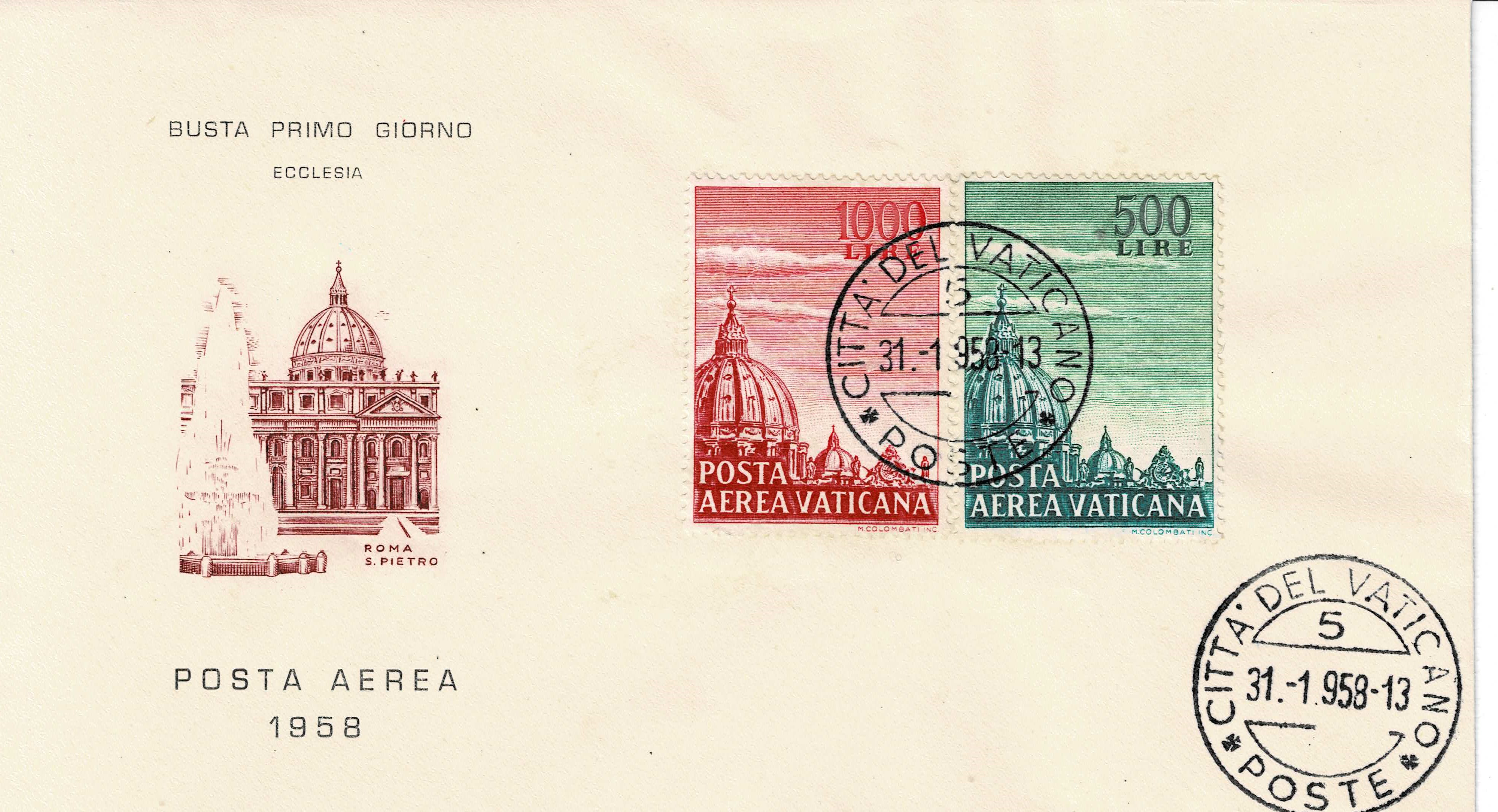





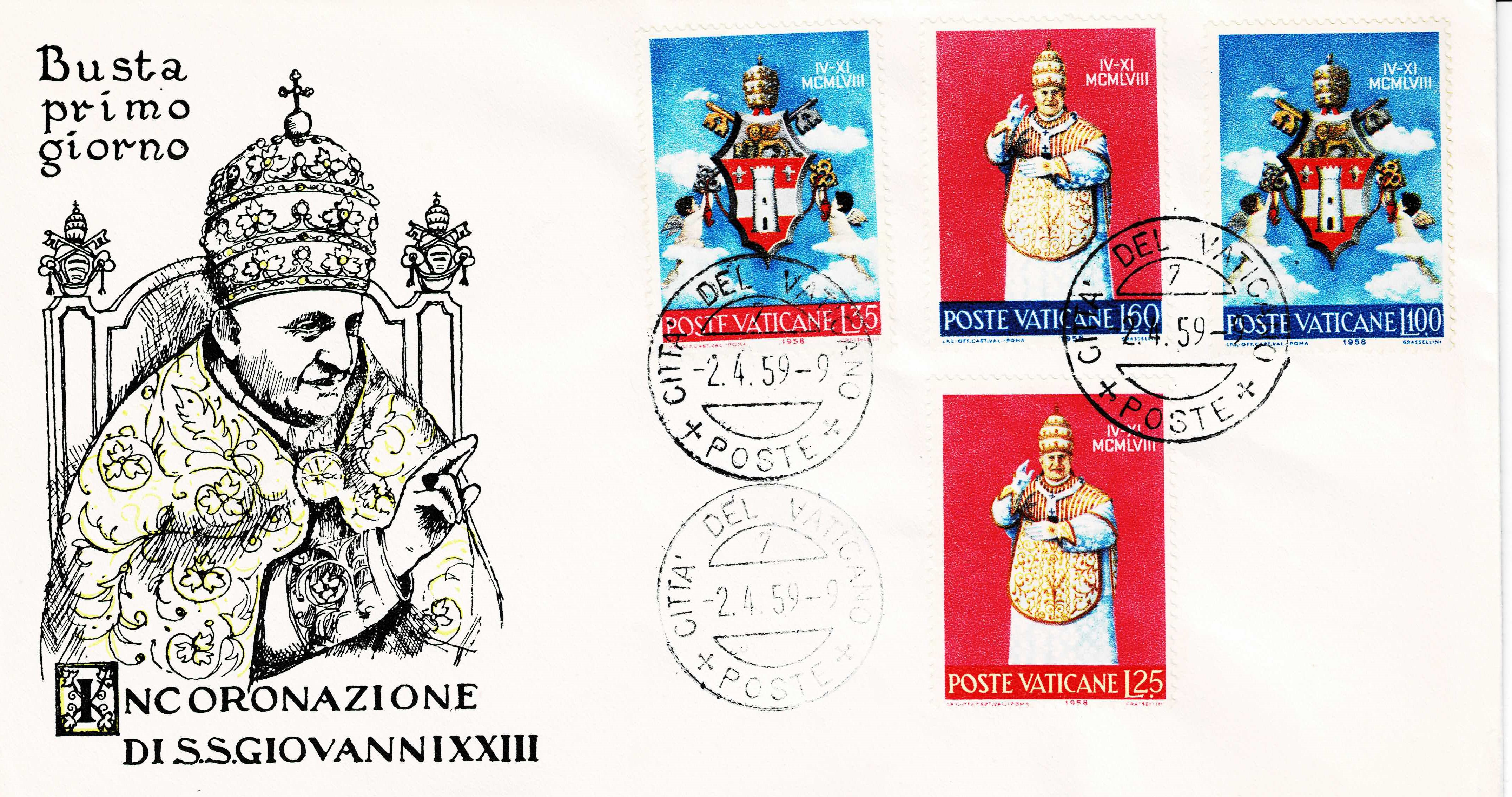











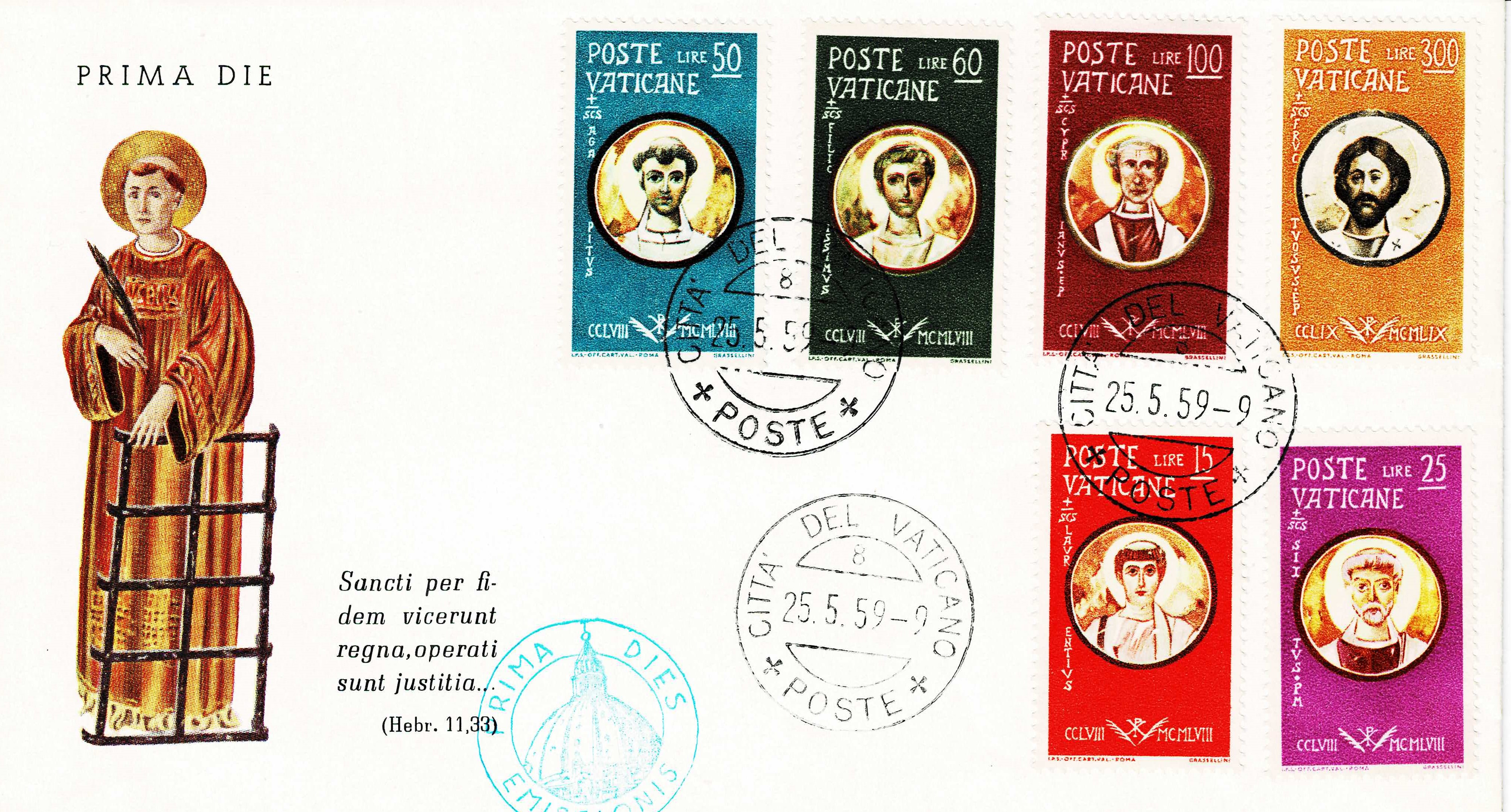



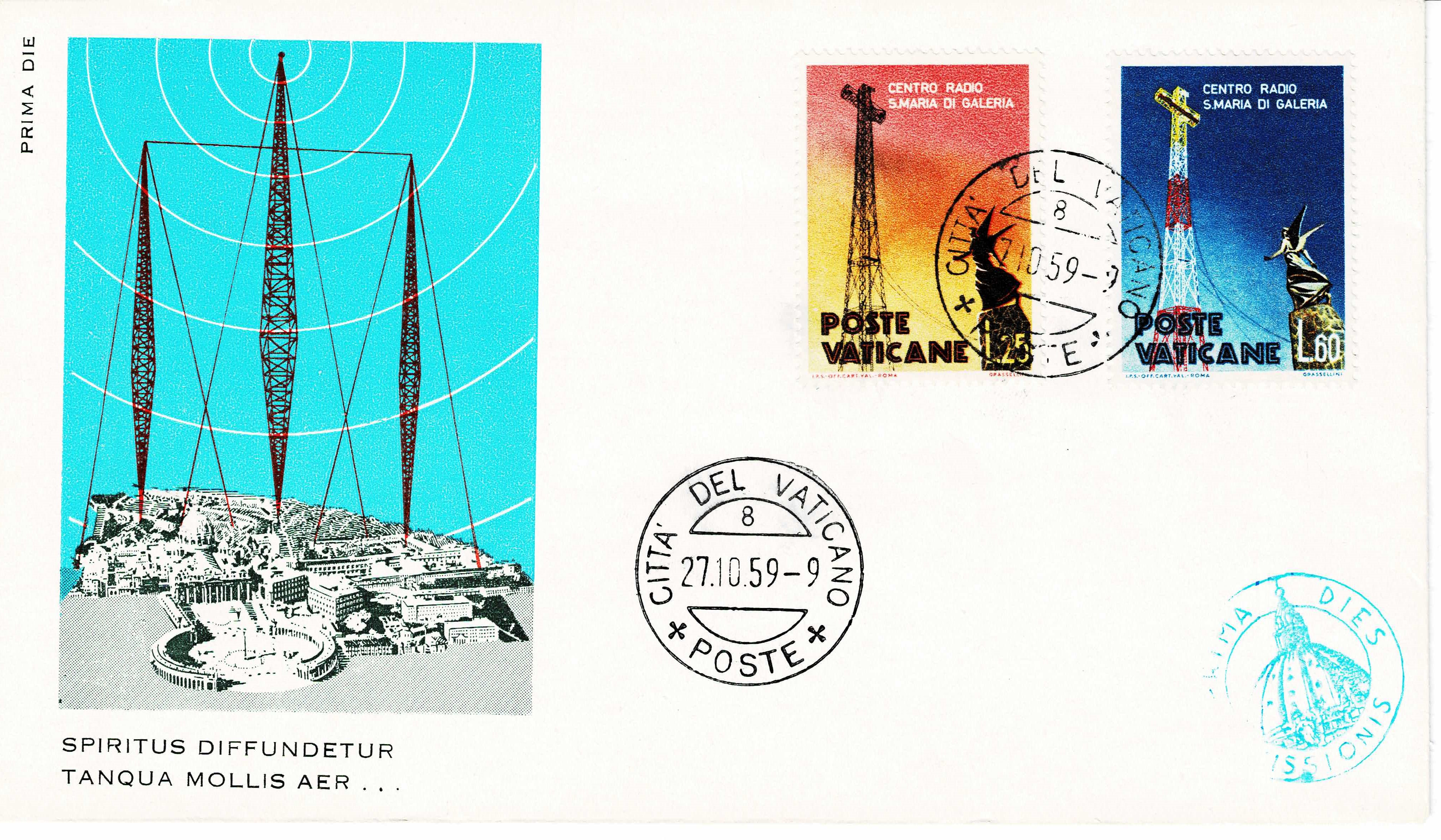

























5th Century of Death of St Antonino
Vatican City recognized St. Antonino (Antoninus) [Antonin Piarizei,1389-14591] on the 500th anniversary of his death through a set of four stamps issued 29 February 1960 (Scott 269-272). A large number of first-day covers were issued (which was typical of this era).
The stamps were designed by A. Grassellini. The £15 and £60 values (Scott 269, 271) were engraved by M. Canfarini, based upon a bust of the saint by Giovanni Dupre (d. 1882) in the Uffizi Gallery of Florence. The £25 and £110 values (Scott 270, 272) were engraved by A. Quieti and are based upon a brass relief of Antonino by Pagno di Lapo Portgioni at the Chiesa di San Marco in Florence. A total of 625,700 sets were printed by the Italian State Printers in Rome.
St. Antonino's historical context are the years of the Great Schism of the Western Church (1378-1417), the Conciliar Movement (first half of the 15th century), and the fall of Constantinople to the Ottoman Turks (1453).
St. Antonino is known as a reformer of monasteries, an Archbishop of Florence, and a writer of theology and historical works. He entered the Dominican Order in 1405. His abilities were recognized early and he undertook administration and reform duties at other Dominican monasteries in Italy. From 1433-1435 he was Vicar-General of the Dominican Congregation. He established St. Mark's Convent in Florence in 1436, known for its monastic cells decorated by Fr Angelico or his students. In 1446, Antoninus was consecrated Archbishop of Florence by Pope Eugene IV, a position he held until his death.
Antonino was known for his life of poverty, even as archbishop, as well as his generosity for the poor. Small in stature, he traveled through his diocese on foot or by mule, visiting all parishes, and preaching along the way. He helped alleviate periodic outbreaks of the plague. In his later years, he saved as ambassador from Florence to the Holy See.
Antonino served as papal theologian during 1439-1445, the later years of the Council of Florence (Basel-Ferrara-Florence, 1431-1449). He wrote theological works on morality and texts used by confessors. He also wrote a history of the world from creation to the 14th century. Pope Pius II conducted his funeral, and praised Antonino as one who had "conquered avarice and pride, was outstandingly temperate in every way, and was a brilliant theologian and popular preacher". David Farmer writes that at his death his possessions consisted of "cheap furniture" and a mule. St. Antonino was canonized in 1523 by Pope Adrian VI and his feast day is now 2 May, the date of his death.
Reference:
David Farmer, Oxford Dictionary of Saints, 5th edition, (Oxford: 2015).
(Author - James C. Hamilton, Source: James C. Hamilton, Vatican Notes, Volume 62, Issue 360, page 16-17, 2014)



The First Roman Diocesan Synod
SYNOD, meaning assembly, is a general term for ecclesiastical gatherings, and is synonymous with the word COUNCIL. However a Diocesan Synod is different from other ecclesiastical gatherings. It has only one voter and law-giver, the bishop of the diocese. In provincial or general councils, each bishop present has a vote on the matter under discussion.
Pope Benedict XIV defines a Diocesan Synod as "a lawful assembly convened by the bishop in which he gathers together priests and clerics of his diocese and all others bound to attend it, for the purpose of doing and deliberation concerning what belongs to pastoral care."
A ruling of the Council of Trent directs each diocese to hold a synod each year, but a mild interpretation of this law has been sanctioned by the Holy See. Diocesan Synods had their origin in the sixth century.
The First Diocesan Synod of Rome with Pope John XXIII present at St. John Lateran on January 4, 1960, in the choir and the transept. It consisted of three sessions, which evidently were not on succesive days, because the Synod ended on January 31, 1960, at the Vatican. A year of preparation preceeded these three days of the Synod.
It did not legislate anything, but reviewed a prospectus of more than 700 articles for future legislation. With minor changes, this prospectus eventually became the Constitution for the Diocese of Rome. It treated three general subjects: persons, pastoral action and ecclesiastical goods.
The Section on Persons emphasized the discipline of the clergy. Most of the text was given to Pastoral Action - the teaching mission of the Church, the Sacraments, the Liturgy and the Apostolate of the Laity. In this section remedies are applied to the growing problems of the City of Rome. An attempt to keep the subject matter secret until its was finally promulgated failed, since there were leaks of information.
Before 31 cardinals and scores of bishops and an assembly of 10,000, at a ceremony at St. Peters in July of 1960, Pope John gave official sanction to the Constitution laid down by the Synod. It went into effect in Rome on November 1, 1960, and has no legal effect outside the Diocese of Rome. It was published in Latin and Italian.
Numerous synods and councils have been held at the Lateran, the most memorable of which were the five General Councils of the Lateran in 1123, 1139, 1179, 1215 and 1512-17. Under Victor I (189-99) the first Roman Synod known was held. Patently this was not held at the Lateran which did not then exist as a church. Other councils were held at the Lateran in 649, 823, 864, 900, 1102, 1105, 1110, 1111, 1112, 1116 and 1725.
Two stamps of the same designs by Andreina Grassellini, L.15 and L. 60 in dark brown and gray respectively, were authorized by Ordinance XIII, Feb. 29, 1960, and the stamps were issued on that date, remaining valid for postage until January 31, 1961. They were printed by rotogravure on paper watermarked with the second type of crossed keys and were harrow perforated 14.
The picture on the stamps show the apse and triumphal arch, the main altar and baldachino of St. John Lateran Basilica at Rome. The gothic canopy or baldachino was erected under Urban V about 1366-69 either by Arnolfo di Cambio or Giovanni di Stefano at the expense of Charles V of France. It is supported by three columns of granite and one of marble. In the top of the canopy are preserved the heads of Sts. Peter and Paul enshrined in silver gilt busts.
The drapes toward the viewer of the stamp are sometimes drawn back to reveal likenesses of Sts. Peter and Paul, and the altar used by St. Peter. This wooden altar used by St. Peter and the first popes for the celebration of Mess is itself enclosed in the high altar below the canopy, which is a papal altar at which no one but the Pope or one designated by the Pope may celebrate Mass.
The mosaics in the apse behind the top of the canopy are the work of two celebrated Franciscan artists, Fra Jacopo Torriti and Fra Jacopo da Camerino, made for Pope Nicholas IV, who was himself a Franciscan, about 1280. The mosaic figure of Christ in the upper part of the vault of the apse, according to DeRossi, dates from the fourth or fifth century.
This figure of Our Lord is a memorial of a storied event which took place on November 9, 324, the day on which Pope Sylvester consecrated the Basilica to Our Blessed Saviour (San Salvador). Legend has it that at the consecration of the basilica there suddenly appeared, as though painted there, the face of the Divine Saviour, and the words of salutation were heard: "Pax vobis" (peace be to you).
Technical Details:
Scott Catalogue - 273 - 274
Date Issued - 29 February 1960
Face Value - 15 l, 60 l
Perforations - 14
Printer - The Italian State Printing Works
(Author - Unknown, From Vatican Notes Volume XVI, Number 2, September - October 1967, Pages 11-12)
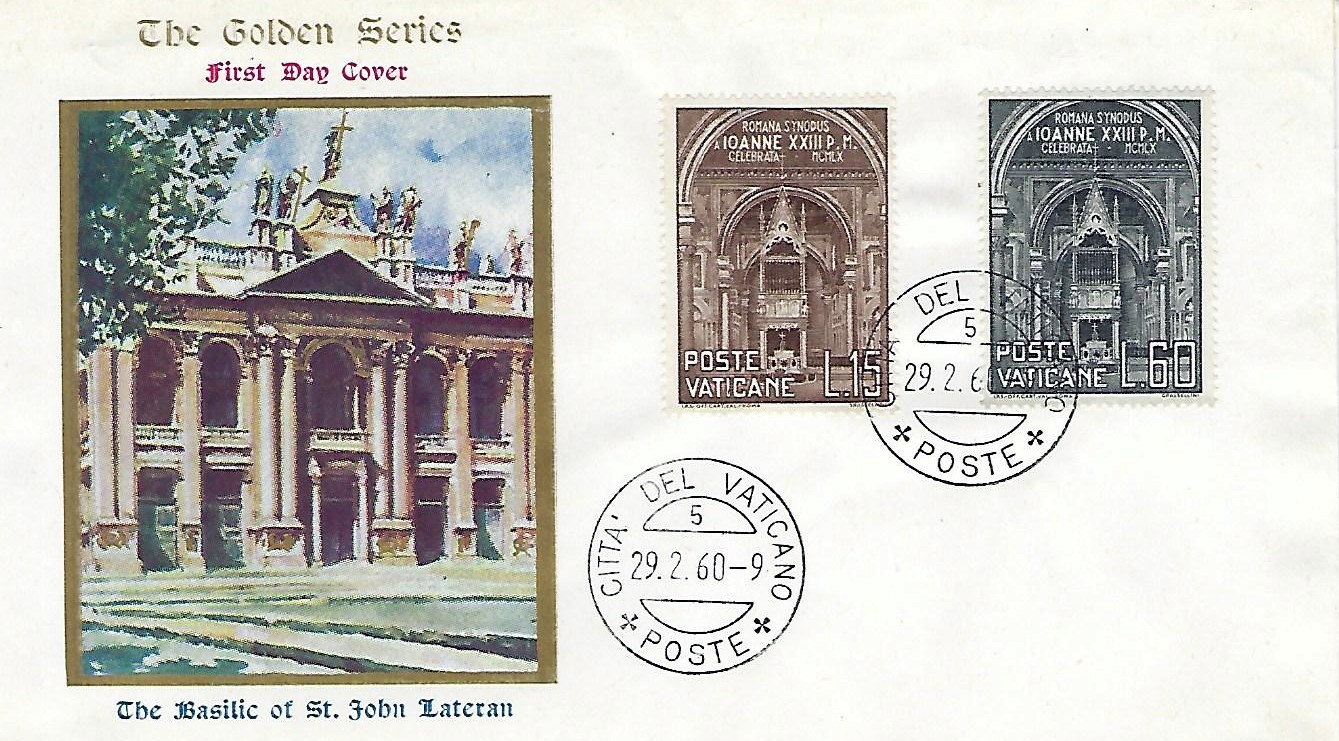







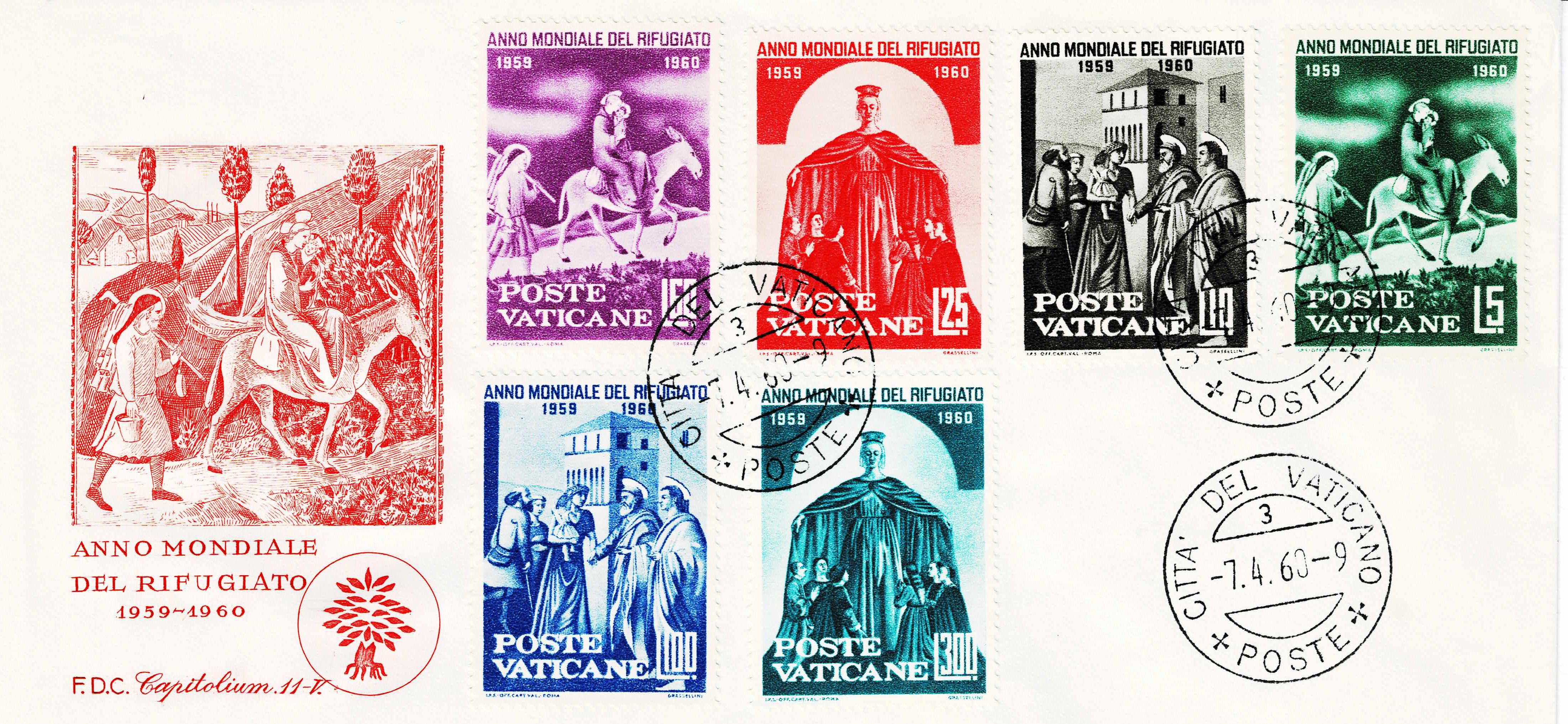



The First Anniversary Of The Transfer Of The Relics
Of Pope Pius X From Rome To Venice And Return
On April 11, 1960, three stamps were issued under Ordinance XVI of the same date to commemorate this event. The designs were by Casimira Dabrowska and the work of engraving was done by Mario Columbati (L.15), Mazzini Canfarini (L.35) and Vittorio Nicastro (L.60). The values of L.15 and L.60 were recessed printed on paper with the 01 crossed keys watermark in panes of 45 (9 x 5) and linear perforated 13 1/4. The L.35 was recess printed on paper with 02 crossed keys water-mark by rotary press in panes of 30 and comb perforated 13 1/4 by 14. There were 1,100,000 complete sets printed and they remained valid until March 31, 1961.
The L.15 stamp bears the legend; "Cardinal Joseph Sarto Departs from Venice to Participate in the Conclave". The date given on the stamp is XXVII-VI-MCMIII (June 27, 1903). According to several biographies the date should have been XXVI-VII-MCMI (July 26, 1903) and several writers in Italian stamp papers suggested that there had been a transposition of numerals in the original design which was not detected until the stamps were printed. But designer Dabrowska in a letter of Feb. 2, 1961 to the editor merely stated; "The date given is authentic".
The design on the L.I5 is modeled after "a photograph that the Vatican wanted, and sent me. Vatican left me free for the composition of the attendants of the leaving of the Cardinal, because nobody remembered who were in this time (of the leaving) near him". (Same letter). Since those who had been present were probably dead and there was no record of those in attendance available, the composition of the design was left to the artistic taste of Miss Dabrowska.
Actually, the design resembles a photo of the Patriarch before the Scuola di San Rocco in Venice, as he leaves the building of the Scuola where he has Just celebrated Mass on August 16, the Feast of St. Rocco, as it was the tradition for the Patriarch of Venice to do each year. The year of this picture in given in "Pius X" (Von Matt) as 1902, but in"Pius X" (Giordano) as 1896. A photo of the actual scene of departure from the gondola to the mole in front of the railway station is hardly artistic, because it shows the Patriarch gingerly stepping from the shaky gondola to the mole. Miss Dabrowska in using the photo supplied by the Vatican presents a much more dignified and artistic scene.
The name "Scuola" used in regards to San Rocco refers to a religious confraternity or charitable guind, which erected and occupies the building depicted. The Scuola di San Rocco was instituted in 1478 for the purpose of attending to the poor and the sick, especially those ill from the plague. Its patron, San Rocco (St. Roch, St. Rock) was born at Montpelier and on a pilgrimage to Rome in the 14th century nursed those sick of the plague while he was in Italy. The building was erected 1524-60, designed by Bartolomeo Buon of Bergamo. The great halls are decorated by 56 paintings of Tintoretto, which took 18 years to execute, and are well known to students and lovers of art.
Giusepni Melchiore Sarto was ordained a priest on September 18, 1858; he was a curate at Tombolo 1858-67; a parish priest at Salzano 1867-75; a canon, chancellor and rector of the seminary at Treviso 1875-84; the bishop of Mantua 1884-93. The Patriarchate of Venice had been vacant for three years. This post had been refused by Bishop Sarto and others, but at the direct request of Pope Leo XIII, Bishop Sarto accepted out of obedience in 1893. Because of objections from the Italian Government, he was not able to take over the See of Venice for 17 months. Italy dropped its objections on September 7, 1894, and the new Patriarch entered Venice on November 24, 1894. He learned to love the Venetians and they returned his love.
Pope Leo XIII died on July 20, 1903 and the conclave for the election of his successor was to begin cn July 31, 1903. (This makes the July 26 date more believable). Since he had been made a cardinal in mid-June of 1903, the Patriarch was due at the conclave, and with Corrowed money he bought a round-trip ticket to Rome. The crowd which gathered at the railroad station shouted: "Come back to us! Come back to us!" From the window of his coach Card. Sarto answered:"Dead or alive, I shall come back." This was on July 26. On August 4, 1903, he was elected Pope Pius X. While alive he was never able to come back to Venice, because as Pope he became a voluntary prisoner inside the Vatican, after the example set by Pope Pius IX and followed by Pope Leo XIII, in protest over the seizure by arms of the Pdntifical State by the Kingdom of Italy, a situation which remained unresolved until Pope Pius XI in 1929.
The L.35 bears the inscription: "Pope John XXIII Venerates the Remains of St. Pius X About to Depart for Venice, April 11, 1959". The body of St. Pius X left Vatican City on that date and arrived by rail at Venice on the next day, April 12. Of this scene Miss Dabrowska writes (same letter): Pope Giovanni XXIII praying at the side of the body of St. Pius X is authentic - and this scene takes place in the wagon in the Vatican City - and the date of the leaving is authentic too".
For nearly a century no pope had been buried in the crypt of St. Peters, but Pius X requested that be be interred in a secluded part of the crypt. On August 22, 1914, his body was placed in a temporary tomb marked with a cross and his name. The marble tomb in the crypt was ready in December of 1914. In 1923 the cardinals who resided in Rome introduced the cause of Pope Pius X for beatification. By 1931 the preparatory processes were finished by tribunals set up in Treviso, Mantua and Venice for this purpose. The next step was begun by Pope Pius XII with the setting up of a fourth tribunal at Rome in 1943.
In May, 1944, there was a canonical inspection of the tomb of Pius X and the body was found incorrupt, though the face was somewhat shrunken. While excavations ordered by Pope Pius XII were taking place near the tomb of St. Peter in May 1944, the body of Pope Pius X was placed in the Chapel of the Holy Cross in the right aisle of St. Peters. In June of that year it was exposed to the public view, at which time the editor viewed the body, having entered Rome with the 5th Army shortly after the fall of Rome. On July 2 the body was returned to the crypt. In 1945 the body of Pius X was brought to a tomb prepared for it in a small chapel near the Chapel of the presentation of Our Lady in the Temple, in the left aisle of St. Peters. On Sept. 30, 1950, Pope Pius XII declared Pope Pius X Venerable, and on June 3, 1951, declared him Blessed (Cf. Vol. VI #4, p.3, Vatican Notes)
A mask of silver was placed over the face of Pope Pius X and coverings of silver and bronze over his hands for the ceremonies of Beatificaion. On Feb.7, 1952, the remains of Blessed Pius X were placed in a glass casket under the altar in the Chapel of the Presentation of Our Lady in the Temple. The Bronze work on the casket was done by Francesco Nagni. The winged figures at the corners symbolize the cardinal moral virtues: Justice, Temperance, Prudence and Fortitude, while on the tablet at the base are figures representing the theological virtues of Faith, Hope and Charity.
After his canonization on Saturday, May 29, 1954, his body was taken in solemn procession, after a solemn pontifical Mass in his honor, on Sunday, May 30, to the basilica of St. Mary Major, where it lay in state for three days, a solemn triduum of thanksgiving (Cf. Vatican Notes Vol.VII #2 p.8)
The coffin appears on the stamp, and the scene from the stamp, as stated above, is from the inside of the railway coach, which took the body of Pope St. Pius X to Venice, and it shows Pope John XXIII kneeling beside it in prayer, just before the train departed from the Vatican City railway station for Venice, where Pope John himself had been Patriarch before being elected Pope
The L.60 shows the Piazzetta, or small square, between the Ducal Palace and the Library at Venice, which is an extention of the Piazza San Marco toward the canal, the principal entrance to Venice from the sea. It was from this point on the mole of the Canal San Marco that the armies of the Republic of Venice departed on their expeditions to the east, and here they returned with the spoils of their conquests. To the left of the scene on the stamp lies the Piazza San Marco and the Church of St. Mark. Across the Canal San Marco can be seen the Island and Church of San Giorgio Maggiore.
The Church of San Giorgio was begun by Palladio in 1566 and continued after his death by Antonio Palliani, who designed the facade, To the left is the campanine of 195 feet from which one gets the best view of Venice. In this church at the end of 1799 took place the conclave that elected Pope Pius VII (Scott #246) and there in January of 1800 he was crowned Pope.
The left of the picture shows the Ducal Palace, ravaged by storms and floods in November of 1966. It was built in 820 for Doge Angelo Partizipazio, the first ruler of the Venetian colonists. It was enlarged in the 12th century under Doge Sebastiano Ziani. Partially destroyed by fire in 1419, it was rebuilt by Doge Foscari. Most of the interior is decorated by famous painters including Tiepolo, Veronese, Titian, Caliari, Palma, Tintoretto, Vincenzio and Bassano. The south wing facing the canal is by Bassegio, built 1309-40. The west wing on the stamp is by Giovanni and Bartolomeo Buon, built 1424-38. The east wing toward the Bridge of Sighs was begun by Antonio Rizzo in 1484, continued by Pietro Lombardo and completed by Scarpagnini in 1549.
The stumpy effect of the lower pillars facing the Piazzetta is due to the raising of the pavement. The Palace was the official residence for the Doges, the seat of Government for the Venetian Republic and the scene of all state affairs and councils. The capitals of the 36 pillars supporting the palace have finely carved figures symbolic of vices, virtues and the planets. Story has it that in the days of the Venetian Republic, death sentences were passed while standing between the ninth and tenth pilars from the main door, which are red marble.
In the Piazzetta stand two columns brought from Constantinople in 1187. On the left column is the Lion of St. Mark with his paws on the open book of the Gospel of St. Mark, who is the parton saint of Venice. On the right column is the statue of St. Theodore, patron saint of the Venetian Republic, who was a soldier in Asia Minor. Be is represented with sword and shield, his foot on a crocodile. Since a legend which predates that of St. George has St. Theodore fighting with the dragon, one wonders if the crocodile is meant to represent a dragon. At one time there stood between the two columns a scaffold for the execution of criminals.
The Body of St. Pius X arrived in Venice by train on April 12, 1959, and was carried by the Great Gondola or Barge from the railway station up the Grand Canal to the Canal San Marco and the body was disembarked as we see it on the stamp. In the procession which accompanied the body to the Church of St. Mark can be seen bishops, diocesan priests and religious, members of the Noble Guard and the faithful. At the side stand members of the Italian Carabinieri at present arms.
The body of Pope St. Pius X remained in Venice for a month, allowing sufficient time for all to see and venerate it. Then it was returned to Rome on May 11, 1959, and it was replaced in St. Peters Basilica. Alive, Cardinal Sarto could not fulfill his promise given at the railway station: "Dead or alive, I shall be back." But in death his promise was kept by the return of his relics to his beloved Venetians, now the relics of a saint.
Technical Details:
Scott Catalogue - 281 - 283
Date Issued - 11 April 1960
Face Value - 15 l, 35 l, 60 l
Perforations - 13
Printer - The Italian State Printing Works
(Author - Unknown, From Vatican Notes Volume XVI, Number 3, November - December 1967, Pages 5-7)

























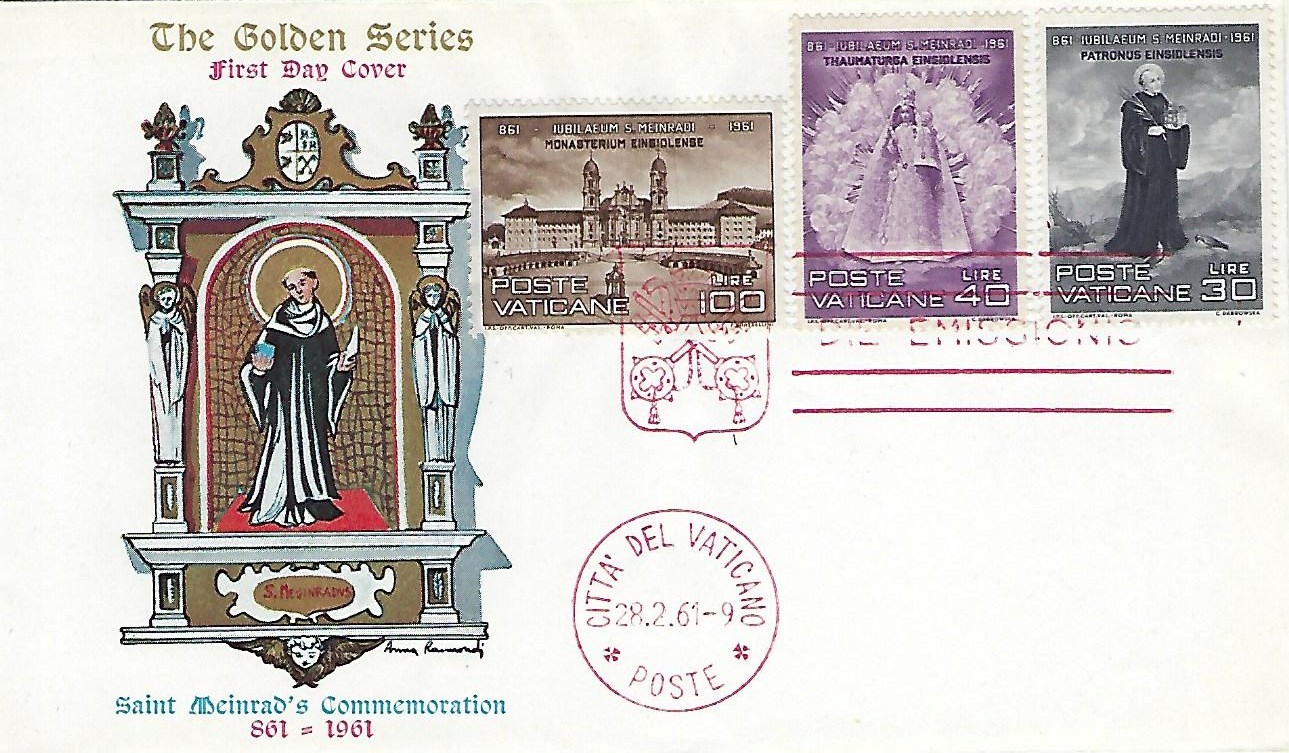















St. Patrick, Apostle of Ireland
St. Patrick, Apostle of Ireland, was born about 387 A.D. at Bannavem Tabernise, variously assigned to England, Scotland, France or Italy, of Calpurnius and his wife, Conchessa. He died at Saul, Downpatrick, Ireland, March 17, 461 A.D. At the age of sixteen he was captured by Irish raiders and brought to Ireland where he was sold as a slave to Milchu of Dalaradia (County Antrim). For six years he tended flocks in the valley of the Braid and the slopes of Slemish, near the present town of Ballymena. Patrick, the slave, prayed constantly and his Faith grew within him, He acquired a facility with the Celtic language, learned the political framework of Ireland, and from his master, a druidic priest, came to know Druidism, the pagan religion of Ireland. At the end of six years he escaped to Westport on the northwest coast and found a ship to Britain, and thence home.
He is said to have studied at the monastery of St. Martin of Tours and on the island of Lerins, off Cannes, from 412-415, and was ordained a priest by St. Germanus (Germain) of Auxerre, under whom he worked for some years. St. Germain was commissioned by the Holy See to combat the heresy of Pelagianism in Britain and chose Patrick as a companion. In Britain he had a vision of some youths of Focluth crying yo him: "O holy youth, come back to Erin and walk once more amongst us". Pope St. Celestine I had commissioned Palladius as a missionary to Ireland, but he was apparently frightened by a Wicklow chieftain, and abandoned his mission to die among the Picts of Northern Britain a year later. Patrick was chosen to be his successor. It is said that Pope St. Celestine I bestowed the name PATRICK on him: Patercius or Patricius (Pater Civium) meaning "Father of the People". Patrick was consecrated bishop in 432 either by St. Germain of Auxerre or St. Maximus of Turin, Italy.
Probably in the spring of 433 Patrick and his companions landed at the mouth of the Vantry River near Wicklow Head, and intending to visit his old master, Milchu, went north along the coast to the mouth of the River Boyne. Heading inland he was stopped by a chieftain, Dichu, whom Patrick converted, and from whom he received a small barn, which became the first church in Ireland. Going on toward Slemish, he heard that his old master at Dalaradia, upon hearing of Patrick's approach, set fire to his house and perished in the flames apparently a suicide. After this incident some say that Patrick went to Ulster, others that he returned to Saul, where his first church was. He heard that the High-King of Ireland, Leoghaire, had called a meeting of all Irish chieftains at Tara in Meath. Thinking that this was an opportunity to address the assembled chiefs, Patrick set out for Tara to attend the meeting, which was set for Easter Sunday, March 26, 433. The King had decreed that no fires were to be kindled in all Ireland until the druids had lighted their fire on Tara, the morning of March 26. Patrick arrived at the Hill of Slane at the opposite end of the valley from Tara on March 25, Holy Saturday, and the Feast of the Annunciation of the Blessed Virgin Mary., and in celebrating the Easter Vigil ceremonies, lighted the Paschal Fire, which was seen from Tara, incurring the death penalty for this act. The druids informed the King of the fire on the Hill of Slane, and told him that if this fire were not extinguished that night, the flame would never be extinguished in Ireland. The King and his men with the druids came to Slane, but neither could they extinguish the Pascal Fire nor punish Patrick for having violated the royal command.
On Easter Sunday, Patrick came to Tara in his episcopal robes and confounded the demoniacal power of the druids and received from King Leoghaire permission to teach Catholicism in Ireland.
The order of Patrick's missionary efforts is not certain. Some say that from Saul he went to Ulster, then to Tara in Meath, then to Leitrim, then Connaught, returning to Ulster, then to Leinster, Meath and Munster. The other sequence finds him starting from Saul to Tara in Meath, beginning the conversion of Meath, followed by seven years in Connaught, then to Ulster, followed by Meath, Leinster and finally Munster. The Annals of Ulster, relate that the Primatial See of Armagh was founded in 444 by Patrick, and it is recorded that in 440 he was given a piece of land, the site of the Cathedral of Armagh.
In all of his journeys it is said that he performed numerous miracles (none of which mentions the driving out of snakes from Ireland). He left a string of bishoprics behind him, and he retrod his steps the length and breadth of Ireland, converting, revisiting, consolidating and revisiting again.
From time to time he would draw aside for a spiritual retreat. One of his favorite places was the island in Lough Dergh, called St. Patrick's Purgatory, because of the severe penances Patrick inflicted on himself. Even today one who visits this sanctuary can only do so by observing strick fast and silence. Another place was Croagh Patrick in Connaught a mountain where Patrick prayed for Ireland during forty days and forty nights toward the end of his life.
In his first visit to Connaught Patrick converted Ethne and Fedelm, two daughters of High-King Leoghaire. The use of the shamrock to illustrate the doctrine of the Holy Trinity on this occasion is called by some an accretion of a later date.
The conversion of Ireland was no triumphal procession. There was no persecution of the infant church, but Patrick himself was the object of attack by druids and enemies of the True Faith. Twelve times he and his companions were seized and carried off, and on one occasion condemned to death. Patrick's chariot driver was slain in an ambush set for Patrick. When Patrick died, not all of Ireland was converted to Catholicism, but the groundwork had been laid. Patrick had consecrated 350 bishops in Ireland and had established the dioceses in which he placed them. There is a story that as death approached, Patrick in vision saw Ireland aglow with the light of Faith, and it continued for centuries, but faded into only a glimmer. Patrick prayed that the Faith would never die out, and God sent an angel to tell him: "Fear not: your apostolate shall never cease." Patrick died March 17, 461 at Saul and was buried in a fort two miles distance from his first church, over which rose later the Cathedral of Down.
Four stamps were issued on October 6, 1961 to commemorate the 1500th anniversary of the death of St. Patrick. Two values (10 & 40 Lire) show an ancient medieval statue of St. Patrick, and bear the inscription "St. Patrick, Apostle of Ireland". The other two values (15 & 150 Lire) show the "Sanctuary of St. Patrick" at Lough Dergh. They were designed by Edmondo Pizzi, printed by rotogravure on paper with the second crossed keys watermark and are perforated 14.
This article originally appeared in Vatican Notes, Volume XIV, Number 5, pp. 11-12, March - April 1966. It has been lightly edited. The original article may be accessed by clicking on the link below.
REFERENCES:
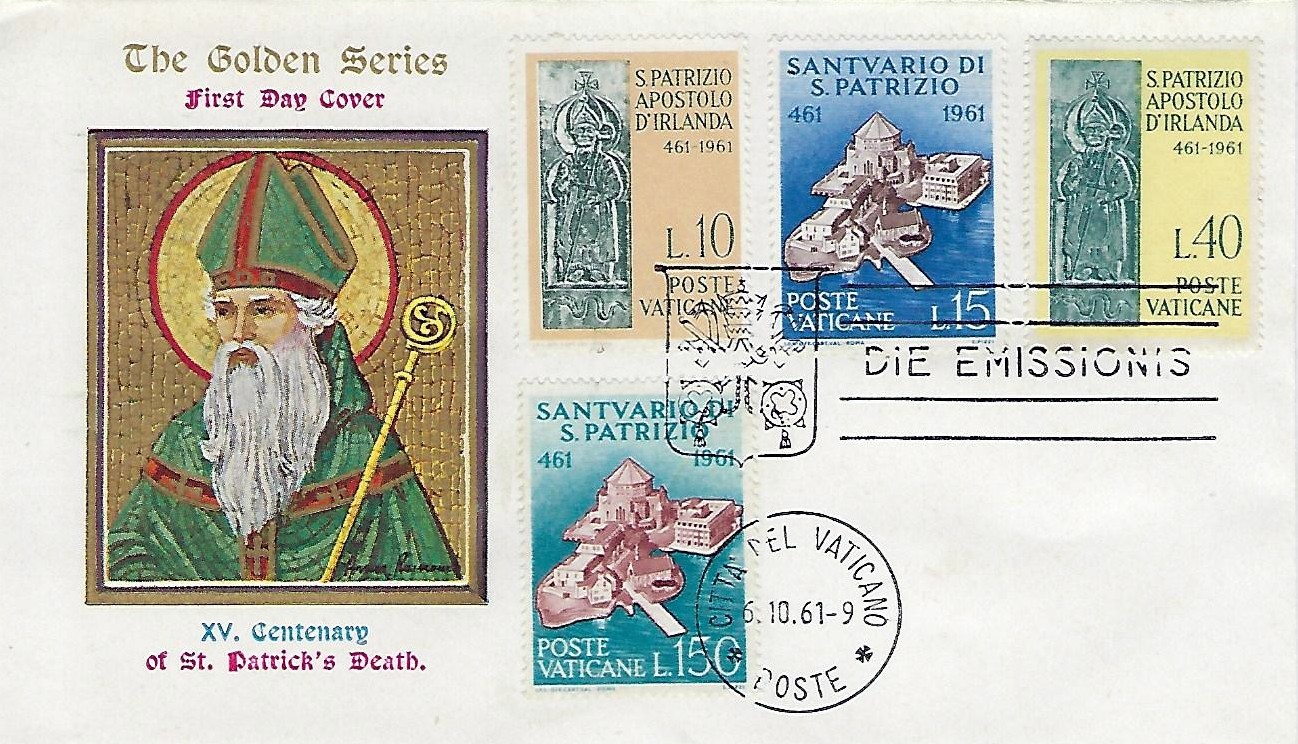






Eightieth Anniversary of the
Birth of Pope John XXIII
L.10. The Coat of Arms of the Roncalli Family.
The Roncalli family first came to Sotto Il Monte in 1420, when the founder of the family moved from Valle Imagna. His name was Martha's Roncalli, called Maitinus. Attempts have been made to link these Roncallis with the Roncalli Family of Bergamo, which was prosperous and attained to noble rank. This Pope John XXIII discounted.
Lire 25. The Church of the Baptism of Pope John XXIII.
On the night of November 25, 1881, the first son was born to Giovanni Battista Roncalli and his wife, the former Mariana Mazzola, their third child. The Pious mother insisted that the infant be wrapped in warm clothing and be taken to church for immediate baptism. There was a wait for the priest who was rather reluctant to venture out on that cold and rainy evening. But the child's father insisted: "We have been waiting a long time for him and we want him baptized tonight." So in the Church of St. Mary in Briscio, in the Commune of Sotto II Monte, Angelo Giuseppi Roncalli was baptized. As a priest, as an archbishop and as Patriarch of Venice, he often returned to Sotto II Monte to spend a few quiet days with his family and at these times celebrated Mass in the church of his baptism. The Church of St. Mary is shown on the stamp as well as the date of his baptism. The First Day of Issue of this set of stamps was actually the 80th birthday and 80th anniversary of the baptismal day of Pope John XXIII.
Lire 30. The Church of the Ordination to the Priesthood of Pope John XXIII.
At the age of twenty-three, having completed four years of theological study at the Collegio Ceresoli in Rome, Angelo Roncalli was ordained a priest on August 10, 1904, in the Church of Santa Maria in Monte Santo (St. Mary on the Holy Mount) in the Piazza del Popolo, Rome, by Bishop Cepperelli, Vicar of Rome. On August 11 he celebrated his first private Mass at the tomb of St. Peter, and the same day was presented to Pope Pius X, who encouraged him to be a credit to the priesthood and a consolation to the Church of Cod. He returned to Sotto Il Monte to celebrate his first Solemn Mass for his family and friends in the Church of St. John the Baptist.
Santa Maria in Monte Santo is one of the twin churches which stand at the head of the Corso in the Piazza del Popolo. (Cf. VATICAN NOTES, Volume XI, Number 1, Page 9- the July-August Issue of 1962). The other is dedicated to St. Mary of the Miracles. They appear on the design for the 25 and 100 Lire stamps of the Obelisk air mails, illustrated in the Notes at the given citation. Santa Maria in Monte Santo is on the left. Both churches are octagonal in shape, and were said to have been built to replace two chapels which had stood at the head of the Bridge of Sant'Angelo, and which were destroyed because the troops of Charles V had used them as outworks in their attack on Castel Sant'Angelo during the Sack of Rome in 1527.
Alexander VII had begun their construction and they were completed by Cardinal Castaldi, the treasurer of Pope Alexander VII, after the Pope's death. A legend tells that a woman had saved for many years and willed 150 Saudi for the completion of the churches. They date from the second half of the seventeenth century, with domes and vestibules designed by Rinaldi and completed by Bernini and Fontana. In a chapel to the left of the main altar in Santa Maria in Monte Santo is a painting by Carlo Maratta (Virtuosi of the Pantheon Set of 1944) of St. James and St. Francis with the Blessed Virgin.
Lire 40. Church of the Archepiscopal Consecration of Pope-John XXIII.
A special representative was needed by the Holy See for the turbulent Balkans, who could deal with catholic problems with decision and delicacy. Cardinal Tacci, Prefect of the Congregation for Oriental Affairs, placed the name of Msgr. Roncalli before Pope Pius XI, who appointed him to the position. According to customary practice, anyone assuming an important position in Vatican diplomacy was designated at least an archbishop, and so Msgr. Roncalli was named Archbishop of Aeropolis, a Titular See. The designation "Titular See" refers to an ancient bishopric or archbishopric, which now has no catholic population to require the incumbent's presence, e.g. the ancient sees of North Africa.
The consecration of Msgr. Roncalli took place on the Feast of St. Joseph, March 19, 1925, in the Lombard National Church, St. Charles Borommeo on the Corso (San Carlo al Corso). The consecrator was Giovanni Cardinal Tacci, and the co-consecrators were Bishop Police, Vice-General of Rome, and Bishop (Later Cardinal) Marchetti-Selvaggiani, Secretary of the Congregation for the Propagation of the Faith. Present was the Bishop of Bergamo, as well as the family of Archbishop Roncalli, and a delegation of the clergy from Bergamo. His first Pontifical Mass was celebrated the following day on the tomb of Peter, to reaffirm his fidelity to the Chair of Peter.
The site of San Carlo al Corso was for a long time the location of the national church of the Lombards. At one time there had stood there a church named in honor of St. Ambrose, Bishop of Milan, which was razed in 1651 to make way for the new church named after an Archbishop of Milan, St. Charles Borommeo. This is probably the reason that the names of St. Ambrose and St. Charles are linked on the stamp. The new church has a heavy, poorly proportioned facade and was erected either under Onorio Lunghi or Martino Lunghi, and completed by Pietro or Piero da Cortona. Over the high altar is one of the finest paintings of Carlo Marotta (Virtuosi of the Pantheon 1944) depicting St. Charles in glory with St. Ambrose and St. Sebastian. Under the main altar rests the heart of St. Charles.
Lire 70. Election of Angelo Roncalli as Pope.
The election of Cardinal Roncalli to be Pope John XXIII is recalled by the Altar of the Chair of Peter, since as Bishop o Rome, John XXIII succeeded to the episcopal chair of Peter on October 28, 1958.
At the time that Bernini was constructing the colonnade around St. Peters Square, he was designing a monument to the Chair of St. Peter, which was to be placed in the apse of St. Peters Basilica to enshrine the episcopal chair used by the first pop Originally this chair was of plain oak, but its front and back had been decorated with antique ivory tablets in the ninth century. Rings had been added to admit staves, so that it could be used as a sedia gestatoria. It had stood in the Baptistry of Pope Damasus in the Old St. Peters Basilica and was the obj of veneration before the third century, when the Feast of the Chair of St. Peter was observed on February 22. Urban VIII had it decorated and placed in the new baptistry. Innocent X had placed it in a bronze reliquary.
Bernini sketched a small model from which his pupils constructed a larger one. Ws on it began in 1657 and the casting was completed in 1665. It required 191,383 pounds of bronze, more than was needed for the baldacchino. Giovanni Artusi da Piscine directed its casting and Carlo Mattel its guilding. In 1666 on January 18 the present date of the Feast of the Chair of St. Peter, the venerable chair was carried into the choir apse and enclosed in Bernini's monument. The base of this huge bronze is of multicolored marbles, with the statues of St. Augustine and St. Gregory, Latin Fathers, and St. Athanasius and St. John Chrysostom, Greek Fathers, supporting it.
Lire 115. Portrait of Pope John XXIII
References here given to VATICAN NOTES give biographical information about Pope John XXIII which it is not necessary to repeat here.
Volume VII, Number 6, Page 5.
Volume X, Number 3, Page 1.
Volume XII, Number 1, Pages 1 to 4.
Technical Details:
Scott Catalogue - 317 - 322
Date Issued - 25 November 1961
Face Value - 10 l, 25 l, 30 l, 40 l, 70 l, 115 l
Perforations - 14
Printer - The Italian State Printing Works
(Author - Unknown, From Vatican Notes Volume XIV, Number 2, September - October 1965, Pages 10-11)









Malaria Issue
Ludwig von Pastor in his 'History of the Popes" gives accounts of the efforts of Pope Sixtus V (Vol. XXI) and Pope Pius VI (Vol. XXXII) to drain the Pontine Marshes. The first attempt in point of time was made by Pope Sixtus V (1585-1590) who turned his attention to the unhealthy swamps of Chiana near Orvieto, those at the mouth of the Tiber River, swamps near Ravenna and especially to the Pontine Marshes. The Pontine Marshes are situated south of Rome between the Alban and Volscian Hills and the sea. The problem of draining these marshes had had the attention of the Romans two centuries before Christ. Julius Caesar and the Emperors Augustus and Trajan had attempted to drain the water from the marshes, as had King Theodoric of the Goths, and several popes, especially Pope Boniface VIII (see 1949 Holy Year stamp) and Leo X who wished to reclaim this district for purposes of agriculture.
Failure of others did not hold back the energetic Sixtus V from making an attempt to dry out the marshes to free them from malaria and make them fit for agriculture. He felt that from the reclaimed lands enough corn would be produced to remedy the periodic scarcity suffered by Rome, and that it would be a help to the Apostolic Camera. He became enthusiastic over a plan presented to him in the spring of 1586 for the draining of the marshes by Ascent° Fenizi, an engineer from Urbino. One of the principal obstacles encountered by his predecessors and successors was the opposition of the great landowners, who were interested in maintaining the existing state of affairs. Fabio Orsini was entrusted with this problem and was quickly successful in dealing with it.
Ascenio Fenizi obtained from the Pope all those lands between Terracina Pipero and Secce which had not been cultivated for the preceding five years, in order that he might drain them and put them under cultivation. Fenizi and his heirs, as long as the work went on, were to pay to the owners each year whatever the land in question had hitherto produced. Once the draining was accomplished, they either went on paying this sum or were to hand over land to an equivalent value from the rescued district. Fenizi, after the work was finished, was to pay 5-1/2% of the revenues from the land placed under cultivation to the Apostolic Camera which, at the discretion of the Pope, was to be divided among the interested parties according to their shares in the cultivated land.
Fenizi was given full power to widen existing waterways, making new channels and canals to the sea, provided he compensated the owners. As the undertaking involved a large expenditure, and the advantages accruing should be very great, the privileges granted to those who helped in the promotion were never to be suspended.
Because of the malaria which was rampant in the Pontine Marshes during the summer, the work was not started on a large scale until autumn of 1586 with the employment of 2,000 workmen. The plan called for bringing the waters of the mountain streams which fed the Marshes, which stopped in the so—called Piscinara in the Fiume Antico, through a new way to be opened which was to enter the sea between Terracina and Cape Circe. All the proprietors of the Pontine Marshes who were to benefit by the project were invited in February, 1587 to contribute to the expense. There were reports of good progress in January, 1588, and in 1589 the works were practically finished. The large outlet which took a great volume of water to the sea was named Fiume Sisto after the Pope, and another smaller channel was planned beside it. Considerable acreage had been reclaimed which was found quite suitable for agriculture. On receiving this news, Pope Sixtus V decided to visit the works, which were regrettably to be abandoned after his death. On the eleventh of October, 1589, he set out with a large retinue to Terracina, passing through Marino, Velletri, Sermonetta and Sezze. Three kilometers west of Sezze at the foot of the hills of Trevi there is a stone which still bears the name *Stone (seat) of Sixtus' where he rested from his journey and looked out over the drainage works. The medal which appears on the 15 Lire and 70 Lire stamps commemorates the great project.
The work of Pope Pius VI came about 190 years later. He had been the Auditor of Cardinal Ruffo at Velletri and had first-hand information about the Pontine Marshes and the various plans for their drainage. Soon after his election to the papacy he consulted experts on the possibility of draining the malaria-infested stretch between Cisterns. and Terracina and by early 1777 had decided to carry out this vast undertaking, which would be of great economic importance as well as being a great stride in public health. Gaetano Rappini, an engineer of Bologna, drew up a plan which was approved by two other engineers and work began in the autumn of 1777. Water coming from the hills was to be carried in a canal known as the Linea Pia, running parallel to the Via Appia, and was to be discharged into the sea at Terracina. The work continued rapidly and a large area was dried out by October, 1778. So that the Apostolic Camera would not be financially over-burdened, a stock company was formed with a capital of 120,000 scudi, but by May of 1779 it was found that a greater expenditure would be necessary, which led to much opposition. Pius VI would not be deterred, and was encouraged by a dry summer in 1779 which rendered the work easier; however, in November great rainfalls did considerable damage which hearsay exaggerated. Despite the risk of malaria, Pius decided to visit the works and find out just how much damage had been done. On April 6, 1780 he set out for Terracina and took up residence in the Palazzo Vitelli. Since no pope since Benedict XIII had journeyed further south in this direction than Castel Gandolfo, people flocked from all sides to greet him.
The original course of the canal had to be diverted, but with satisfactory results. Considerable acreage was reclaimed and the Pope returned to Rome in a happy frame of mind. He repeated his inspection in April, 1781, but was unable to come there in the following year because of his visit to Vienna. He came again in April, 1783 and returned satisfied with the results, even though floods had done some damage. The cost of the drainage, which employed 3,500 men, caused much ad-verse criticism but Pius VI was not deterred because he saw great benefit and much profit would come when the project was completed. With the exception of 1791-1793 the Pope made this his spring holiday and from 1784 to 1796 he annually inspected the works, which time and again were held up by floods. The total amount expended over the years was 1,500,000 scudi, but in the end all that was gained was a reduction of the marshy area and not its elimination.
The transformation of the Pontine Marshes into arable land remained a pious hope for more than a hundred years. Even in the early 20th century the Italian Government was not successful in its first efforts with modern equipment. Eventually the problem was solved under Mussolini. The achievements of Pius VI which his enemies tried to minimize or deny, have been judged by impartial critics of this century to have been considerable.
On the 40 Lire and 300 Lire stamps appears a map of the project of Pius VI, on which can be distinguished the drainage canals, the Via Appia and the Linea Pia running parallel from Treponti to Terracina. Both designs bear the inscription at the top "All Peoples Against Malaria", and the efforts of the two Popes, Sixtus V and Pius VI, were not only to reclaim the Pontine Marshes for agricultural use but to eliminate malaria. With Vatican City State such a small area, there is no malaria problem to be solved there, but the efforts of the papacy in centuries past to eliminate this disease are recalled by the stamps, issued as part of the worldwide campaign against malaria.
Technical Details:
Scott Catalogue - 326 - 329
Date Issued - 06 April 1962
Face Value - 15 l, 40 l, 70 l, 300 l
Perforations - 14
Printer - Instituto Poliguafico di Stato, Rome
(Author - Unknown, From Vatican Notes Volume X, Number 6, May - June 1963, Pages 3 - 4)






Priestly Vocations
The set of five stamps shown above was issued on June 12, 1962 for the purpose of stimulating interest in vocations to the priesthood and the religious life. Three of the stamps bear a representation of a 4th-century statue of the Good Shepherd, presently located in Rome at the Lateran Museum. To the right of the figure appear the words "The priest, another Christ" in Latin. The other two stamps show a field at harvest time. These bear a Latin inscription which means "Pray the Lord of the harvest to send forth laborers unto His harvest."
Issuance of this set follows the first International Congress on Priestly Vocations at the Vatican, which was attended by more than 400 laymen, priests and bishops. Meeting in the Vatican's Consistorial Hall, this group concluded its deliberations with an address in Latin by Pope John XXIII.
Technical Details:
Scott Catalogue - 330 - 334
Date Issued - 02 June 1962
Face Value - 10 l, 15 l, 70 l, 115 l, 200 l
Perforations - 14
Printer - Vatican Polyglot Press
(Author - Unknown, From Vatican Notes Volume XI, Number 1, July - August 1962, Page 1)




St. Catherine of Siena
The fifth centenary of the canonization of Saint Catherine of Siena was commemorated by the issuance, on June 12th, 1962 of the set of three stamps shown above. The design is identical on each of the stamps, and shows St. Catherine praying for the soul of an executed criminal. Source of the design was the painting by Giovanni Antonio de Bazzi Sodoma (1477 - 1549) which hangs in the Church of Saint Dominic in Siena. The painter's name appears on each stamp in the lower right margin.
St. Catherine was born on March 29, 1347, the youngest of twenty-five children, of whom only thirteen survived. She died at the age of 33 after a life of mortification, self-sacrifice and service. Although unable to write, she left nearly 400 dictated letters which have become a treasure of Italian literature. Her most important work was the "Dialogo" (Book of the Divine Doctrine) which she dictated in 1377. She was declared a patron saint of Italy in 1939.
Italy, in 1948, commemorated the sixth centenary of the birth of Saint Catherine by the issuance of a set of 4 and 2 airmail stamps. They were designed by Corrado Mezzana, whose work on Vatican City stamps is well known, and collectors will find in them a suitable complement to the St. Catherine set.
Technical Details:
Scott Catalogue - 335 - 337
Date Issued - 12 June 1962
Face Value - 15 l, 60 l, 100 l
Perforations - 14
Printer - The Italian State Printing Works
(Author - Unknown, From Vatican Notes Volume XI, Number 1, July - August 1962, Page 2)




Pauline Jaricot
July 5 1962 was the issue date of the set of three stamps shown above. This set commemorates the centenary of the death, in 1862, of Pauline Jaricot, French foundress of the Society for the Propagation of the Faith. The stamps reproduce a portrait of Pauline Jaricot which currently hangs in the Great Hall of the Superior Council of the Pontifical Organization for the Propagation of the Faith in Rome.
The portrait was commissioned by Pope John XXIII in 1921 when, as Msgr. Angelo Roncalli, he headed the Italian branch of the Society for the Propagation of the Faith.
The stamps measure 30 x 40 mm. and were printed by rotogravure on paper watermarked with the crossed keys design. Printing was done by the "Istituto Poligrafico dello Stato Italiano" in panes of 40 subjects each.
Marie-Pauline Jaricot was born at Lyons, France on July 22, 1799. Even at an early age she was exceptionally pious, and while still in her teens worked actively among her friends and countrymen to stimulate interest in missionary work. She remained actively interested in the missions throughout her life, and in 1822 founded the Society for the Propagation of the Faith. Four years later she founded the lesser-known Association of the Living Rosary. She died on January 9, 1862.
Technical Details:
Scott Catalogue - 338 - 340
Date Issued - 05 July 1962
Face Value - 10 l, 50 l, 150 l
Perforations - 14
Printer - Instituto Poliguafico di Stato, Rome
(Author - Unknown, From Vatican Notes Volume XI, Number 1, July - August 1962, Page 6)





THE 6th INTERNATIONAL ARCHEOLOGICAL CONGRESS
On Sept. 25, 1962, the Vatican issued four stamps in two designs to commemorate the 6th International Christian Archeological Congress which met at Ravenna Sept.23-28, 1962. The 40 and 100 Lire values pictured part of a bas-relief of a Christian sarcophagus found in the Cemetery of Domitilla on the Via Ardeatina in Rome. The center of the relief shows the cross surmounted by the Chi Rho, symbol of Christ, surrounded with a triumphal crown. Two soldiers sleep at the foot of the cross. The triumph of the Cross of Christ is indicated, Christ's victory over death and sin, the Cross Unconquered.
The 20 and 70 Lire values reproduce a marble slab from a young boy's grave, which bears the pictures of Saints Peter and Paul, each with his name inscribed beside it, and the Chi Rho above the name of Peter. Both of these pieces are from the first century of Christianity and are found in the Lateran Museum.
Cf. stamps commemorating the 4th International Christian Archeological Congress held at Rome in 1938, Vatican #55-60, which show the Crypt of St. Cecelia in the Catacombs of St. Callixtus on the Apian Way, and the Basilica of Saints Nereus and Acchileus in the Catacombs of Domitilla on the Vi Ardeatina, Rome.
Technical Details:
Scott Catalogue - 341 - 344
Date Issued - 25 September 1962
Face Value - 20 l, 40 l, €1.25, 70 l, 100 l
Perforations - 14
Printer - The Italian State Printing Works
(Author - Unknown, From Vatican Notes Volume XVI, Number 3, November - December 1967, Page 2)
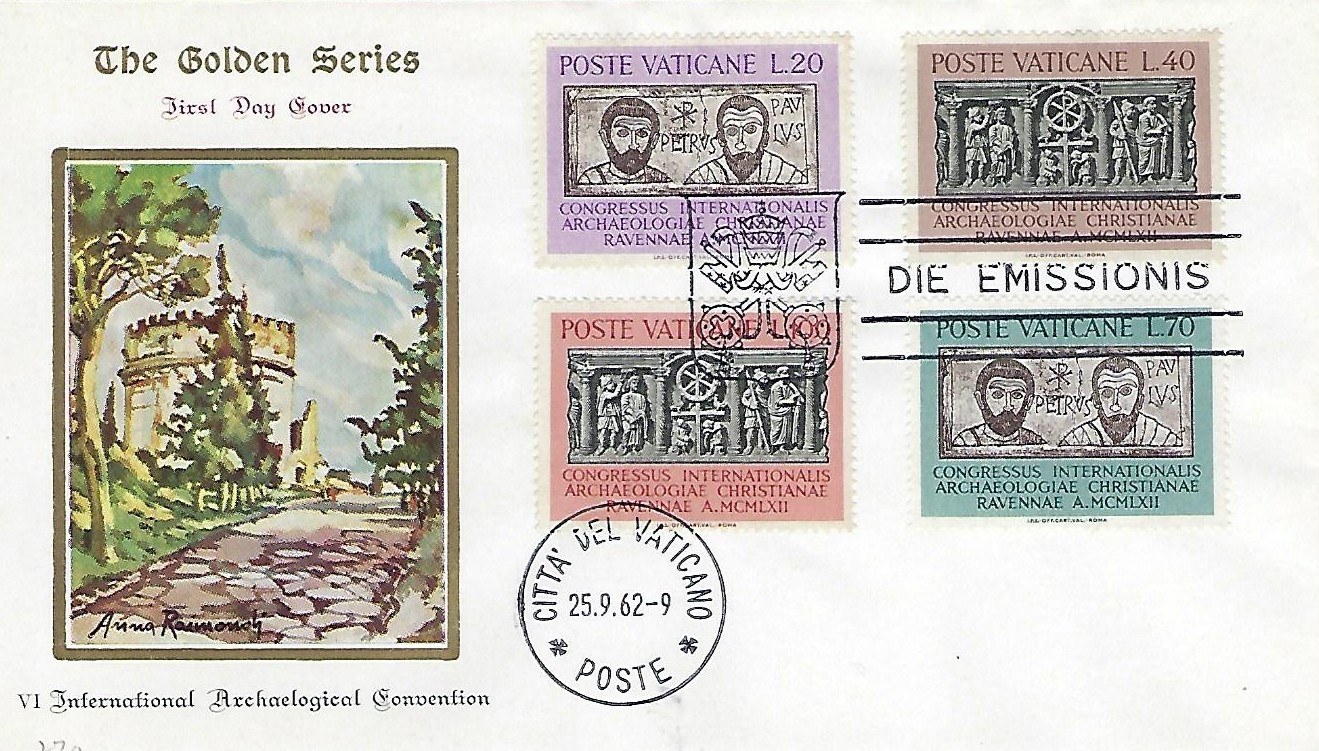













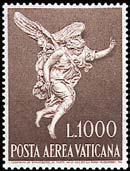
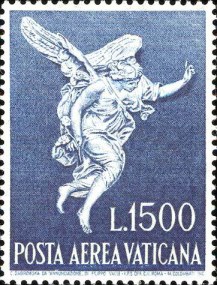





Vatican Stamps for the United Nations
Freedom from Hunger Campaign
VATICAN STAMPS FOR UNITED NATIONS FREEDOM FROM HUNGER CAMPAIGN. In its cooperation with the UN Food and Agricultural Organization (FAO) for their Freedom From Hunger Campaign, Vatican issued four stamps (400-03) and chose for the designs two events from the life of Jesus Christ,- the miracle of the Multiplication of the Loaves and Fishes and the Miraculous Draught of Fishes. In these the example of Christ was put before us,- the feeding of the multitude who were hungry, and the great catch of fishes for the men who supplied that part of the diet of Capharnaum and its vicinity. By the example of Jesus our motives are raised from the merely natural motive to the supernatural level of Christian charity.
The design of the Multiplication of the Loaves and Fishes is from a painting by Murillo, which is to be found at Charity Hospital, Seville, Spain. There are two accounts of separate instances of this kind in the New Testament. The first is the feeding of 5000 men plus the women and children with five loaves and two fishes, and this evidently is the one depicted by Murillo, because of the presence of the small boy in the picture referred to in the account by John. This event is recorded in Matthew 14/1-13; Mark 6/34-44; and Luke 9/10-17, as well as the text we quote from John 6/1-13.
John 6/1-13. After this Jesus went away to the other side of the sea of Galilee, which is that of Tiberias. And there followed him a great crowd, because they were witnessing the great signs he worked on those who were sick. Jesus therefore went up the mountain, and was sitting there with his disciples. Now the Passover, the feast of the Jews, was near. When therefore Jesus had lifted up his eyes and seen that a very great crowd had come to him, he said to Philip:"Whence shall we buy bread that they may eat?" But he said this to try him, for he himself knew what he would do. Philip answered:"Two hundred denarii worth of bread is not enough for them that each one may receive a little." One of his disciples, Andrew, the brother of Simon Peter, said to him: "There is a young boy here who has five barley loaves and two fishes; but what are these among so many?" Jesus then said:"Make the people recline." Now there was much, grass in the place. The men therefore reclined in number about five thousand. Jesus then took the loaves, and when he had given thanks, distributed them to those reclining; and likewise the fishes as much as they wished. But when they were filled, he said to his disciples:"Gather the fragments that are left over, lest they be wasted." They therefore gathered than up; and they filled twelve baskets with the fragments of the five barley loaves left over by those who had eaten.
The second recounting of another multiplication of loaves and fishes is told in Matthew 15/32-38 and Mark 8/1-10, wherein 4000 are fed from seven loaves and a few little fishes.
The second subject chosen for this issue, the Miraculous Draught of Fishes is found in Luke 5/1-11.
Luke 5/1-11. Now it came to pass, while the crowds were pressing upon him to hear the word of God, that he was standing by Lake Genesareth. And he saw two boats moored by the lake, but the fishermen had gotten out of than and were washing their nets. And getting into one of the boats, the one that was Simon's, he asked him to put out a little from the land. And sitting down he began to teach the crowds from the boat. But when he had ceased speaking, he said to Simon:"Put out into the deep and lower your nets for a catch." And Simon answered and said to him: "Master, the whole night through we have toiled and have taken nothing, but at thy word I will lower the net." And when they had done so, they enclosed a great number of fishes, but their nets were breaking. And they beckoned to their comrades in the other boat to come and help them. And they came and filled both boats, so that they began to sink. But when Simon Peter saw this, he fell down at Jesus' knees, saying:"Depart from me for I am a sinful man, 0 Lord." For he and all who were with him were amazed at the catch of fish they had made; and so were James and John, the sons of Zebadee, who were partners with Simon. Abd Jesus said to Simon: "Do not be afraid; henceforth thou shalt catch men." and when they had brought their boats to land, they left all and followed him.
The design of this stamp is taken from one of the tapestries of Raphael which hangs in the Hall of Tapestries in the Vatican Palace. In this connection, we refer you to an article -"The Tapestries of Raphael" by Fr. Phinney, in Vatican Notes for May-June 1964, Volume XII, #6, pages 11-12. The United Nations requested that a spike of grain either be the main design or be incorporated into the design, and in the top margin of the stamp we see three spikes of grain. In the side margins of the stamp is FAMEL/CIS ADIUVANDIS or To Aid the Hungry.
We refer you to the article below by Ted Morello which appeared in the Cardinal Spellman Philatelic Museum Newsletter of March, 1963, and we thank Sister Fidelma, the Curator of the Museum at Weston, Mass., for her permission to reprint here this most informative article. (See VATICAN PARTICIPATES IN FREEDOM FROM HUNGER CAMPAIGN)
Technical Details:
Scott Catalogue - 356 - 359
Date Issued - 21 March 1963
Face Value - 15 l, 40 l, 100 l, 200 l
Perforations - 14
Printer - The Italian State Printing Works
(Author - Unknown, From Vatican Notes Volume XIV, Number 4, January - February 1966, Page 1 & 2)



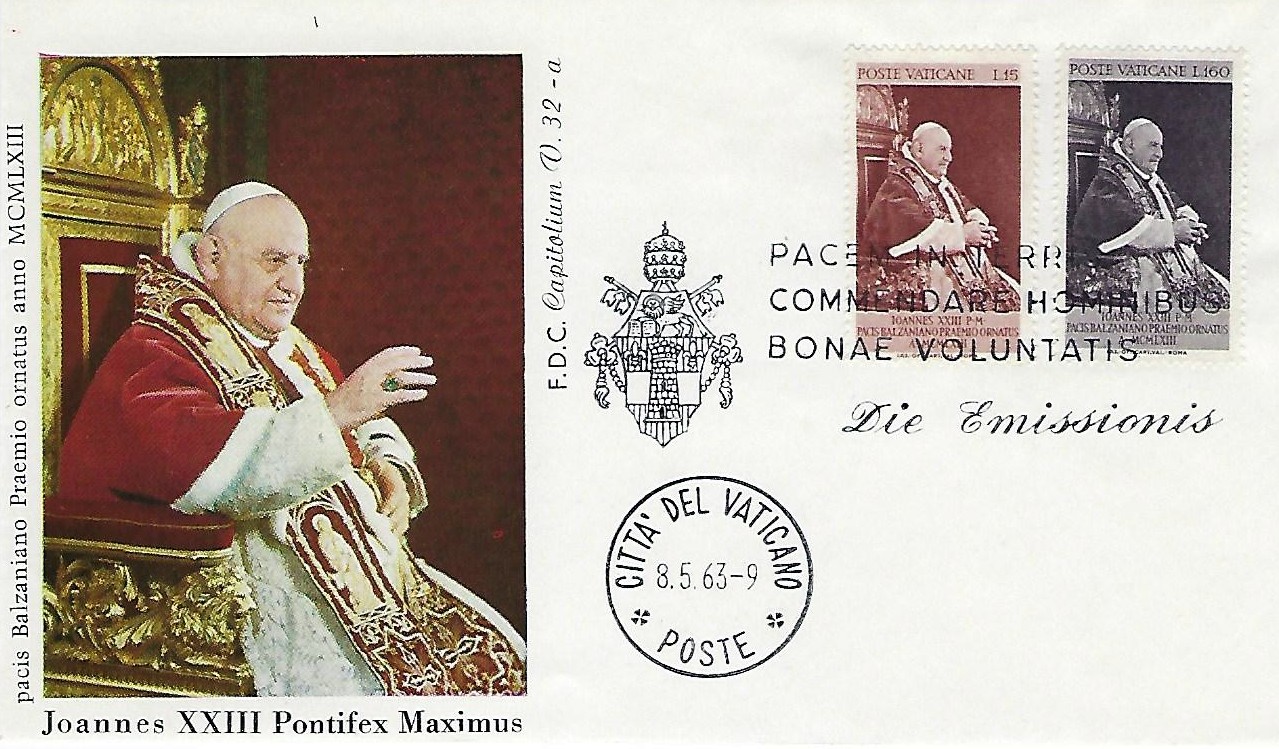














Saints Cyril and Methodius
Sts. Cyril and Methodius (sometimes called Constantine and Methodius) were brothers born to a senatorial family in Thessalonica in 827 and 826 respectively. They both decided to become priests and after ordination lived in a monastery on the Bospherus. The Khazars asked Constantinople to send them missionaries. The two brothers were chosen, learned the slavic language and converted many Khazars. Shortly afterward there was a request from Moravia for missionaries. There had been German missionaries in Moravia who had had little success. The Moravians wished someone who spoke the slavic tongue. Cyril and Methodius were chosen for this mission also. In preparation, Cyril invented an alphabet (Cyrilic) and he and Methodius translated the Gospels and liturgical books into the slavonic language. They entered Moravia in 863 and preached there for four and a half years with great success. The Germans regarded them with suspicion because they came from Constantinople where schism was raging and because they conducted the liturgy and church devotions and sevices in the slavic language. They complained to Rome about them and Nicholas I summoned them to appear before him and give an account of themselves. Nicholas died as they were travelling to Rome and they appeared before Pope Adrian II, who confirmed their othordoxy as well as their mission to Moravia and the use of the slavonic language. He consecrated them bishops. But before they could return to Moravia, Cyril died at Rome, Feb.4,896.
At the request of Rastislav and Svatopluk, Moravian princes, and of Kocel, slavic prince of Pannonia, Adrian TT formed the archdiocese of Moravia and Pannonia, independent of Germany, naming Methodius as archbishop. In 870 Methodius was summoned to Ratisbon for a synod, by King Louis and the German bishops. This combine deposed him and imprisoned him. After three years he was liberated at the command of Pope John VIII, and reinstated in his archbishopric. Methodius now attempted the spread of the faith among the Bohemians and Poles in Northern Moravia. At the instigation of a German priest, Wiching, he was summoned to Rome, where Pope John, after examination confirmed his othordoxy and sanctioned the Slavonic Liturgy, the only exception being that the Gospel of the Mass must first be read in Latin and then in Slavonic. Wiching had been appointed his suffragan bishop and gave him constant trouble, but John VIII constantly supported him.
Methodius, with the help of several priests, translated the remainder of Holy Scripture into Slavonic, with the exception of the Books of Machabees, together with the Nomo-canon, the Greek ecclesiastical-civil law. Worn out by his struggles, he died April 6, 885, naming as his successor his disciple, Gorazd. The Feast of Sts. Cyril and Methodius was formerly celebrated in Bohemia and Moravia on March 9, but Pope Pius IX changed the feast day of the Apostle of the Slavic Peoples to July 5, and Pope Leo XIII in 1880 extended their Feast to the Universal Church.
Technical Details:
Scott Catalogue - 369 - 371
Date Issued - 22 November 1963
Face Value - 30 l, 70 l, 150 l
Perforations - 14
Printer - The Italian State Printing Works
(Author - Unknown, From Vatican Notes Volume XII, Number 6, May - June 1964, Page 7)







Changing FDC Postmark Styles At Christmas
On November 22, 1963, the Vatican issued two new sets of three stamps each. One is the 1963 Christmas set, with the Nativity scene portrayed in an African negro concept. The other commemorates the 11th century of the beginning of the apostolate of St. Cyril and St. Methodius to the Slavic peoples. The Christmas set has the same design in 10 L., 40 L., and 100 L. values; a reddish-brown vignette with borders of different colors. In the other set, St. Cyril appears on the 30 L, and St Methodius on the 150 L, while the 70 L. shows a map of the field of their labors.
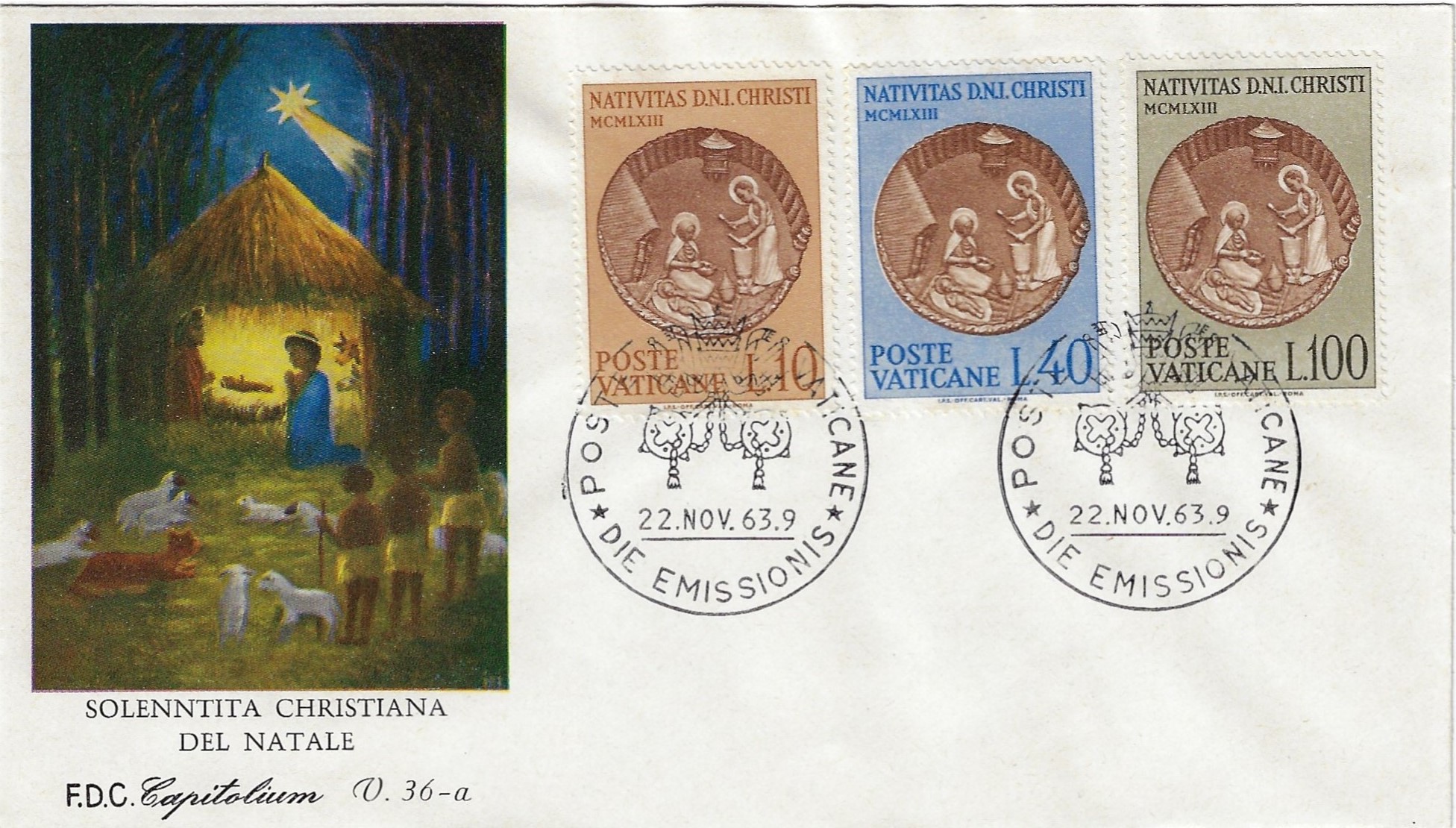








The Pilgrimage Paul VI To The Holy Land
Early on Saturday morning, January 4, 1964, Pope Paul VI boarded a jet plane, painted the Vatican colors of yellow and white, for his journey to the Holy Land as a pilgrim. The special flight cover and First Day Covers all bear the time of 9:00 A.M., but this could be the opening time of the Post Office and the Special Flight could have taken off before this, with the Special Flight Covers marked with the Post Office's opening time. As the plane left Rome and passed near or over inter-vening capitals of countries, from the plane Pope Paul sent messages of greeting to King Paul at Athens, Greece, as well as to Archbishop Makarios at Nicosia, Cyprus, to General Fouad Chehab, President of the Republic of Lebanon at Beyrouth and to President Mohammed Amine Hafez of the Arab Republic of Syria at Damascus.
At the Amman Airport the sky was overcast and the weather was raw and cold, causing the airport to be closed for a short time that Saturday morning because of low visibility. King Hussein of Jordan was at the Amman Airport with dozens of government and church officials, and a crowd of 50,000 Jordanians, awaiting the arrival of Pope Paul VI. Climbing to the control tower, King Hussein talked with the pilot of the papal plane discussing the flight pattern for the landing. A Jordanian Army jet met the papal flight at the Jordan frontier. The clouds began to lift and the weather improved sufficiently for a safe landing. The gangway was rolled to the exit hatch, from which emerged His Holiness, Pope Paul VI, to be greeted by the cheers of "Vive le Pape" and "Baba I Baba I". At the foot of the gangway the Pope and King exchanged greetings and handshakes, then proceeding to a platform facing the Terminal Building. The Jordanian Army Band played national anthems. From the platform they proceeded along a red carpet to a reception room in the Terminal Building, where private conversations were held, after greetings had been exchanged between the visitor and the welcoming dignitaries.
Then the motorcade proceeded slowly through the throng of Moslems and Christians who crowded about to touch the robes of His Holiness. The gaily decorated streets of Amman were lined with 200,000 cheering Jordanians, through which the motorcade passed on its way to Jerusalem. It stopped at the Emir Abdullah Bridge over the Jordan River, where Pope Paul was greeted by the Governor of Jerusalem, the Mayor of Jerusalem and the Mayor of Jericho. King Hussein had followed the motorcade in a helicopter and was circling overhead. Pope Paul went down the steps to the Jordan River, and with water from the river blessed the crown of more than 200,000 assembled to welcome him. The next stop was at Bethany, the home of Mary, Martha and Lazarus, where the Pope visited the Franciscan monastery and prayed at the church built over the site of the grave of Lazarus, whom Christ raised from the dead on that spot.
At the Damascus gate leading into Jerusalem a tremendous crowd had assembled in a square to welcome the Pope, overflowing. the protective barriers. The Pope had intended to deliver an address here, but because of the lateness of the hour, postponed the speech until two days later on the occasion of the visit of the Governor and Mayor of Jerusalem.
His Holiness went to the Via Dolorosa, walking to the seventh station and entered the chapel there to pray. He proceeded along the way and into the Holy Sepulchre Church, stopping at the site of the Crucifixion within the Basilica, and there celebrated a special Mass prepared for that occasion. At the end of Mass Pope Paul descended the stairs, past the stone of Unction into the Holy Sepulchre itself, and prayed in solitude.
Over the Holy Sepulchre or the Tomb of Christ in Jerusalem, Emperor Constantine had erected an edifice completed in 336. The Holy Sepulchre had been excavated so that it stood separate from the rock that had surrounded it, and a dome 65 feet in diameter (in the first church) stood over it. From this dome the church had extended east 250 feet embracing Calvary on its south aisle, while an atrium and entrance brought its total length to 475 feet. This was destroyed by fire in 614 during the Persian invasion under Chosroes. The second basilica was finished through the efforts of Abbot Modestus and the Patriarch of Alexandria, only to be destroyed by the Mohammetans in 1010. Smaller churches were erected over the Holy Sepulchre and Calvary by 1048. The Crusaders incorporated these churches into their basilica which was completed in 1168, similar in plan to that of Constantine. Fire partially destroyed this church in 1803. A new church, designed by the Greek architect, Commenes, was built at the expense of the Greeks and Armenians and dedicated in 1810. France, Russia and Turkey financed the dome, which was finished in 1868, under which is the Tomb of Christ, enclosed in a monument built in 1810, of Palestinian breccia, a red and yellow stone resembling marble.
At the residence of the Apostolic Delegate on the Mount of Olives Pope Paul received many church dignitaries, later visiting His Beatitude Benedictos, Orthodox Patriarch of Jerusalem. The same night he descended the Mount of Olives through the Garden of the Church of All Nations, which stands over the Rock of Agony, and spent a Holy Hour devoted to prayer. Shortly before midnight he left the church and retired for the night at the Apostolic Delegation.
Early on January 5, after Sunday Mass, the Pope rode north from Jerusalem to Jenin, being greeted on the way by officials and a crowd at Ramallah and Nablus as well as at Jenin. Here he crossed over into Israel to visit sites connected with the Life of Jesus Christ, among which were the shrines of Nazareth, especially the Church of the Annunciation and the Virgin's Well (depicted on the stamp).
The Virgin's Well or St. Mary's Well stands at the southwest limits of Nazareth, and was probably one of the reasons that settlers founded Nazareth. A picture in the Catholic Encyclopedia (Vol. X, p.725) shows a view of the well and its enclosure, but the wall in front of the shelter at that time had not been built up to the height shown on the stamp. Four tiers of stone can be seen in this wall, one of which is apparently the footing, while the picture on the stamp shows five tiers to the right of the step. The Catholic Encyclopedia picture is before 1911 and the other more recent. Because of the name of the well, one must presume that the Blessed Virgin Mary came here to draw water for the Holy Family in the years of their residence at Nazareth.
The evening of January 5 Pope Paul met His Beatitude Athenagoras, the Greek Orthodox Ecumenical Patriarch, on his return to Jerusalem, and they exchanged greetings.
On the morning of January 6 (Epiphany), Pope Paul went to Bethlehem to visit the Manger of the Infant Jesus in the grotto under the Church of the Nativity at Bethlehem. Since Epiphany is the feast celebrating the revelation of Jesus to the gentiles (a Holy Day of Obligation in many countries but not the USA) Paul VI offered the Mass of Epiphany, after which he crossed over to the Church of St. Catherine and delivered a message to the world, proclaiming the True Church of Christ, and expressing charity towards all who are not members of the True Church.
The Church of St. Mary of the Nativity stands over the traditional site of the birth of Christ, surrounded on the northwest and Southwest by convents of the Latin, Creek and Armenian churches. The Basilica is substantially the work of Constantine from about 330 A.D., with additions and modifications by Justinian (527-565). Underneath it is the grotto of the Nativity. The Church runs east-west & the Chapel of the Nativity is situated under the choir and runs in the same direction. At the east end of the Chapel is a silver star with the inscription:- "HIC DE VIRGIN! MARIA JESUS CHRISTUS NATUS EST" (Here Jesus Christ was born of the Virgin Mary). Nearby is the Chapel of the Crib or Manger.
Returning to Jerusalem, Pope Paul met again with Patriarch Athenagoras and they issued a joint statement of mutual charity and hope of further understanding. Later a statement was issued to His Beatitude Yeguishe Derderian. Armenian Orthodox Patriarch of Jerusalem, expressing charity and hope of further communications tending toward understanding. To the governor and mayor of Jerusalem he gave the message of thanks and blessing which he had intended to deliver on the evening of January 4. To the Catholic Heirarchy and clergy of the Holy Land he urged selfless charity toward all.
His return to Amman was greeted by cheering throngs. At the Airport King Hussein was on hand to bid him farewell. After the Band played national anthems, King Hussein promised to work for peace, to continue to guard the sacred places of Christianity, and hoped that the Pope had reaped the spiritual benefits of his pilgrimage. Pope Paul thanked Hussein for his hospitality, prayed for charity and called down the blessing of God on the King and people of Jordan. Gifts were exchanged, the crowd cheered, and jets roared overhead. Pope Paul ascended the gangway and again blessed the crowd. King Hussein rode along the runway beside the plane until the papal Jet took off. From the plane Pope Paul again sent thanks to the control tower to the Jordanian King and people. Three hours later the jet landed in Rome and Pope Paul returned to the Vatican.
(Cf. His Holiness Pope Paul VI, Historic Pilgrimage to Jordan, the Holy Land- Ministry of Information Amman, the Hashemite Kingdom of Jordan, National Press, Amman. CF. Catholic Encyclopedia- Holy Sepulchre, Bethlehem, Nazareth)
For the Pilgrimage of Pope Paul VI to the Holy Land, four stamps were issued on Jan.4, 1964, the day of His Holiness' departure from Rome (15 L. Pope Paul at prayer; 25 L. Church of Nativity, Bethlehem; 70 L. Basilica of the Holy Sepulchre; 160 L. Virgin's Well at Nazareth). FD Covers were canceled with a slogan cancel:- POPE PAUL V// FOR THE SAKE OF UNITY AMONG CHRISTIANS/AND FOR WORLD PEACE/GOES AS AN APOSTOLIC PILGRIM TO THE HOLY LAND. To the right of the slogan is a single circle cancel with the papal coat of arms extending from the top into the circle; within:- POSTE VATICANEf DIE EM/SSIONIE* 4 Genn 64 - 9.
Special Flight Covers carried on the plane were backstamped AMMAN.AIRPORT 4 Jan 64 and JERUSALEM 4 Jan-64.
Jordan issued four stamps commemorating this visit (FDC 4 Jan 64) canceled at Jerusalem. On each stamp Pope Paul in tiara is at left and King Hussein at right, with each value having a different scene between the two portraits:- 15 f Al-Aska Mosque, Jerusalem (formerly the Church of Our Lady of Jerusalem, work of Justinian); 35 f The Dome of the Rock, a mosque which stands on the site of the Temple of Jerusalem, built by Solomon, and rebuild successively by Zorobabel and Herod, leveled by the Roman about 70 A.D under Titus; 50 f The Church of the Holy Sepulchre, Jerusalem; SO f Church of Nativity, Bethlehem.
Israel used two commemorative cancels, circle formed by words. On the bottom half is PEREGRINATIO PAPAS PAULI VI (Pilgrimage of Pope Paul VI) and on the top half Hebrew characters presumably corresponding to the Latin. Across the center are two lines of Hebrew script, followed by JERUSALEM 5.1.1964 on one cancel and on the other NAZARETH 5.1.1964. A fifth line appears to be arabic.
Covers of the return flight of Pope Paul were canceled at Amman Airport:- 6-Jan-64. They carry meter cancellation on the back 6-1-1964 with the slogan cancel joined to the regular meter cancel double dating circle.
Technical Details:
Scott Catalogue - 375 - 378
Date Issued - 04 January 1964
Face Value - 15 l, 25 l, 70 l, 160 l
Perforations - 14
Printer - The Italian State Printing Works
(Author - Unknown, From Vatican Notes Volume XVI, Number 1, July - August 1967, Pages 3 - 5)

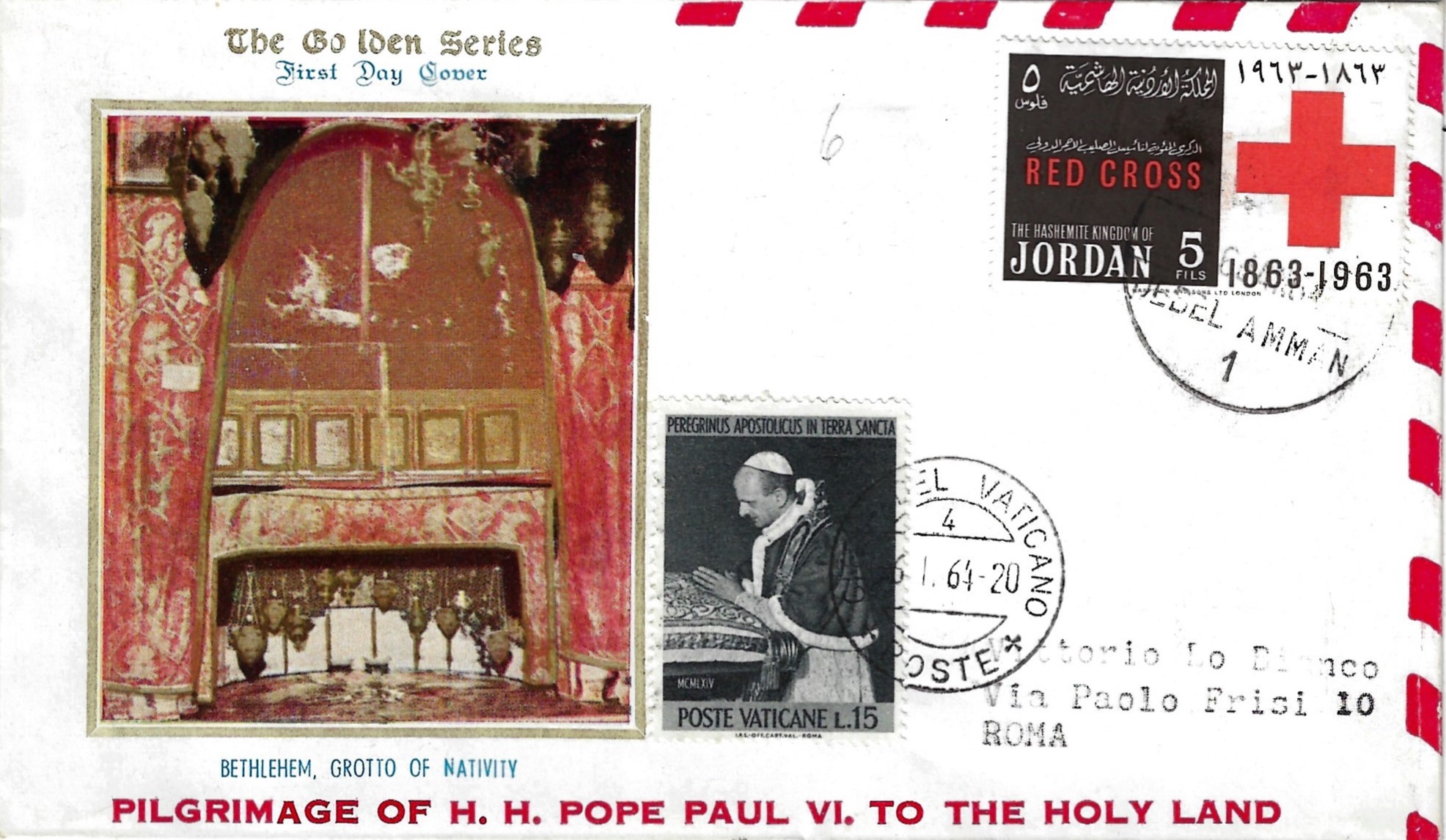




For Saving The Nubian Monuments
On March 10, 1964, Vatican issued 4 values (10,20,70,200 L) for the saving of the Nubian Monuments which will be covered up by the waters backing up from the Aswan Dam. One design (10 and 70 L) shows a niche in the Pharaoh's temple at Ouadi es Seboua containing a painting St. Peter, which also shows Rhamses II and the boat sacred to the sun. The other design (20 and 200 L) shows the Roman-Egyptian portico of 14 pillars built by Emperor Trajan with the waters of the Nile already up to its base. The format is horizontal, 31 x 25mm, printed by photogravure on paper watermarked crossed keys. The copies shown have perfs 14 x 14 on the 10 and 70 Lire, and 13 1/2 x 13 1/4 on the 20 and 200 Lire.

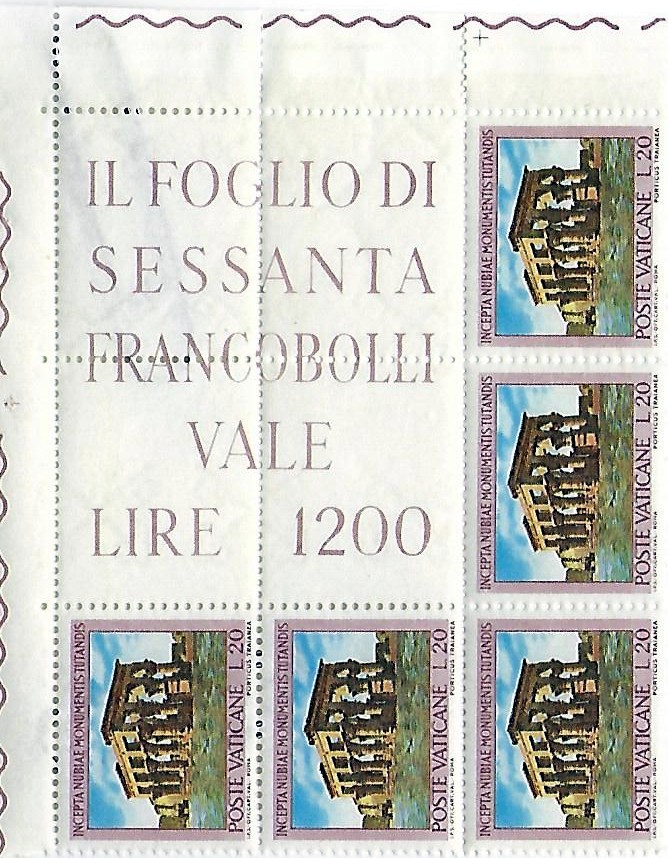







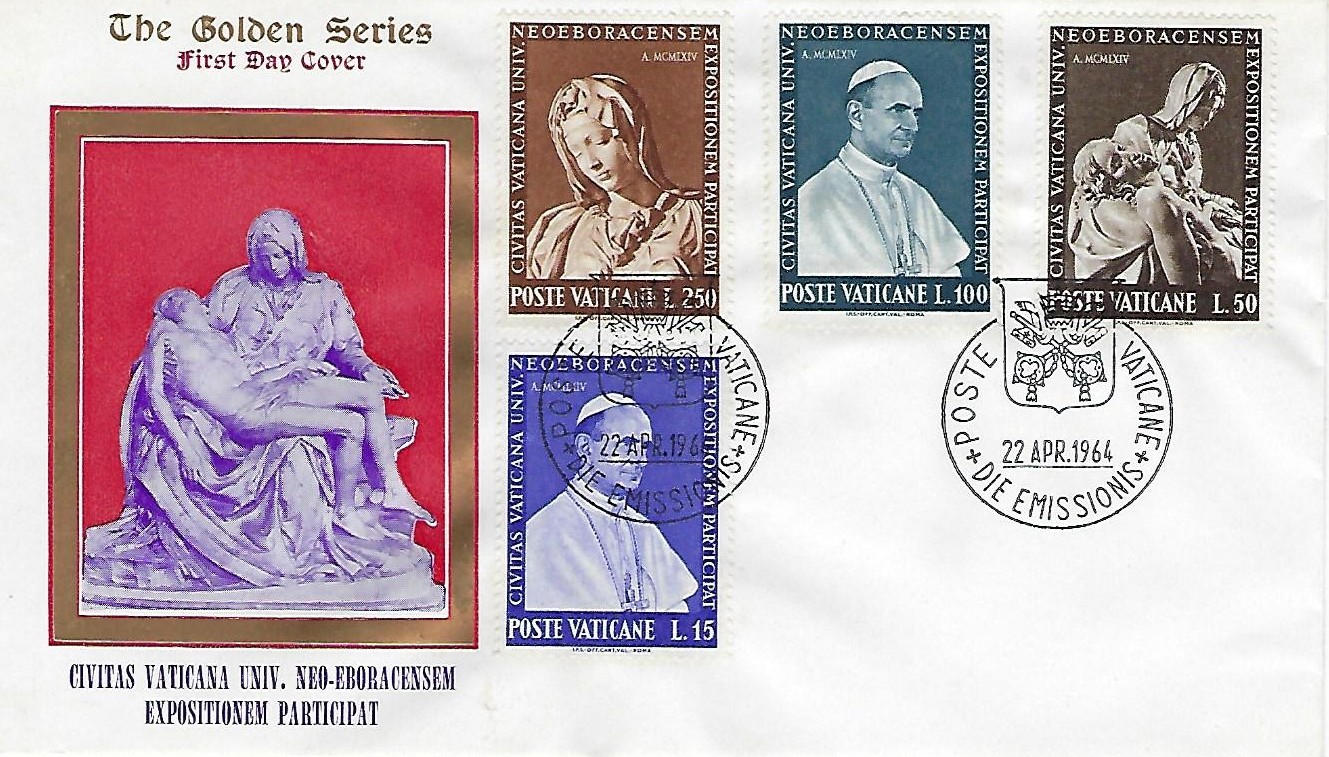
The Fourth Centenary Of The Death Of Michaelangelo

MTCHAELANGELO BUONARROTI, born March 6, 1475, at Caprese on the upper Arno River; died at Rome, Feb.I8, 1564. Sculptor, Architect, Painter. Famous for statues in the Medici Chapel, Florence; Bacchus; the Pieta of the Vatican; David, Moses (among many others); for his work in the rebuilding of St. Peters Basilica; for his paintings in the Sistine Chapel, the ceiling and the Last Judgement.

THE PROPHET ISAIAS (ceiling-Sistine Chapel), called by Sacred Scripture the GREAT Prophet, because of his foretelling of the coming of Christ, the mysteries of the Redemption, the calling of the gentiles and the establishment of the Church. In Hebrew his name signifies "Salvation of the Lord". By Hebrew tradition he was of royal blood of Juda and was sawed in two, a martyr, by King Manasses, because he reproved the king's evil ways.

THE DELPHIC SIBYL (ceiling-Sistine Chapel). Sibylline Oracles is the name given to a collection of supposed prophecies widely circulated in antiquity, coming from 'divinely inspired' seeresses. Originally it was "THE Sibyl", in later times named ten sibyls: Persian, Libyan, Cimmerian, DELPHIC, Erythrean, Samarian, Cumean, Phrygian, of the Tiber and of the Hellespont. Because of their influence among pagans, Jews and later Christians wrote "Sibylline Oracles" to promote their doctrines. With the disappearance of paganism, these fell into disuse. The Sibyls in the Sistine Chapel "referred to Christ in her prophecies".

THE PROPHET JEREMIAH (ceiling- Sistine Chapel) was a native of Anathoth, a priestly city of the gibe of Benjamin, was a priest and was sanctified in his mother's womb to be a prophet. His name signifies "Great Before the Lord". He was a figure of Christ insomuch as he was persecuted for discharging his duty; his charity for his persecutors; and his violent death at their hands. According to Hebrew tradition he was stoned to death by the remnant of the Jews who had gone to Egypt.

THE PROPHET JOEL (ceiling- Sistine Chapel) whose name signifies "The Lord God" or "The Coming Down of God", prophesied in the Kingdom of Aida at the same time that Osee prophesied in the Kingdom of Israel. He foretold punishments coming on his people because of their sins, but comforts them with the prophecy of the coming of the Teacher of Justice, Christ, and the coming of the Holy Spirit.




100th Anniversary Of The Founding Of The Red Cross
Jean Henry Dunant, a Swiss businessman, wrote the book "Un Souvenir del Solferino" ("A Memory of Solferino") in 1862, describing the sufferings of the wounded on the battlefield of Solferino, when the French and Sardinian armies fought the Austrians, in which more than 30,000 were killed or wounded. He urged the formation of voluntary aid societies for the relief of the wounded, and urged that this help be international and neutral.
The Societe Genevoise d'Utilite Publique of Switzerland took up the suggestion and an international conference was called with delegates from sixteen countries, which met in Geneva in 1864 "For the Amelioration of the Condition of the Wounded and Sick of Armies in the Field". A convention was signed by twelve of the sixteen countries attending, providing for the neutrality of the aid personnel of the armed forces, and the neutrality of the civilians who voluntarily assisted them, with an international emblem to mark personnel and supplies. To obtain the symbol the Swiss flag was reversed in color (a white cross on a red field) to become a Red Cross on a white field, in honor of Dunant.
Signatories of the Geneva Convention with its subsequent revisions and trestles include most civilized countries. There are National Red Cross Societies in more than 68 countries. The International Committee of the Red Cross, founded in 1863, is composed of 25 Swiss citizens who serve as neutral intermediaries in time of war. The League of Red Cross Societies was founded in 1919, and is composed of the various National Red Cross Societies. The International Red Cross Conference, begun in 1867, is the highest deliberative body and is composed of a representative of each National Red Cross, of the League of Red Cross Societies, and of all nations signatory to the Geneva Convention. It meets every four years.
Clara Barton (US 967) started the American Red Cross in 1881, and it received its first Federal Charter in 1900. Its charter was revised in 1947. Its headquarters are in Washington, D.C.
The design on the Vatican stamps recalls the story of the Good Samaritan (Luke X:30-37) which explains in the parable how we should love God and love our neighbor as ourselves for the love of God.
Technical Details:
Scott Catalogue - 392-394
Date Issued - 22 September 1964
Face Value - 10 l, 30 l, 300 l
Perforations - 14x13.5
Printer - The Italian State Printing Works
(Author - Unknown, From Vatican Notes Volume XVI, No.3, November-December 1967 , Page 2)
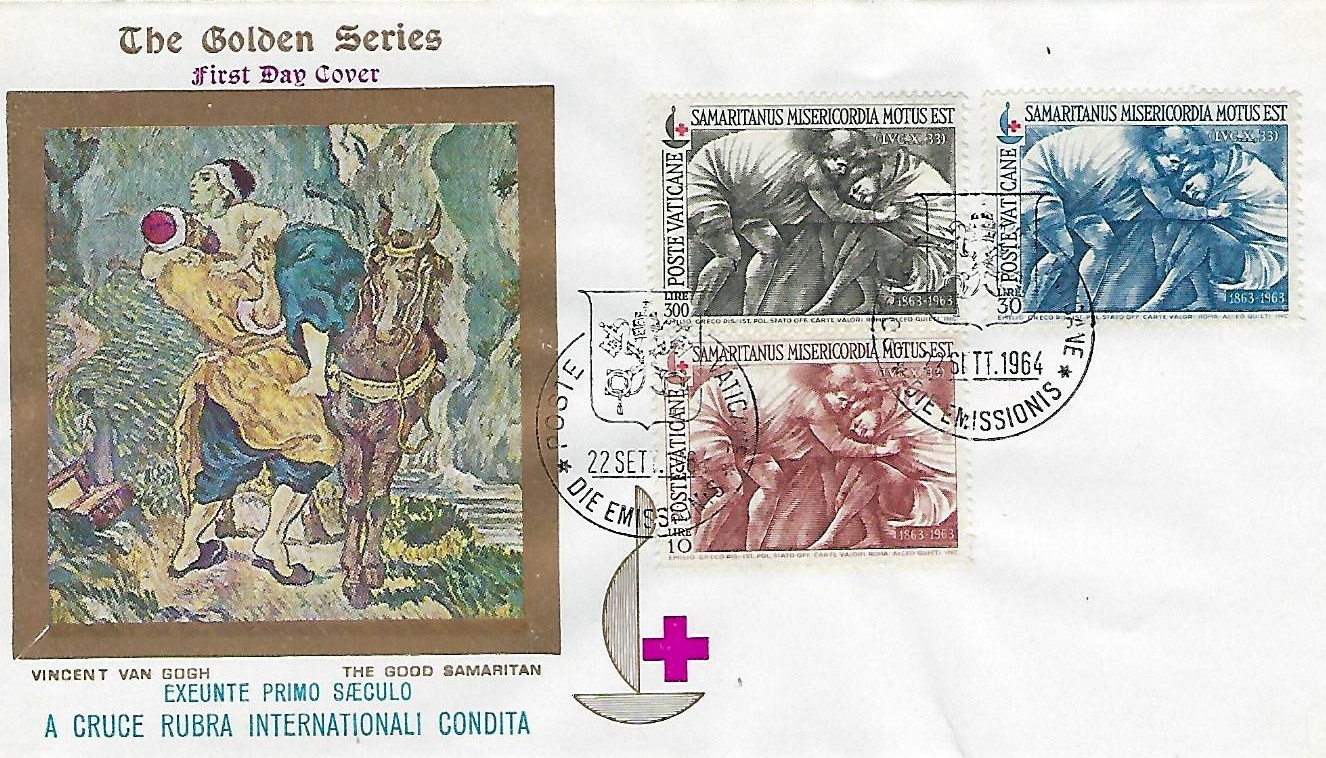
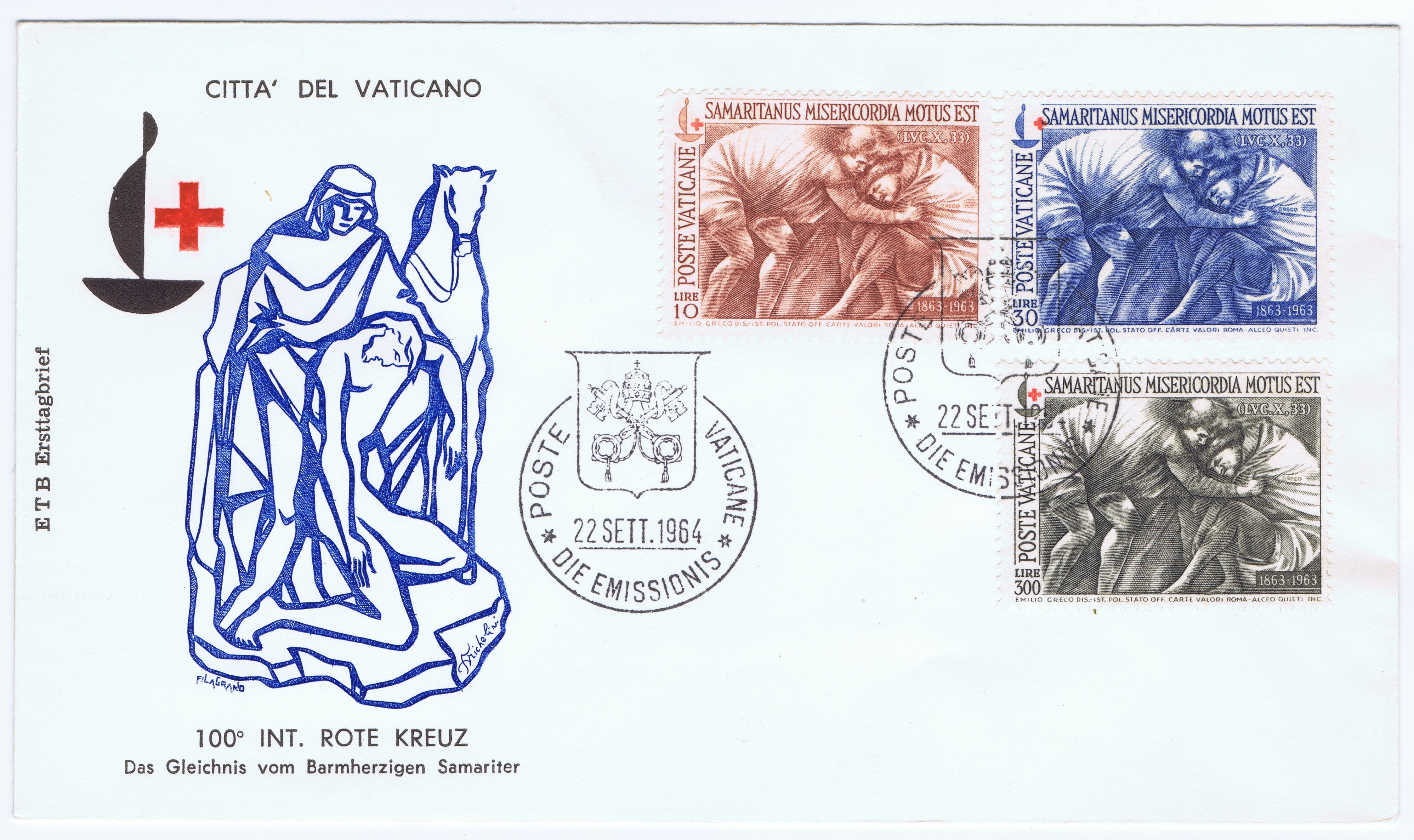


Five Hundredth Anniversary Of The Death Of
Cardinal Nicholas Of Cusa, 1464-1964.
Cardinal Nicholas of Cusa. born at Cues, Germany, 1400-1401 to Johann Cryfts (Krebs) a wealthy boatman on the Moselle River. Schooled early at Deventer, he entered the University of Heidelberg in 1416, and in 1417 studied at Padua, becoming a Doctor of Canon Law in 1423, later (1425) finishing his theology at the University of Cologne.
He began his public career at the Council of Basle in 1431, where his main efforts were to reform the calendar and to accomplish the religious and political unity of Christendom. As the emissary of Eugenius IV in 1437 he persuaded the Byzantine emperor, the patriarch of Constantinope and 28 archbishops to attend the Council of Florence. Made papal legate in 1438, he represented Eugenius IV at the Diets of Meinz 1441, Frankfurt, 1442, Nuremburg, 1444, and Frankfurt, 1446. Nominated a cardinal by Eugenius IV, he refused, only to be ordered to accept the office by Pope Nicholas V in 1449, with his titular church St. Peter In Chains.
He was appointed bishop of Brixen to reform the diocese, but opposition from Duke Sigismund kept him from occupying it immediately. As Papal Legate to Northern Germany and the Netherlands he held synods, reformed parishes and monasteries, preached a crusade against the Turks with great success, but in his own diocese was unable to accomplish any reform because of the opposition of Sigismund. He was imprisoned by the Duke but fled to Pope Pius II. The Duke defied the excommunication imposed on him until Emperor Frederick III brought about his submission in 1464. Nicholas accompanied Pius II to view the Venetian fleet for the Crusade at Ancona. Sent by the pope to Leghorn to hasten the Genoese fleet, the Cardinal died at Todi, Umbria, August 11, 1464. A great administrator, he was also an accomplished scholar, with writings in canon law, philosophy, theology and science.
Technical Details:
Scott Catalogue - 395 - 396
Date Issued - 16 November 1964
Face Value - 40 l, 200 l
Perforations - 14x13.5
Printer - The Italian State Printing Works
(Author - Unknown, From Vatican Notes Volume XIII, Number 4, January - February 1965, Page 1)









Commemorating the Visit of Pope Paul VI
to the 38th Eucharistic Congress
at Bombay, India, December 2 to 5, 1965
An Air India jet landed Pope Paul VI at the Bombay airport in late afternoon on Dec.2, 1965, amid a million cheering Indians, mostly Hindus, and drove through streets lined by thousands of other Indians who welcomed him to India for the 38th International Eucharistic Congress at Bombay. Paul VI greeted them with the Namaste, folded hands before the face and a bow of the head. The anti-catholic feelings of a small minority had no chance to be displayed. It was the first visit in modern times of a reigning pontiff to any country except the Holy Land. At the Congress he consecrated six bishops one from each of the continents, who then walked around the great altar at the Oval (L.25) giving their blessings to the 250,000 people present. The Indians were impressed with Paul's simplicity, whether at the religious ceremonies of the Congress, or protocol required by his visit as a head of state, or among the children and suffering at the orphanages and hospitals, which occupied his day from early morning to midnight.
Seeing the poverty of India he said "Would that nations would cease the armaments race and devote their resources and energies instead to the fraternal assistance of developing countries. Would that every nation, thinking thought of peace and not of affliction and war, would contribute even a part of its expenditure for arms to a great world fund for the relief of the many problems of nutrition, clothing, shelter and medical care which effect so many people. From this peaceful altar of the Eucharistic Congress may this anguished cry go forth to all the governments of the world and may God inspire them to undertake this peaceful battle against the sufferings of their less fortunate brethren". The Pontiff bestowed the Order of the Golden Spur, one of the 5 pontifical orders of knighthood, on President Radhakrishnan of India. The Hindus, most of humble origin, saw Pope Paul VI as "a great holy man", of whom even a glimpse provided its special blessing. Pope Paul: "I hope to meet many of the faithful and other men. I hope it will contribute to peace and be a witness to goodwill". Alitalia flew the pontiff back to Rome on Dec.5, 1965.
Stamps:







Canonization Of The 22 Martyrs Of The Uganda
The men were officials and the boys were pages at the court of King Mwanga, and were put to death because, led by the older martyrs, they refused to take part in the homosexual orgies of the king.
The stamps depict the following:





Dante Alighieri
Dante Alighieri was born at Florence, Italy, in 1265 (died at Ravenna, Sept. 14, 1321) of Alichiero de Bellencione Alirthieri and his wife Bella. Politically he was a Guelph, and fought against the Ghibilines. He became a member of the Guild of Physicians and Apothecaries, since as a guild member he could participate in public life. He began writing, completing his first book (New Life) in 1294, which was poetry about "Beatrice", the name of a young girl who had died in 1290.
In 1300 he was elected as one of the six Priori who ruled Florence in two-month terms, his encumbancy being from June 15 to August 15. MO factions had risen among the Guelphs, the Blacks and the Whites, Dante belonging to the Whites. Charles of Valois with his troops entered Florence in 1301 and placed the Blacks in power. Dante was falsely charged with hostility toward the Church, was convicted and assessed with a heavy fine and was perpetually excluded from public office, and in 1302 was condemned to be burned to death.
By this time Dante had fled the city of Florence and joined his wife and children in San Cadenza. Withdrawing from active politics, he started writing a group of poems, partly allegorical in nature, which actually formed a connectins link between his "New Life" and the "Divine Comedy". He was at Bologna in 1304, but was expelled in 1306 with the other "Whites", going first to Padua and then to Linigiana. During this period he wrote "fie Banquet", a popularization of Scholastic Philosophy, and then disappeared from recorded history for some years. After the election of Emperor Henry VII, and in anticipation of the Visit of the Emperor to Italy, in 1309 he wrote "De Monachia", presenting the picture of the Emperor as the healer of all the ills of Italy. Dante met Henry VII in 1311, and later wrote to him, taking him to task for delaying an attack on Florence. Florence reacted with a decree of perpetual exile from chat city, without amnesty. The writings of Dante shaped Italian poetry and left his mark on modern literature. His greatest work was the "Divine Comedy", which he composed in three books:- Hell, Purgatory and Paradise, completing the last at Ravenna about 1317. THE DIVINE COMEDY is an allegory of human life in the form of a vision of the world of Eternity, intended to convert a corrupt society from sin to grace, Dante recounts • vision granted him in the Jubilee Year of 1300, which was intended to lead him from a sinful life to the ways of God. In the vision he passes through Hell, Purgatory and Paradise, speaking to individual souls in each place, describing the punishments and rewards, and learning; what God has in store for him and the whole world. the journey through Well with the Roman poet Virgil begins Holy Thursday night and ends on Easter Sunday at 5:00 A.M. At dawn on Easter Virgil leads him into Purgatory and entrusts his trip through the earthly paradise and Paradise itself to Beatrice or. Easter Wednesday morning. Beatrice leads him through Paradise to the Throne of God. THE STAMP DESIGNS are by Casimira Dabrowska. The Lire 10 is taken from the Disputa del Sacramento by Raphael, the fresco on Theology in the Camera della Segnatura in the Vatican Palace (Cf. Vatican Notes, Vol. XII, 04, p.10) and the other three were Inspired by originals by Sandie Boticelli which he did to illustrate the Divine Comedy. Reference for the scene on the Lire 40 stamp is Canto I of Hell, verses 32 ff., which relates that Dante wandered from the right road into the Dark Wood of Sin. He tries to escape by climbing a beautiful mountain, but is turned back successively by a Leopard, a Lion and a Wolf, which are images of sin identified respectively with Lust, Pride and Avarice, or with the three types of sin which can damn unrepentant souls to one of the three main divisions of Hell
First rose, a Leopard, nimble and light and fleet,(Virgil leads Dante through the Upper Hell and the two parts of the Nether Hell, and then into Purgatory, leads him up the mountain of Purgatory as far as the Earthly Paradise).
Clothed in fine-furred pelt all dapple-dyed,
Came gambolling out and skipped before my feet,
Hindering me so, that from the forthright line
Time and again I turned to beat retreat
Yet not so much that I fell to quaking
At a fresh sigh - a Lion in the way.
I saw him coming, swift and savage, making
For me head high, with ravenous hunger raving
So that for dread the very air seemed shaking.
And next, a Wolf, gaunt with famished craving
Lodged ever in her horrible lean flank,
The ancient cause of men's enslaving;
She was the worst - at that dread sight a blank
Despair and whelming terror pinned me fast,
Until all hope to scale the mountain sank.
(At this point Virgil appears to guide him on his ways- verses 62 ff.)
Suddenly a form was there, which dumbly crossed
My path .......
Canst thou be Virgil? thou fount of splendor,
Whence poured so wide a stream of lordly speech?
And to I as sometimes at the approach of dayThe design on the L.200 of Dante and Beatrice recalls the paradise. Actually, Beatrice appears to Dante in the Purgatory (Canto XXX) and leads him to the earthly paradise, because Virgil cannot enter there. Paradise starts from the Earthly Paradise on top of the Mountain of Purgatory. Beatrice turns her eyes toward heaven, and Dante fixes his gaze on her face, and they rise to the First Heaven.
Mars in the west across the ocean floor
Glows through thick vapor with a dim, red ray,
Even so - God send I see the sight once more ! -
I saw a light come speeding o'er the sea.
So swift, flight knows no simile therefore.
For a brief space I turned inquiringly
Back to my guide; then looked again and lo
Bigger and brighter far it seemed to me.
Then from each side of it, there seemed to grow
A white I-Knew- not what; and there appeared
Another whiteness, bit by hit, below.
Now all this time my master spoke no word,
Till plain we saw, those first two whitenesses
Were wings .. and knowing then what helmsman steered,
"Down, down:" he cried, "fold hands and bow thy knee,
Behold the angel of the Lord: Henceforth
Thou shall see many of these great emissaries.
See how he scorns all instruments of earth,
Needing no oar, no sail but his own wings,
Twixt shores that span so vast an ocean's girth.
See how each soaring pinion heavenward springs,
beating the air with pens imperishable
That are not mewed like mortal coverings."
And hard on shore he steered his flight....
The heavenly pilot on the poop stood tiptoe
And with him full a hundred souls had place...
and so he brought the ship to.
He signed them with the blessed cross and they,
All with one motion, leapt upon the strand;
Then swiftly as he came, he went his way.
Beatrice gazed on heav'n and I on her;When Dante and Beatrice arrive in the First Heaven, the Heaven of the Noon, the scene depicted on the L.200 takes place. He sees a group of souls (at the left of the picture by Sandro Soticelli, but not shown on the stamp)(Paradise Canto III, vv.7 ff.)
..whence she ...
Turned to me as blithe as beauteous;
"Lift up to God"; she said, "thy grateful sense
Who with the first star now uniteth us"
Into itself the eternal union
Received us both, as water doth receive
A ray of light and still remains all one.
But what I saw so carried me awayHeaven, as depicted by Dante, consists of ten successive levels, the last of which is the Empyrean. Here St. Bernard prayed to the Blessed Virgin that Dante may behold God, which favor is granted. Dante looks on the Blessed Trinity and the Sacred Humanity of Christ, but his power to describe fails him, and all that he remembers is that his will is totally surrendered to the love of God.
To gaze on it, that ere I could confess,
I had forgotten what I meant to say.
Like as from polished and transparent glass,
Or as from water clear and luminous,
Whose shallows leave the bottom shadowless,
The image of a face comes back to us
So faint, a pearl on a white forehead stirs
The seeing sense no slowlier than this does,
Si I saw faces, many and diverse,
Eager to speak ...so I turned instead
Straight to my dear and guiding light; she smiled,
Her holy eyes aflame, and then she said"
True substances are these thou dose perceive,
Who broke their vows, and so are cloistered here...."



St. Benedict of Nursia, Patron of Europe
On July 2, 1965, the Vatican issued two stamps commemorating St. Benedict, founder of the Benedictines. Both stamps bear the inscription: "In the restored Cassino monastery, Paul VI declared St. Benedict the patron of Europe in the year 1964." The FD special cancel reads: "He, who was the teacher of the peoples of Europe of peace, unity and civil culture by the cross, book, and plow, was made` patron to the same peoples by Pope Paul VI". St. Benedict appears on the 40 Lire and the Abbey of Monte Cassino on the 300 Lire.
St. Benedict was born at Nursia (near Spoleto) c.480 and died in 543 at Monte Cassino. He was the son of a well-to-do family and had a sister, St. Scholastica, probably his twin. Schooled at Nursia and Rome, he fled from the evils of the world to Enfide (modern Affile), staying for a while with his housekeeper, Cyrilla, at the hospice of the church of St. Peter there. Performing his first miracle there, the publicity caused him to flee to a cave near Subiaco. The monk Romanus gave him the monk's clothing, and Benedict dwelt in the cave for three years, visited only by Romanus. Reluctantly he became the head of a local monastery, but again withdrew to his cave, to continue his meditations on God and to discipline himself further. His holiness attracted followers, and in the valley below his cave, he established 12 monasteries, each with 12 monks and a superior, with himself as father abbot.
Florentius, a priest, caused him to move to Monte Cassino c.529 or earlier where he built the first monastery on the site of a pagan temple and developed the Benedictine rule of prayer and work; goods held in common; each monastery independent with an elected abbot; the abbot elected to carry out the Rule. His authority which was monarchical was held in check by religion, debate with the community on important matters, and with representative elders on small matters. Members were to dwell in one monastery for life. Thus were the Benedictines established, not the first community of monks, but the one that has lasted the longest, proven by time and the model for all monasticism.
The Abbey of Monte Cassino was built on the site of a temple to Apollo when he came from Subiaco in 529. It was sacked by the Lombards 539-90 and rebuilt in 720. It was destroyed again by the Saracens in 884 and was rebuilt by 954.
It is the original home of the Benedictines who spread throughout Europe, and in the 11th and 12th centuries was the seat of science, particularly of medicine. The School of Medicine at Salerno was established in Monte Cassino. The first of the modern buildings was erected in 1637-1727 (cf. Italy, Scott 0232.38). During the Second World War bombers from the Allied Air Force destroyed it on Feb. 15, 1944, as a supposed German observation post, the key to the defense of the mountains behind it, which held up the Allied advance.
Its library of 50,000 books and 30,000 early works had long been removed with other portable art treasures, to avoid the pillaging hands of the Germans. It has been the place of refuge for kings and popes. The Italian Government seized it together with other church property in 1866, when it dissolved the monasteries. Because of its fame, it was made a national monument.
After the close of World War II, it was restored again, an event philatelically commemorated by Italy in the stamps of 1951 (Scott Italy # 579-580; overprinted for the Free Territory of Trieste, Scott # 120-21). The stamps mentioned above showing the first modern monastery were issued in 1929, commemorating the 1400th anniversary of the founding of the abbey.
Cf. Catholic Encyclopedia,:- BENEDICT OF NURSIA; BENEDICTINE ORDER; BENEDICT, RULE OF ST.; MONTE CASSINO. Cf. St. Benedict and his monks, Theodore Maynard (Kennedy, 1954)
(Author - Rev. H. A. Phinney, From Vatican Notes Volume XIV, Number 2, September - October 1965, Page 13)
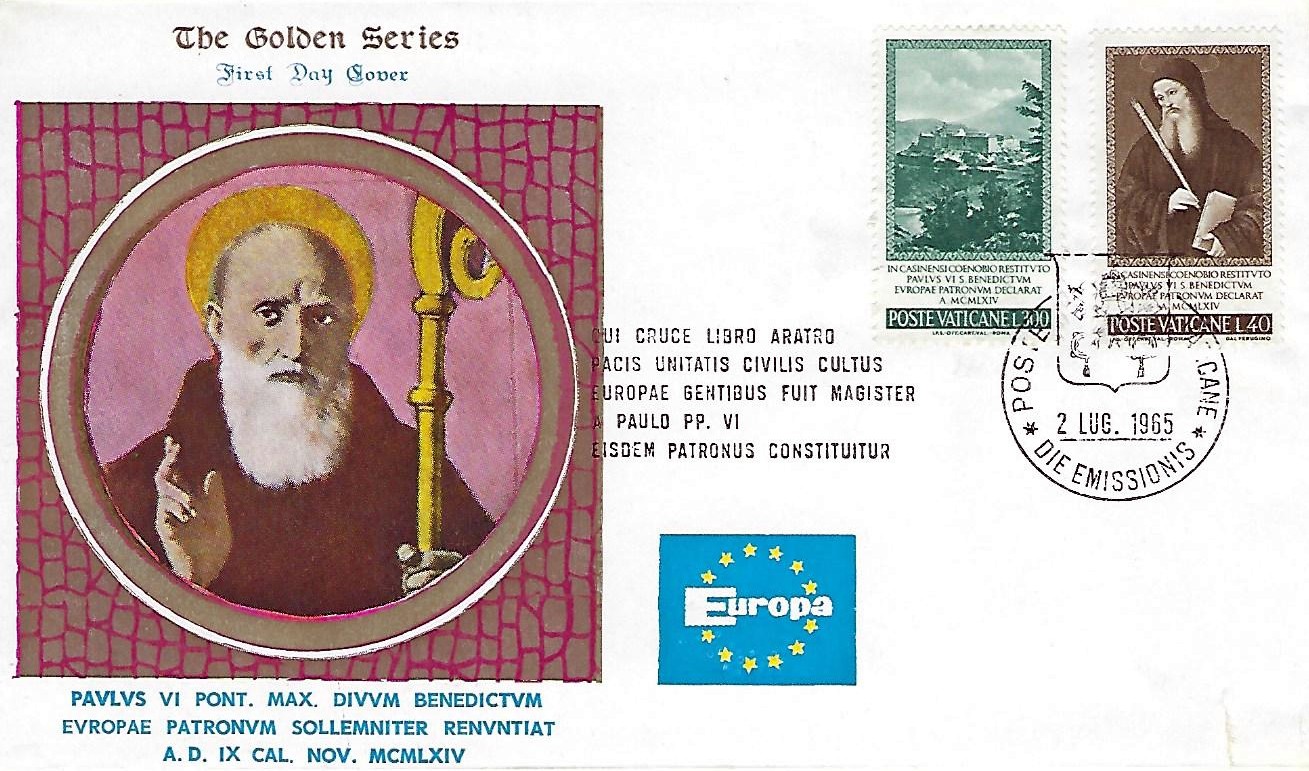









Christmas Issue 1965
The Christmas issue design for 1965 Is a composition by Casimira Dabrowska representing the Birth of Jesus Christ in a Peruvian setting with typical Indian costumes of Peru, the llama, the Andes, with the ruins of Macchu Picchu in the background. The Inscription NATIVITAS D.N.I. CHRISTI means Birth of Our Lord Jesus Christ, and the year in roman numerals MCMLXV - 1965
Comparing the photo of the original design by Miss Dabrowska, please note that halos have been added to the heads of the Christ Child, the Blessed Virgin Mary and St. Joseph, so that there will be no mistaking that the central trio is the Christmas scene (missed by the writer who reported these stamps in Linn's).
In the picture of the original design note the clarity of detail and the fineness of design which is true of all her paintings, but which is lost to a great extent in these stamps, as is true in most of her designs. The name of M. Colombsti, Engraver, has been added and Miss Dabrowska's name shortened to C. Dabrowska, and the I.P.S. inscription has been placed in the center. The stamps are engraved on paper watermarked crossed keys. Measuring the perforations we make its 20 L 13 1/2 x 13 1/2; 20 Log 13 1/2 x 14; L. 200 14 x 14.
Technical Details:
Scott Catalogue - 420 - 422
Date Issued - 25 November 1965
Face Value - 20 l, 40 l, 200 l
Perforations - 13.5x14
Printer - The Italian State Printing Works
(Author - Unknown, From Vatican Notes, Volume XIV, Number 5, March-April 1966, Page 7)
